one month in ecuador (march/april 2023)
this was my favorite country of the gap year! the people, the places, the culture. it's incredible, and i made memories here that i'll look back fondly on for my entire life.
After parting ways with Nick at Bogotá, I flew to Quito, excited for a month of solo travel! Ecuador was a really pleasant surprise. Because it’s such a small country, the itineraries that travelers follow are much more similar, allowing me to cross paths with the same people repeatedly and form deeper connections. Despite its small size, Ecuador offers an amazing variety of landscapes: the Amazonian jungle, the Galápagos Islands, the Quiloatoa Crater, and the volcanoes of Cotopaxi.
Ecuador ended up being one of my favorite countries from my gap year, along with Ireland and Japan, possibly because these three countries share a cultural appreciation for public baths.
In this post, I’ll recap my favorite places and memories of Ecuador. Let’s begin with Quito.
Quito
The late-night drive from the airport to Quito took an hour or so. You go through a smooth, newly opened expressway. The zen driver told me about his life in Quito and explained that the airport was moved farther away from the city around ten years ago due to noise and pollution problems. I spent a lot of the taxi ride in awe of the beautiful lights that illuminate the anti-erosion concrete barriers.
The Secret Garden Quito: This is a great place to stay if you’re visiting the Amazon and/or Cotopaxi. The hostel helps you pick from several Amazonian lodges, and buses will pick you up directly from the hostel. The Secret Garden has a great three day two night package for its Cotopaxi location, with free transportation between hostels included. In addition to this, they have a reliable taxi service with fair prices. I used the taxi a few times because locals warned us against walking alone in the city at night, even for a few blocks.
The hostel is huge, with volcanic rooftop views and many areas to explore. There are tons of common areas with couches, blankets, and ponchos. I noticed that several people (not sure they were even hostel guests lmao) would just sleep outside on these couches after a late night of partying.
Side Note: When I checked into the hostel dorm room at 12:30 am and couldn’t fall asleep for hours due to noisy roommates, I made the executive decision to change all of my remaining rooms in Ecuador from dorms to private rooms. The price went from around $10 a night to $25-$30, well worth the gained rest and sense of safety.
Exploring Quito was a bit of a challenge, because it gets a lot of rain. I had to wake up early and squeeze my plans into a three-hour window before the lunchtime downpour began. Plus, I only had two full days in the town before busing to the Amazon.
Casa Museo Guayasamín and La Capilla del Hombre: I hit these two museums first. They’re part of the same property, so your tickets include both museums. I’m a sucker for an artist house tour.
Casa Museo Guayasamín is the old home of indigneous Ecuadorian painter and sculptor Oswaldo Guayasamín Calero. He established the Fundación Guayasamín in 1977, and in the last years of his life, he donated his private art collection, along with his house, belongings and an extensive collection of his own work to the City of Quito. Today, these museums house the most complete collection of Guayasamín’s work. In his house, you can also find a stunning array of religious artifacts and iconography.
Oswaldo grew up in poverty after his mother’s tragic death. He started painting as a child, growing up during years marred by violence and injustice. You can see his growing rage come through in one of his early paintings, “The Dead Children,” which depicts corpses piled up on a street, including his best friend, who was killed by a stray bullet (reference). Moving forward, Guayasamin’s work takes a strong stance against acts of discrimination, cruelty, and injustice
His magnum opus is the Capilla del Hombre. It was his final work, a tribute to all humans. It depicts a history of human suffering and violence, especially colonized Latin America. He pulls back the curtain on the past suffering of humanity to inspire hope for peace, for a better future. An eternal flame in the center of the chapel shoots upward, a beacon. Across from the flame, one of Oswaldo’s quotes: “Mantengan encendida una luz que siempre voy a volver,” or "Keep a light burning for I will always return.”
Llamas at the Parque Metropolitano Guangüiltagua: After a moving tour and some silent time spent in contemplation, I left the museums and made a beeline for the park next door. I had heard that a pack of llamas roamed the grounds. My body was drained from the morning, but I needed to see these llamas. There were several viewpoints listed on the park map. Some guides told me to check out one viewpoint, but when I got there, no llamas were in sight. Locals were also searching for the llamas, including a mom and kids with many apple treats. We teamed up to track the herd of 15 llamas down, finally finding them closer to some wooden play structures. The llama family was chilling in the grass, eating and playing with each other. Quite the worthwhile endeavor.
A scattering of yummy food:
Pacari Chocolate: I grabbed several award-winning bars to eat and as gifts. Pacari has won over 300 international chocolate awards!! I loved the creative flavors, including Andean Rose, Cardamom, and Passionfruit.
Govindas: I found this spot on Happy Cow. The vegan restaurant is run by the Hare Krishna, located inside of the Hare Krishna cultural center. Lunch costs around $3 for a heaping serving. After you eat, you can explore the worship rooms. There are also frequent community yoga classes, and you can volunteer to distribute free food to the community. I played with two sleepy brother cats hanging out in a cardboard box while the chef warned me about the two remaining uncontacted Ecuadorian tribes in the Amazon, who may be cannibals?
Uku Pacha: On my last night, I grabbed dinner at Uku Pacha, which serves a five-course tasting menu for just $30!! I tried Canelazo, a warm alcoholic drink made from cinnamon, brown sugar, and cloves. Every course was fantastic, except for the guinea pig dish. I couldn’t stomach more than a few bites: the texture was rubbery and stuck to my teeth, and the taste was game-y. It made me nauseous thinking of my friends with pet guinea pigs. Of the travelers I asked, around half are fans of guinea pigs and half can’t handle it. I felt guilty for wasting it, but I had to give up. Luckily, the restaurant’s dog was happy to eat it. The staff there were interesting people to talk to. One of the lady chefs lit some palo santo to warm up the place and cleanse the area. She told me about traditions unique to Ecuador, like how people will leave a bouquet in the base of a house when constructing it, in order to honor spirits.
The Amazon
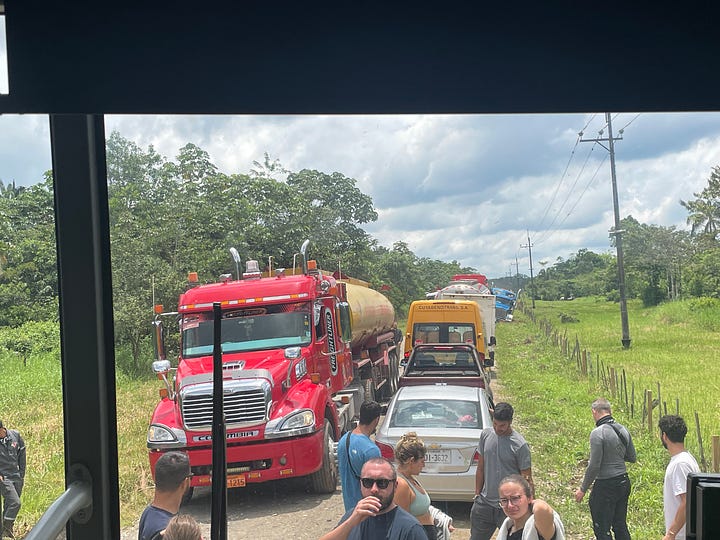
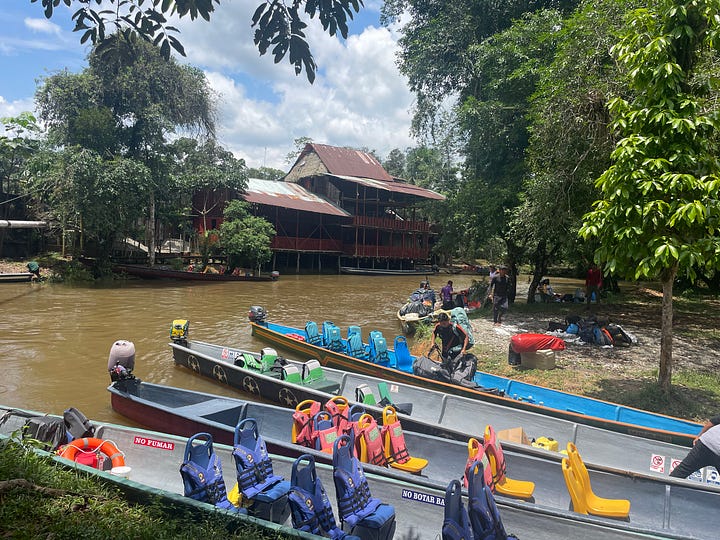
After two days in Quito, I took a 10-hour overnight tourist bus from Quito to the Cuyabeno River bridge, which is the entrance to the Cuyabeno Wildlife Reserve in the Ecuadorian Amazon. It’s possible to take a public bus from the terminal as well, but it’s more secure to take the tourist bus, especially so you can spend the night sleeping instead of watching over your things. The buses pick up people going to any of the Amazon lodges, and you get sorted by accommodation once you get to the park entrance. It’s important to note that these buses only depart from Quito a few days per week! The bus pulled up to the hostel pretty late, but it was a great chance to connect to the other hostel guests.
From the bridge, I took a 2-hour motorized canoe ride to my lodge, the Nicky Lodge. People will usually stay in the Amazon for 3-5 days. I stayed for five days, to give myself time to recover from the draining bus rides. The five day option gives you three full days in the Amazon, plus two days that are half transit.
I chose to stay at the Nicky Lodge because it had overwhelmingly positive reviews online, and I had met travelers in Colombia who enjoyed their time there. I was seeking more of a tranquil, restorative vibe. The majority of people in my bus chose the Tucan Eco Lodge, which had a younger, hostel vibe. They really enjoyed it, and I think I would have liked staying there too, but I really appreciated Nicky’s peace and quiet. Plus, I came to Nicky Lodge during a less busy week, so I got a private room for the price of a shared room!
In a typical day, we would:
wake up early for an optional river boat trip to spot animals
eat breakfast
morning activity
lunch, siesta + snack time
afternoon activity
dinner
night activity
There were between 7-14 of us staying at the lodge at a time. Guests came and went every few days, so you got to know people better. One guest was Ben Stookesberry, adventure kayaker and 2007 Nat Geo adventurer of the year. He came with his mom Betty, who told me about her amazing days as a Pan Am flight attendant, traveling the world. There were several delightful German and Dutch people my age.
There was also Neil, an unsavory, but entertaining, fellow American. We shared the two-hour kayak ride to the lodge. He loved loudly comparing the wildlife we spotted to genitalia and bodily excretions. His favorite was the candiru, also known as the penis fish, which calls the Amazon its home and can swim up the urethra and permanently lodge itself to gorge on blood. A close second: the penis tree. He hated physical exertion, which meant that our group almost always got to use the motorized canoe. Neil and I shared a wall in our thatched-roof cabaña, along with some special moments when we were using our bathrooms at the same time (you can hear everything).
Our main guide, Evi, was fascinating. He was the only guide in the Amazon from Bangladesh. He arrived in 2008 after watching many nature documentaries about the Amazon, deciding to learn Spanish and work his way up from busboy at a lodge to certified guide. He’s married to another Bangladeshi woman, whose family also immigrated to Ecuador, and he sees her every few weeks. He’s Muslim, and he shared how he fits in praying five times a day while leading tour groups through such a chock-full schedule.
On our daytime canoe trips, Evi introduced us to a delightful cast of characters. My $25 binoculars weren’t the best for spotting creatures sixty feet up in the trees along the river, but one person in our group captured some fantastic photos.
After long days of adventure, guides from all the respective lodges brought us to the Laguna Grande. They encouraged us to jump in; here, we were safe from the reaches of the penis fish. The water in the Amazon felt warm and buttery. It was easy to lose track of time swimming in here, watching the pinks of the sunset through the branches of the water trees with dozens of strangers. In the dry season, a lot water dries up, and the lodges will play soccer games in the mud.

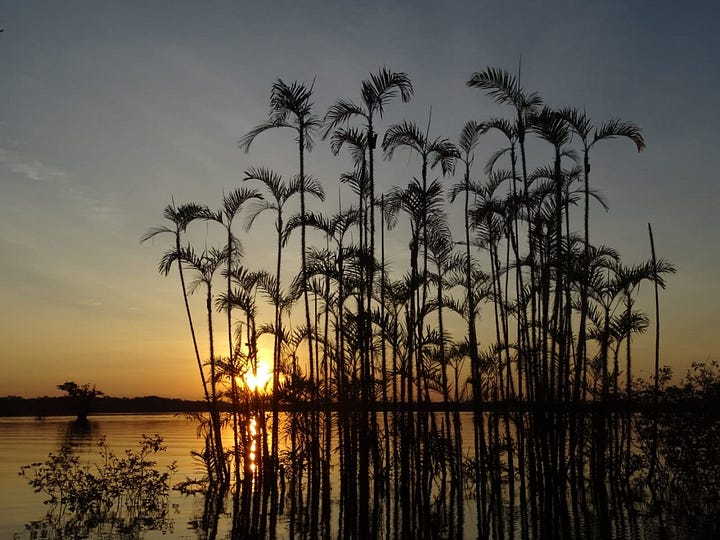
We learned that Ecuador is #3 in the world for birds, despite having just 2% of the Amazon rain forest. There are at least 648 species of birds in the Cuyabeno preserve alone. The Russet-Backed Oropendula, whose call sounds like a large water droplet falling into a deep pool. The mysterious silhouette of a toucan. The Greater Ani bird, which sounds like a boiling pot of pasta when in a large group. The Ani birds have communal nests, with 10-15 birds building a nest together and taking care of everyone’s kids. They even collaborate with another species: the squirrel monkeys. The monkeys help catch insects, while the Ani warns the monkeys of predators. And then there’s the Hoatzin bird, shaped like a chicken and able to climb. It’s also known as the stinkbird, due to its cow manure breath. “It’s the only bird that is a foregut fermenter. It eats only leaves, which are broken down in a crop - an anatomical structure for storing food and for fermentation due to bacteria.”


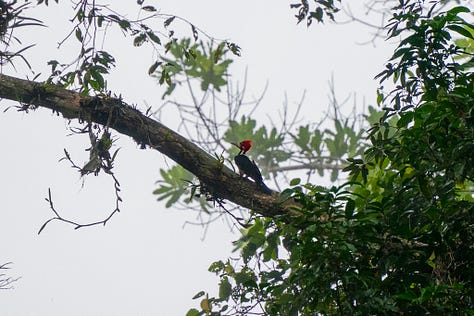
And of course, we saw so many MONKEYS. Black saki monkey, nomadic wooly monkey tribes, red howler monkeys carrying babies, flying monkeys. The pygmy marmoset, which is the smallest monkey in the WORLD.
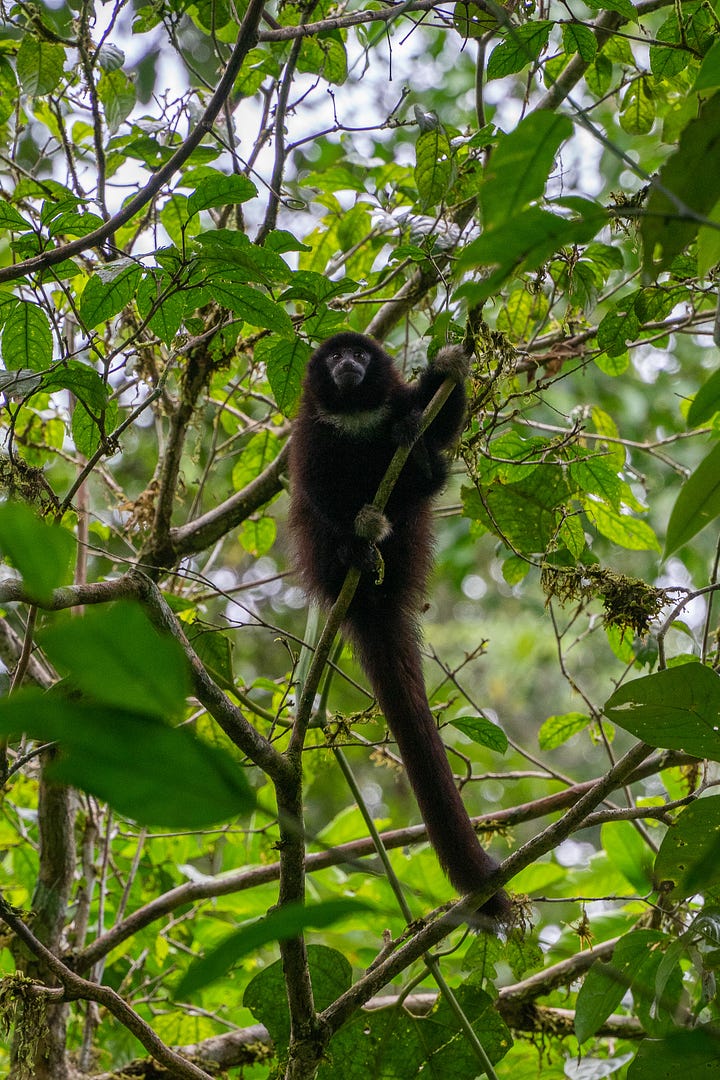
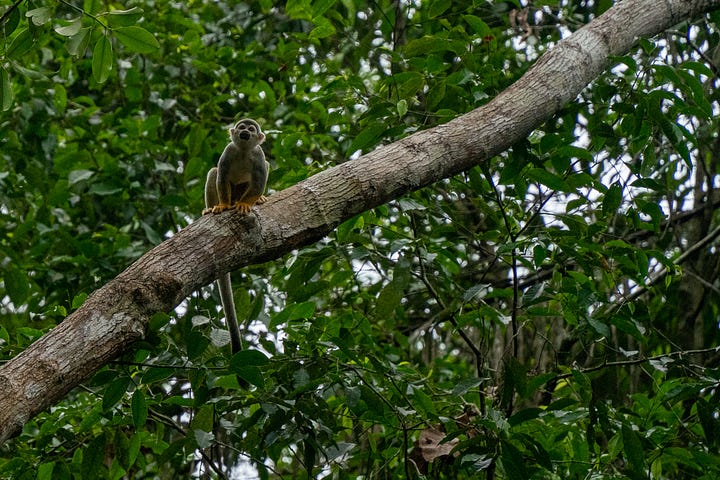
Fascinating creatures lurked beneath the murky waters. Pink Amazon river dolphins popped up next to our canoes to say hi. Once it got dark, we’d bring headlamps and wave them at the shore to catch the flicker of eyes: red meant cayman; green, snake; orange, mammal or bird. On an afternoon in between tour groups, Evi took me on a canoe trip. A massive arapaima, of River Monster fame, surfaced for air right next to us, rocking us back and forth. Here’s a video of what they look like.
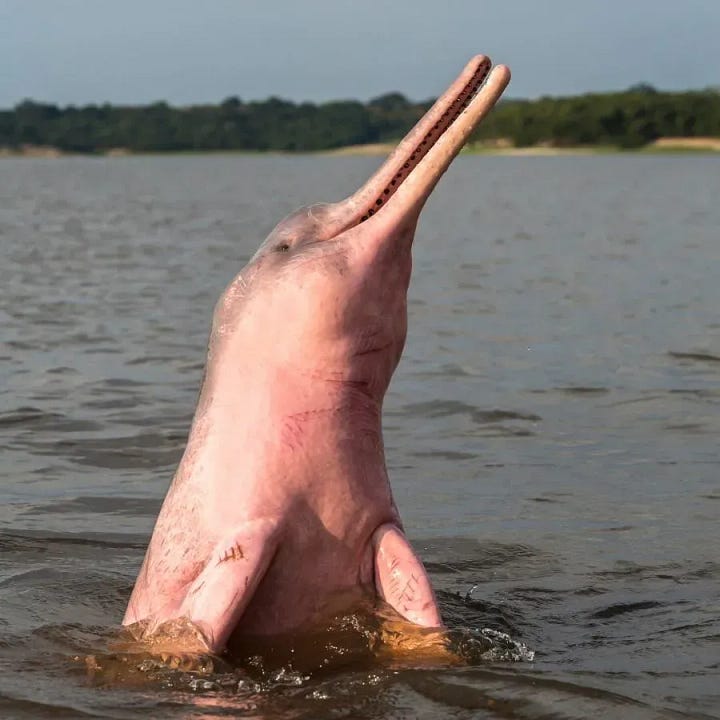

One of my favorite parts of the trip was getting to visit the indigenous Siona community. Mama Aurora, the first tour guide in the Cuyabeno, took us around barefoot. She was the matriarch of the village, the first in four generations of guides. People estimate that she is 90-95 years old, and that her husband is 105. All the lodges in the Cuyabeno belong to the Shiona people, including the canoes. Every month, the lodges pay $700 for land and $100 per canoe.
The Shiona families share their earnings and use it well. They’ve upgraded to fiber glass canoes with engines to reduce labor, and metal roofs instead of palm roofs, installed satellite systems for communication with tourists, cleaned their water supply, and sent their kids to better schools. They manage the use of the land, preventing tourists from eating food from the river that is in limited supply (300+ fish species live in the water!). They protect many lagunas from interference. Some are used by animals to reproduce, and legend says that tribes live in some of the lagunas underwater.
Mama Aurora told us of the days before tourism came in the 1970s, when jaguars hunted the caymans in the water and anacondas ate villagers alive. Now, the animals aren’t so out in the open. Still, the Amazon is a very difficult place to make a life. Both boys and girls must learn how to hunt and survive on their own at eight years old. Just a few months ago, two young boys under 18 had been killed by a jaguar while out hunting. It can take journeys of hours or even days to get supplies.
Mama took us on a walk to try the fruits special to the Amazon: the Inca peanut, Amazonian lychee, the cocona (taste is between a tomato and a lemon), the bacaba (a hard fruit that people use to make wine). She showed us how she uses plants in the area, like the nettle: its roots can be fashioned into fish bait, its leaves for the stomach, and its spike for muscle aches.
At the end of the walk, we shifted into yucca-bread-making mode. She showed us how to pull yucca roots out from the soil. The trunk would be replanted for later use, and the leftovers from the process would be used to make side dishes. After removing the brown skin, we grated the root into a wood vessel and patted it into palm leaves to wring out the liquid. Once we sifted it, we had a flour that we could use to make bread. Mama Aurora cooked everyone the bread on pans that were made 40-50 years ago with clay from the river. She served a delicious spread sweet and salty spreads to eat with the bread, including neapia (black chili) made from yucca juice and peppers.
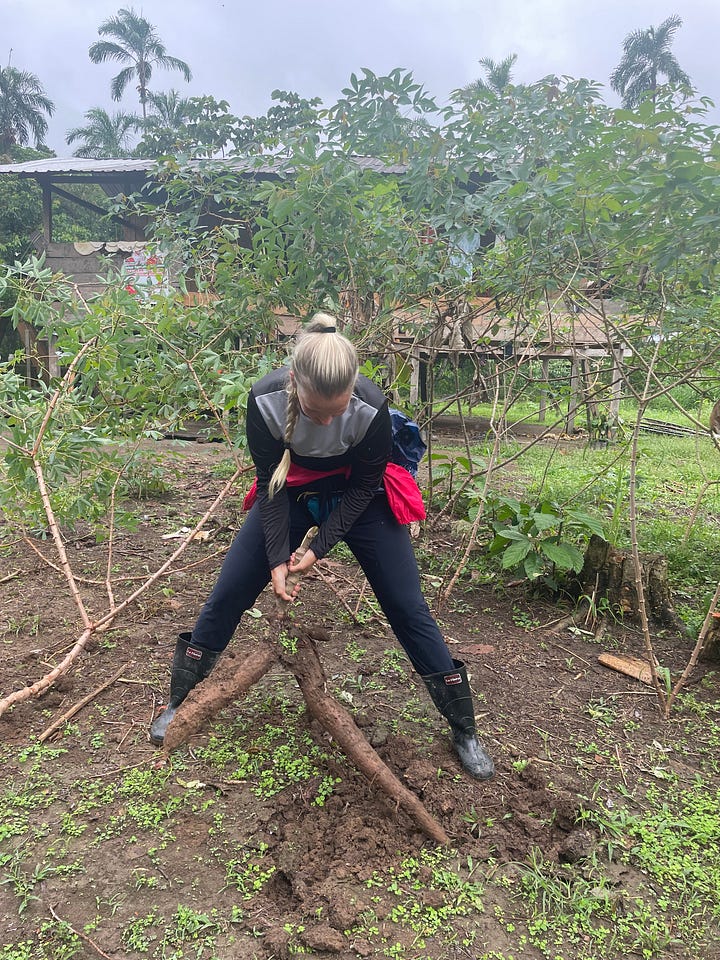
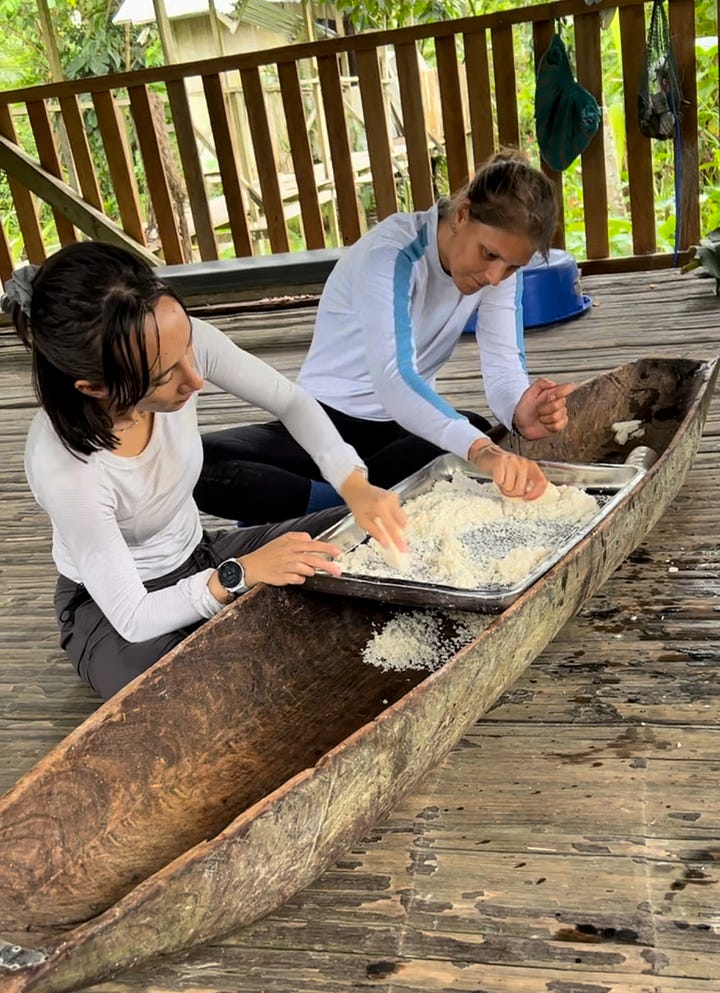
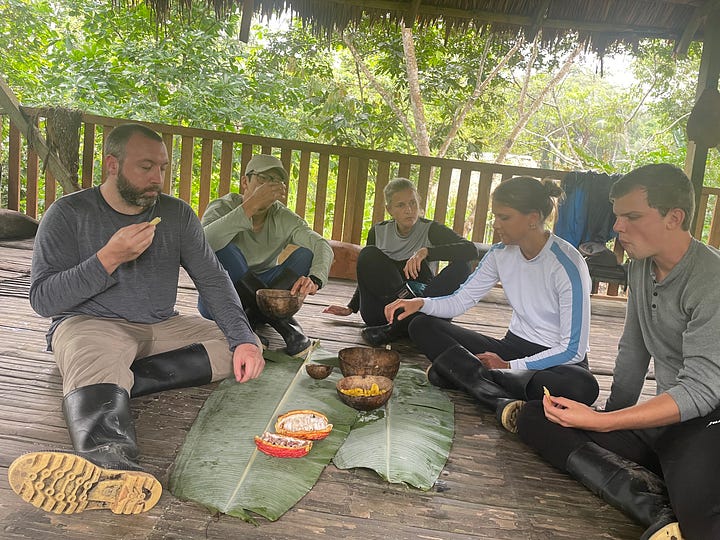
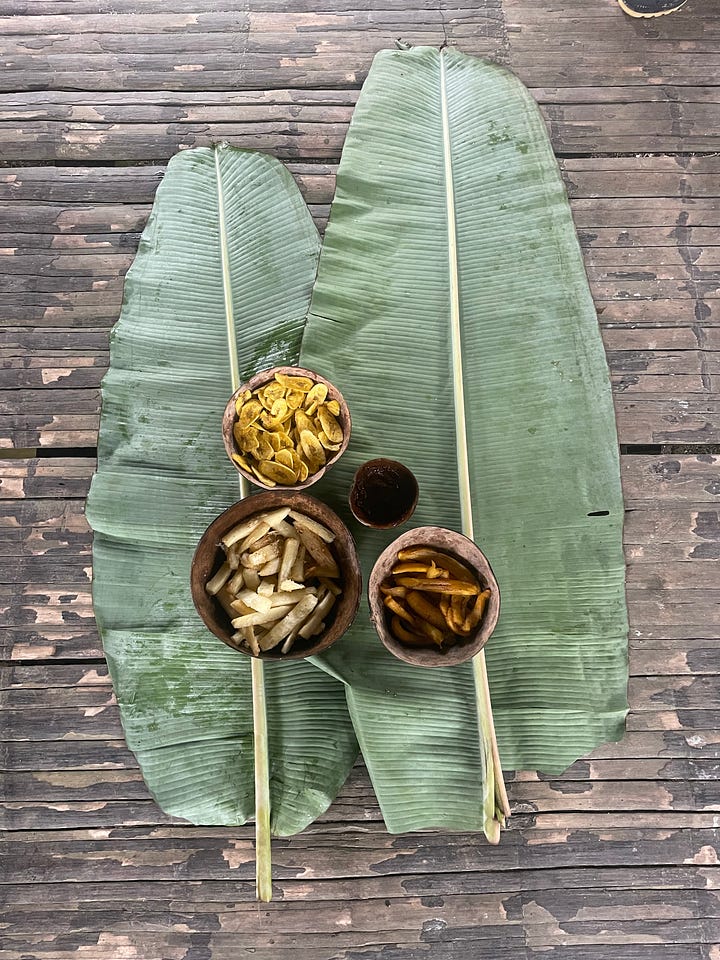
Seeing the beautiful legacy and community that Mama Aurora had created here and shared so openly, I could appreciate the meaning of Cuyabeno in the Siona-Secoya language: “kindness river.”

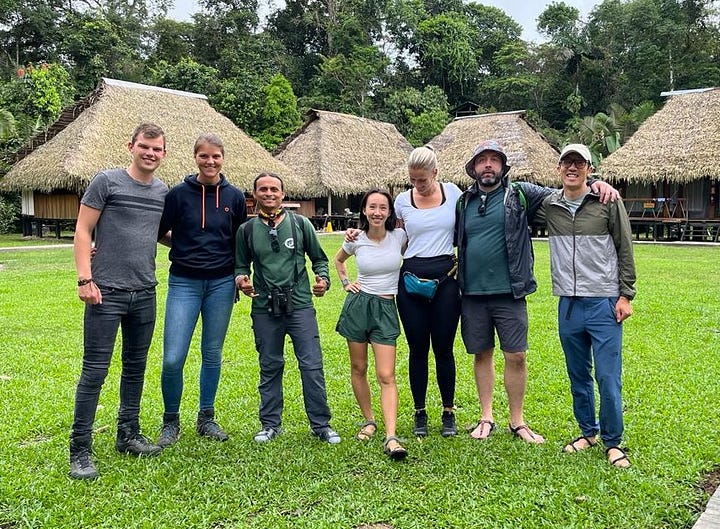
Mindo
From Quito, I took a two-hour bus to Mindo, the bird paradise. The main objective of this stop was seeing, you guessed it, lots of cool birds.
On my first day, though, I mainly rested from the jam-packed Amazon trip. I stopped by a woman’s house, which is part lodging and part orchid garden, for a short tour. The variety was impressive. Some orchids were so tiny that we had to stare at them through a magnifying glass. Others were hiding under leaves or camouflaged as plants.
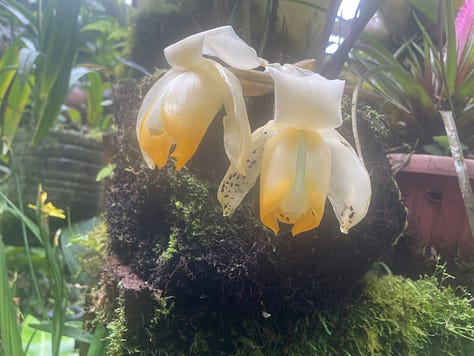
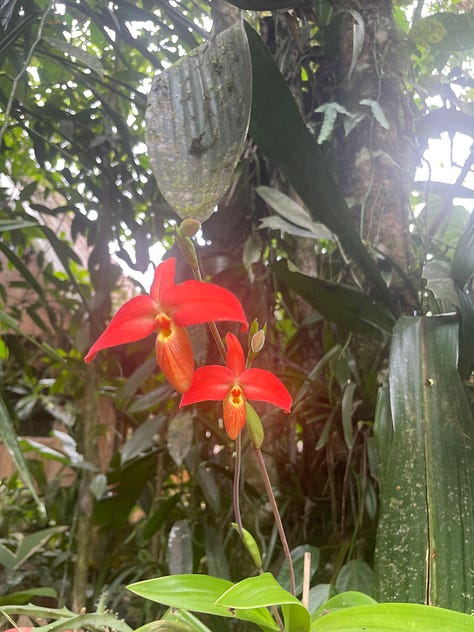
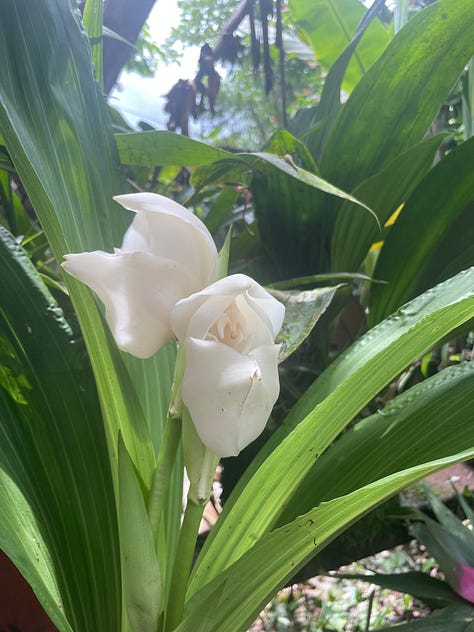
I fueled up with a pan of unbelievable gnocchi au gratin with rosa sauce from an Italian restaurant called La Mecha the night before. I hired a private guide from Mindo Bird Paradise Tours to take me to the Birdwatchers House at 5:15 am. Right when we arrived, I saw a toucan up close eating bananas, along with two brilliantly clored small birds. We walked between the main house and another viewing spot, where we watched the giant antpitta bird eating worms. My guide Sandy took tons of videos and pictures on my phone using a monocle tool. We finished with a yummy breakfast including fresh mozzarella cheese and homemade marmalade.

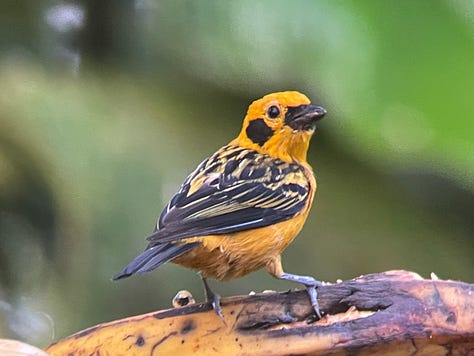
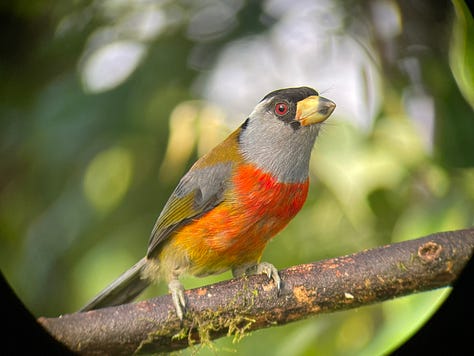
I spent the rest of the day chilling in the hammocks of my hostel, listening to the river and playing with the owners’ dogs. I wrapped up with a delicious vegan mushroom encocado for lunch at Mishqui, then headed back to Quito for one last night.
Cotopaxi
The Secret Garden hostel in Cotopaxi was one of legends. Friends posted it on their Story, bloggers hyped it up, and it could be found on all the forums. What was it about this place, a haven tucked away in the mountains? From the first few minutes on the property, I understood why.
Because the hostel offered a package deal with included activities for staying more than two nights, little communities formed over a short period. It also helped that there’s no wifi at all in the hostel. We chatted and played board games (mainly the Dutch dice game Qwixxz that Jasmijn and Tom brought) over a continuous supply of banana bread and tea. There was a massive hammock outside that could fit 6-8 people (plus the 16-year-old weiner dog Mash), and a jacuzzi in a converted greenhouse. We ate communal dinners. One of my favorites was a traditional Ecuadorian potato soup with avocado, cheese, and additional potato inside, called locro de papa!
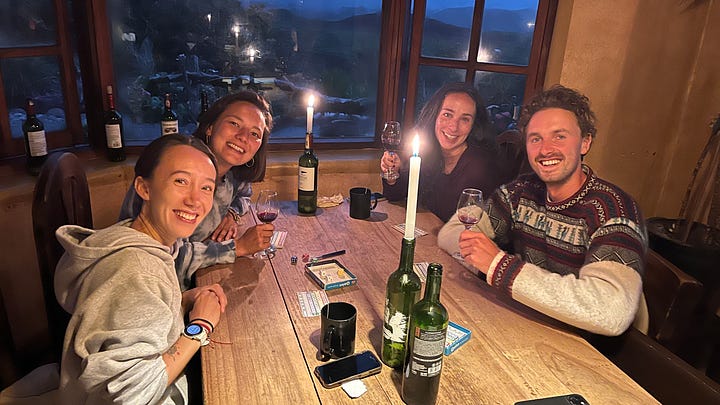
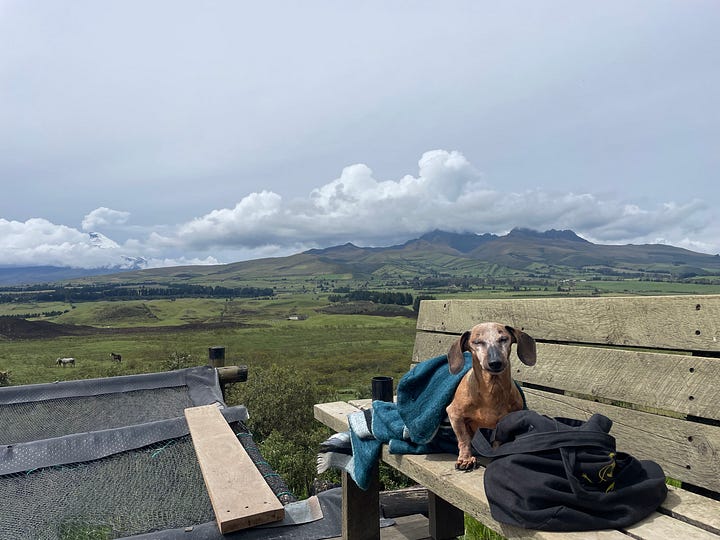
The sleeping situation was great too. We slept together in cozy cabins with big beds and soft blankets. Every night, the staff set up fires in each room to keep us warm.
The Secret Garden provided many spaces for solo relaxation as well. I spent hours reading in the hammocks in the sun-drenched entryway. Views of the valley, the Cotopaxi Volcano, and roaming wild horses were everywhere. Anyone could grab a banana and take it outside to feed to the llamas.
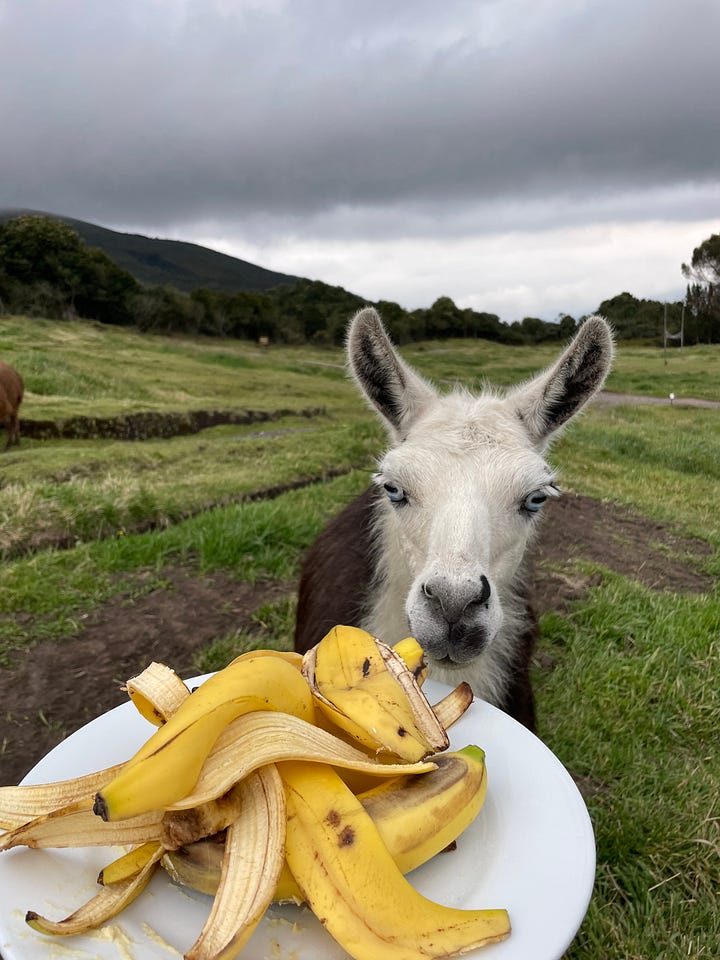
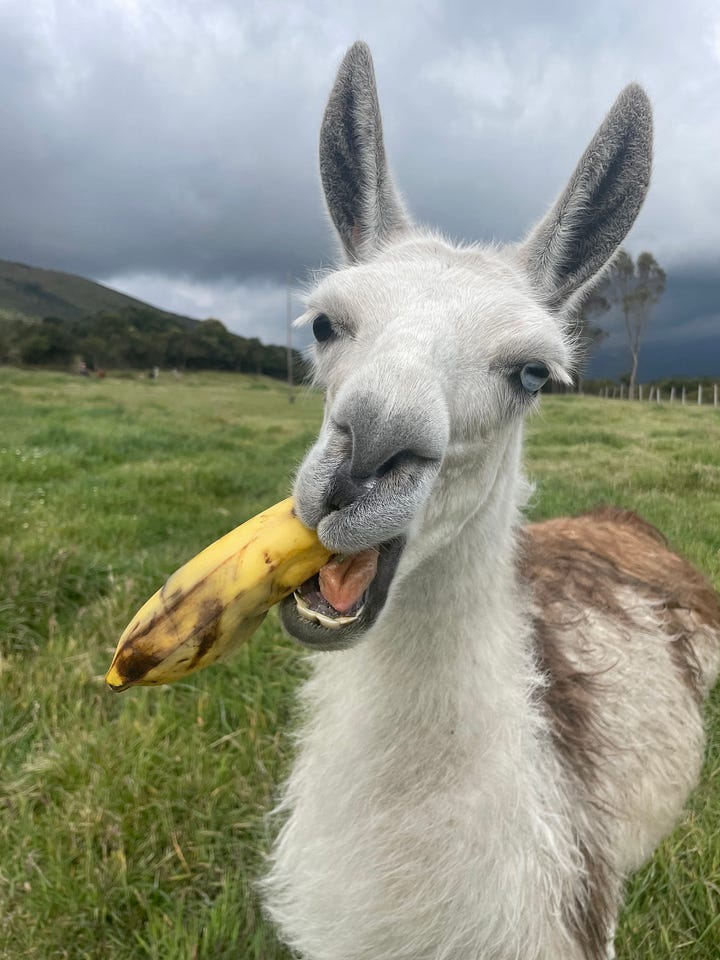
In the mornings, we’d go out on activities, and then we’d relax in the afternoon. On the first day, I joined an 8-mile hike to the summit of the extinct volcano Pasochoa. Several dogs from the hostel joined us, darting around and chasing the cows. We ate delicious poppyseed cake at the top and nibbled on morteño berries from the bushes. The next day, we went on a wild horseback tour in the high Andean plains around the Cotopaxi Volcano. My favorite part was galloping around while watching a group of wild horses on the move in the distance.
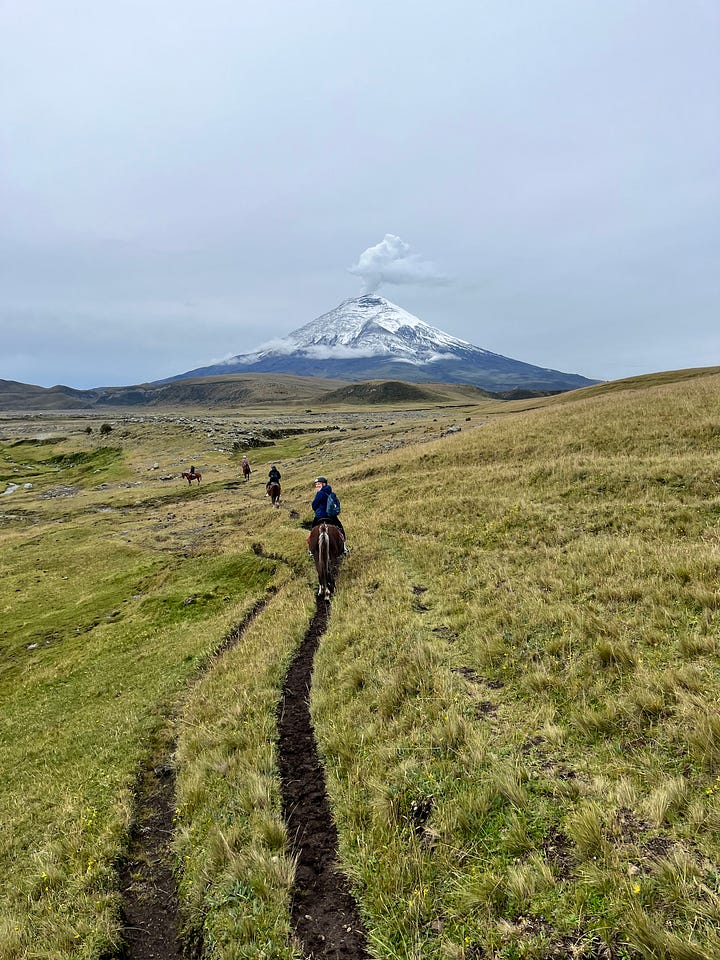
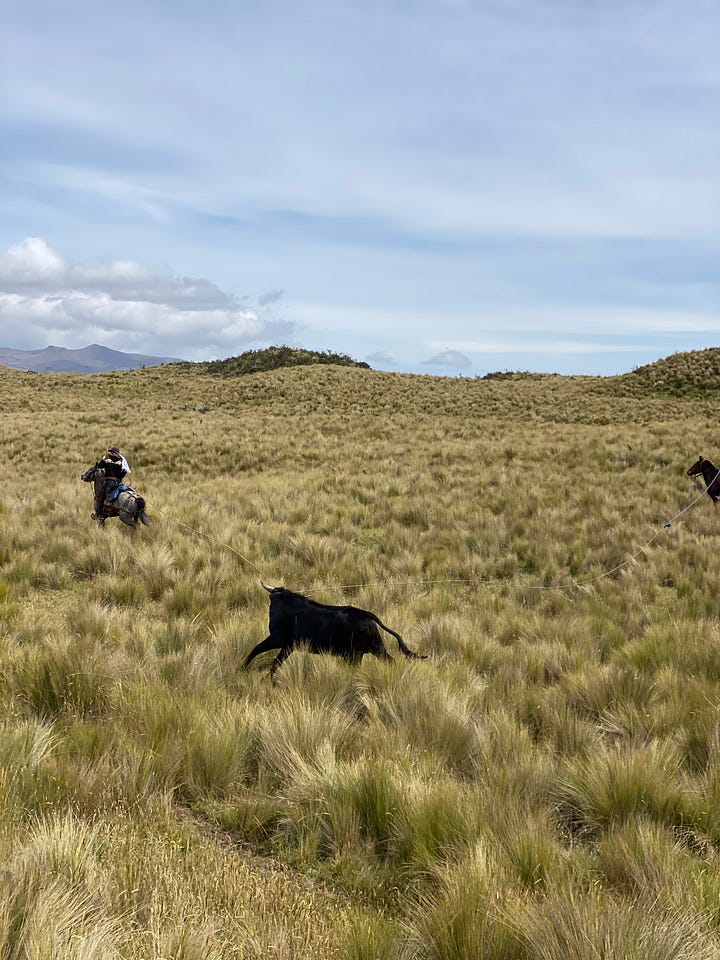
I was surprised by how quickly I became comfortable in this space, and how deeply I connected with the people I met here. It was truly magical.
Hiking the Quiloatoa Loop
Secret Garden offers shuttles to get out of Cotopaxi, so it was easy to catch one to Latacunga for the next leg of my journey.
The Quiloatoa Loop is a multi-day village-to-village trek to the Quiloatoa Crater. I planned my route with the help of a guide created by the Llullu Llama Mountain Lodge. To give myself a balance between relaxation and activity, I went with this itinerary:
Day 1: Take a bus from Latacunga to Sigchos, hike to Ilisnivi and stay at Llullu Llama
Day 2: Relax at Llulu Llama
Day 3: Hike to Chugchilan and stay at the Black Sheep Inn
Day 4: Hike to the rim of the Quiloatoa Crater Lake
Day 5: Take the bus from Chugchilan to Baños
The night before my journey, I had dinner at Kipi, which offers a vegetarian set meal. I loved the yummy soup and main plate with pineapple juice on the side. After we finished eating, the owner taught me and the other diners, a French couple, about the Andean New Year that was happening that day. On this day, people bring flowers to honor the Spring Equinox.
He said that Andeans think there is no past or future, just the present. Then, he described the story of the genesis of Andean culture. He explained that the symbol on the mugs in his restaurant was the Chakana, the Incan cross. It symbolizes the dynamic between the universe and the life it contains, which the three steps of each corner believed to have a meaning.
The next morning, I set out, grabbing an early bus to Sigchos. The hike on the first day was a good warmup. We passed bridges and animals, streams and greenery. There was a challenging segment in the second part, but the bag of beans, onions, and spices that my hiking buddy Heke shared helped us get through it.
Once I made it to Lllullu Llama, I immediately signed up for the sauna. There’s a path from the main lodge to the spa, which has two saunas and a jacuzzi. I was surprised to find two friends from the Amazon waiting for me in the jacuzzi!! Between sauna rounds, I stood outside in the misty rain to cool off.
Like Secret Garden, Llullu Llama also offered family style dinners. They arranged name cards for each guest and randomized where we sat each night. I made more friends with a couple Gita and Issac, who I had also first met in the Amazon.
I spent one more day at Llullu Llama to read, stretch, and chill. In the morning, I went on a short run through the village, passing by a dog guiding many sheep along a single-track path. I climbed up to a viewpoint, then spent the rest of the day back at the lodge.

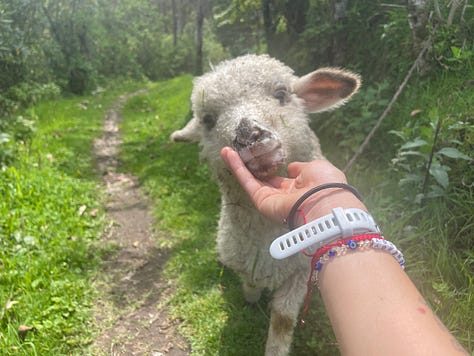
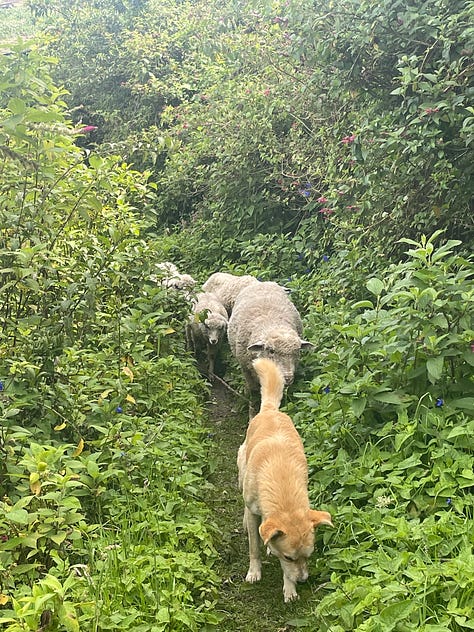
On the second big hiking day, I was happy to hike alone for most of it. The weather was cool, misty, mysterious. I loved crossing a log bridge and getting to climb up the viewpoint towers. After one tower, a sweet dog with a makeshift split on its front leg started hopping with me all the way up a steep hill.
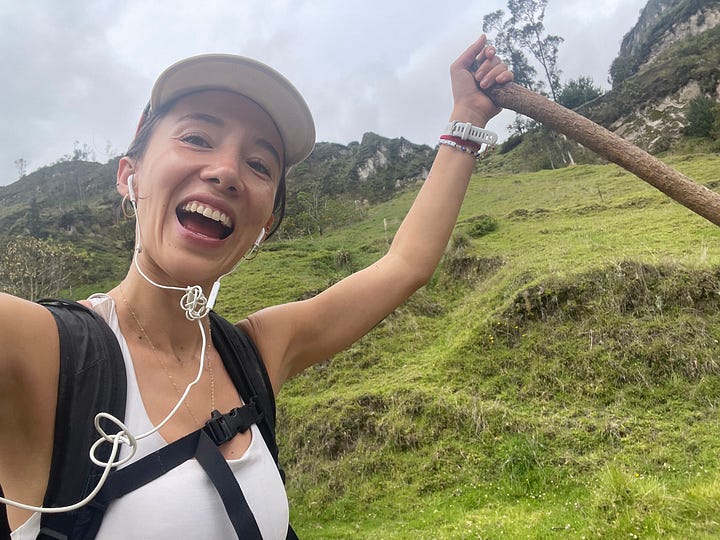
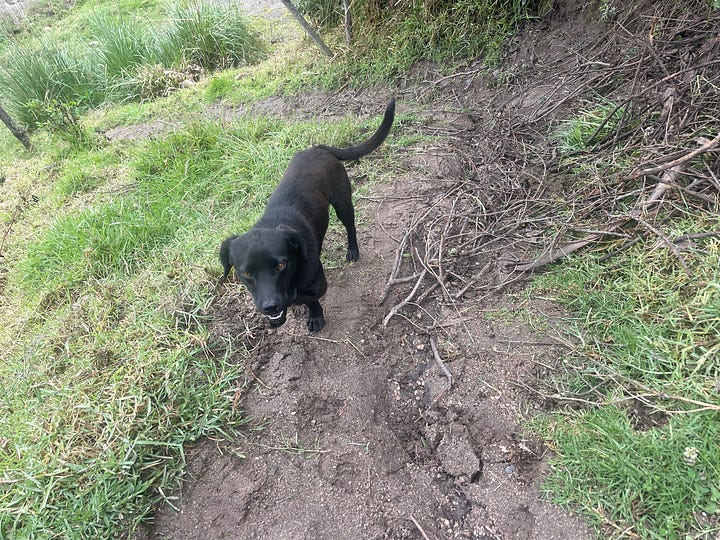
I made it to the Black Sheep Inn before the rain got too heavy. They gave me some welcome treats while I warmed up in front of the wood stove. I bought an alpaca sweater from a man selling gear, and he gifted me a llama key chain! After meeting my bunkmates Matthias and Yvette, who were biking from Colombia to Argentina over a year, and taking a warm shower, I explored the property.
I picked this inn because of its ecological philosophy. It has composting toilets, solar and wind power, and practices other sustainable techniques. In the area, it provides environmental education and protects the Iliniza Ecological Reserve.
The Black Sheep Inn also has several sheep and alpacas :). An employee brought me to see them, handing me a tray of salt to feed them. They ended up snorting and sneezing it more than actually eating it. While feeding a pair, I didn’t realize that two others had escaped out of the gate. With several employees, we managed to herd them back into their enclosure. After, they let me feed a nice pig my leftovers.
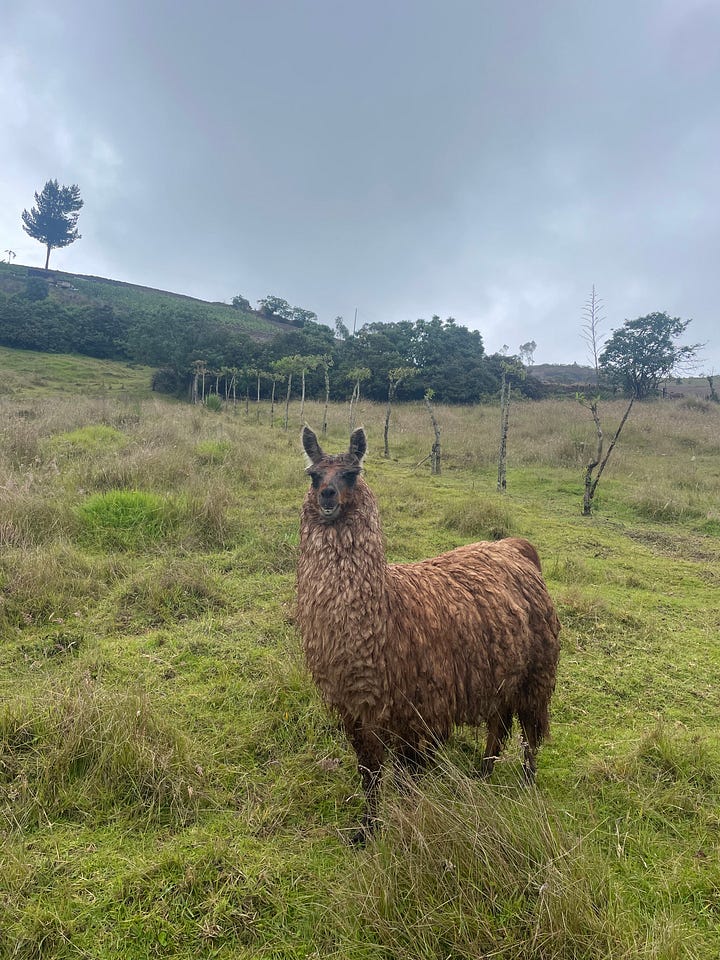
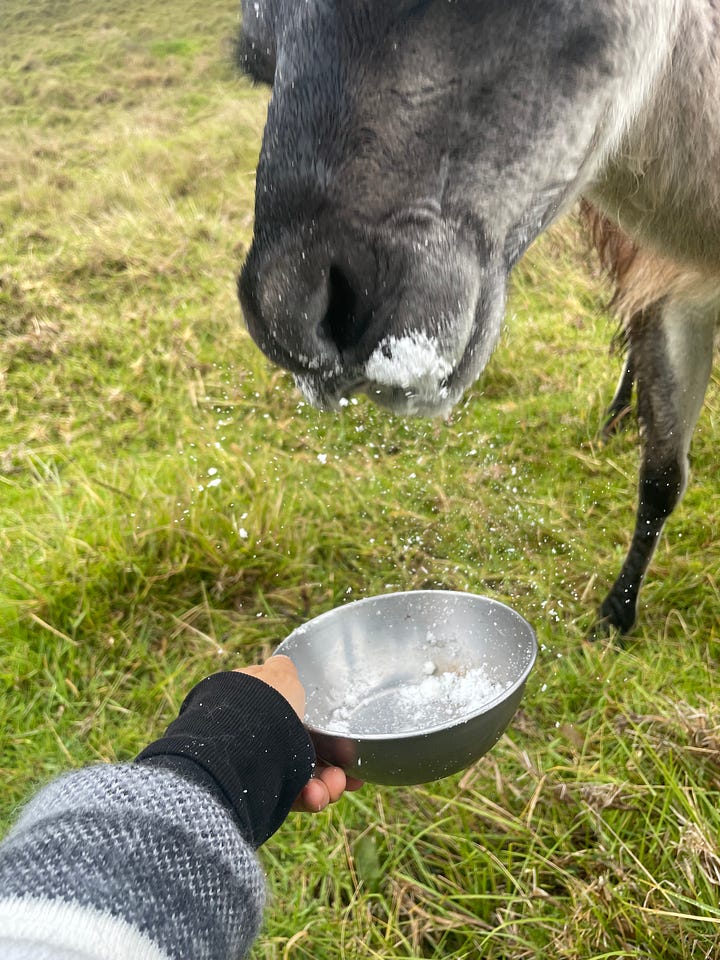
The family dinners here were so lovely. Since we were only nine people, we shared one long table. We talked for hours over lasagna and delicious vegetable soup. The manager was asleep, but when he woke up, he randomly handed us free bottles of wine
.The next morning, a group of us left early for the Crater to try to avoid the fog. Although we had to climb a lot, we were rewarded with many cute sheep and dogs lying amongst the flowers. A bag of popcorn and a cute kitty motivated us to finish the last climb to the top of the crater. From here, we walked up and down along the rim to reach the town in Quiloatoa. We felt so lucky to see the whole lake without fog!
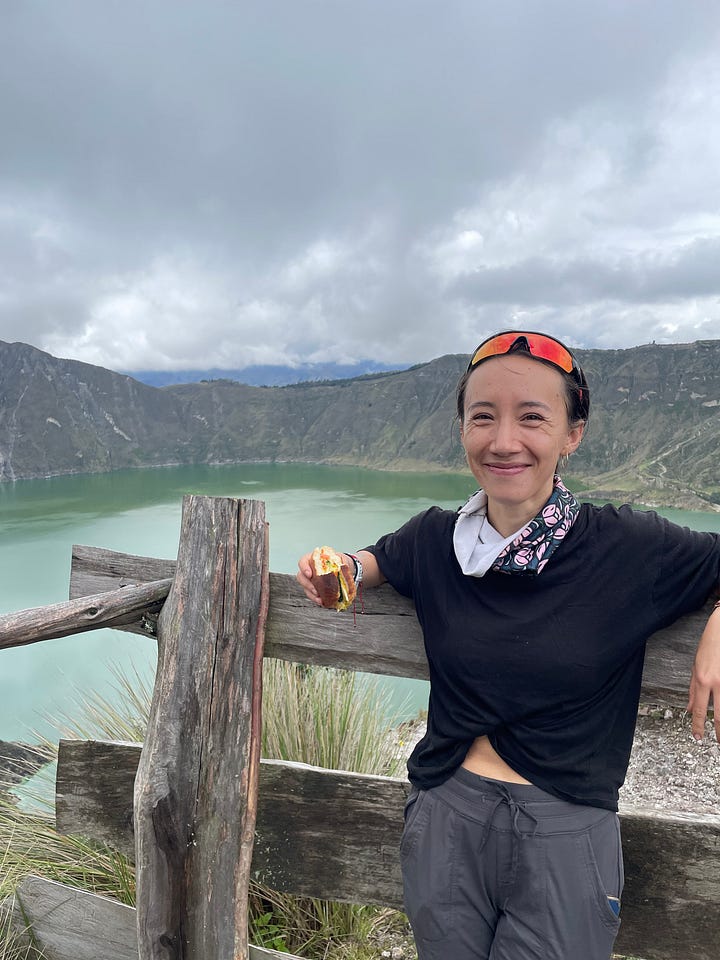
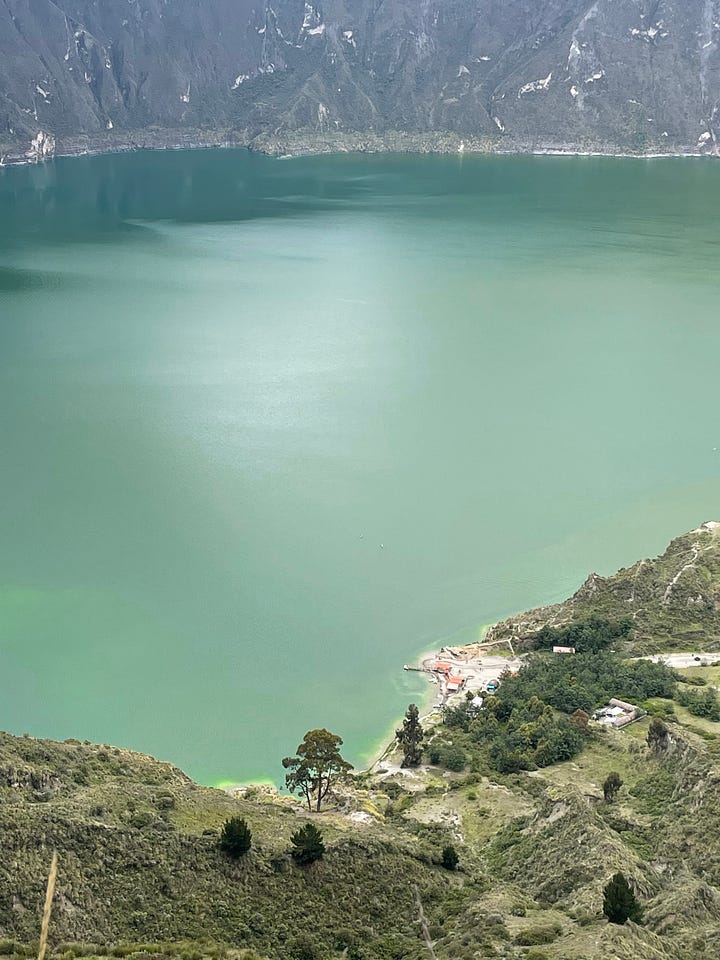
Once back at the inn, we hung out in the sauna to recover. I bought a mug as a keepsake and drank some tea while reading in the cozy nook upstairs. On our last morning, we took part in the inn’s Sunday pancake and jazz breakfast. The syrup was yummy, made from canela.
After checking out, we went to the town market and waited for a bus to Latacunga, but it never came! It turned out there had been a landslide that morning, so no buses were coming from one direction. So, he brought us to an intermediate town in his car where buses came more frequently. Thanks to his help, the rest of the trip to Latacunga was smooth sailing. I grabbed the rest of my luggage from my hotel, then took a short taxi to the highway to catch a bus on the way from Quito to Baños. It seemed very sketchy, but the locals were very helpful.
Baños
Baños! The town of adventure activities, like rafting! I was too scared to raft. But I was ready to go to all of Baños’ public hot springs. Taking a bath is in fact the only significant activity that I did here. I spent the rest of my time calling my career coach and preparing documents for job applications.
Tom, Jasmijn, and I went to La Piscina de la Virgen. The first pool area we found was closed for cleaning. There was a guy draining the pools with the song Shower by Becky G on blast, what a bop. The basement of the pool was also closed. It smelled musty and had a green tint to it. We finally found the correct entrance. The bath was already bustling with patrons.
We rented bathing cap, rinsed off, and were ready to go! There was a cold pool, a medium pool, and a hot pool on the top level, with a few more pools on the bottom floor. Some dudes in Speedos would do exercise routines in between sessions in the pool. Although some pools were a little dirty (one old man’s booger was dangerously close to falling out of his nose), it was really fun to hang out with the locals. To conclude our visit, we received $1 clay face masks at the on-site mini spa and sat around waiting for them to dry, taking in the scene.
Oh, and another cool part of Baños was the very overweight dog at my hostel.
Cuenca
The journey from Baños to Cuenca takes 11 hours, but I think that it’s worth the wait. I booked a private room in a fancy modern hostel called Guellerminas. The warm lighting and soft bed were such a comfort after the long bus ride. I stayed here for three nights, and we had so many adventures here. On the first night, we were surprised by how lively the streets were. People were playing music and strolling through the plazas. It felt like a European town.
Before the morning walking tour, we came across a row of goats in the plaza. You could pay their owner to squeeze a cup of fresh milk. He let us take pictures with them.
Our guide was a fascinating 20-year-old sociology student studying gender violence against women in Cuenca. She taught us about the student protest against the government happening that day because the president was trying to privatize public universities. We also learned about the gentrification in Cuenca compared to the rest of Ecuador, and the growing feminist movement in Cuenca.
She walked us through the giant cathedral, which is actually the largest cathedral in Latin America. Its construction began in 1825. Fun fact: it doesn’t have any bells because the architect messed up, so its structure can’t support the weight of a bell.
While we were on the roof, a children’s choir came through. They were visiting from Guayaquil for a tour. We asked them if they could sing a song for us, and they surprisingly agreed! After a group of elementary school kids came in, the choir turned it into a mini-concert. They even dedicated a song to the kids.
Another cool area was the “Plaza de Flores.” Ecuador has the best altitude for roses in the world. The Carmen de la Asunción Monastery was tucked in next to the market, with a line of people waiting to buy agua de pitimas, a drink made by the nuns who lives inside the cloisters. The drink is made of many flowers and is said to cure all ailments. When we drank it, we made a wish! I wished to get a job in climate that I would love, and it came true :)! The drink was light and delicious. I wanted more, but never came back.
After the tour, we followed our guide’s recommendation to eat lunch at the 10 de Agosto market at Doña Elsita’s world-famous hornado stall. She’s been making this stuff since 1960. The plate looks simple, but it tasted incredible.
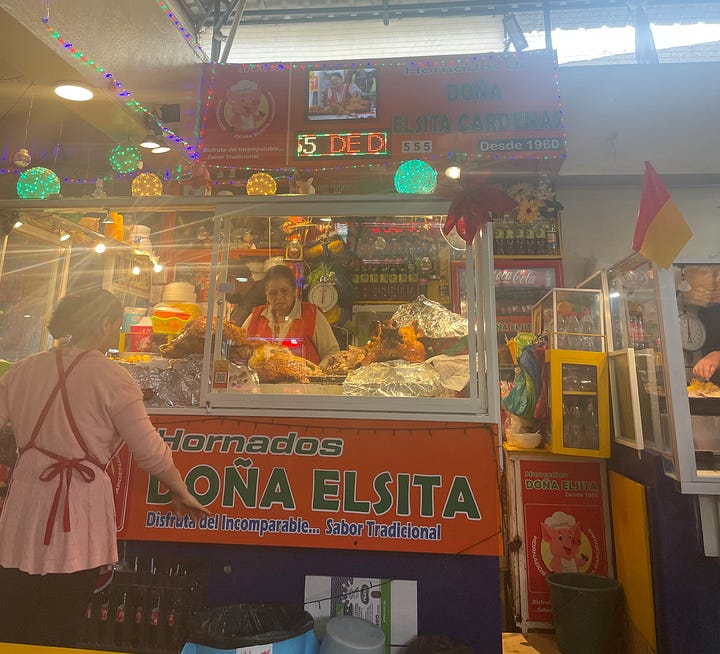
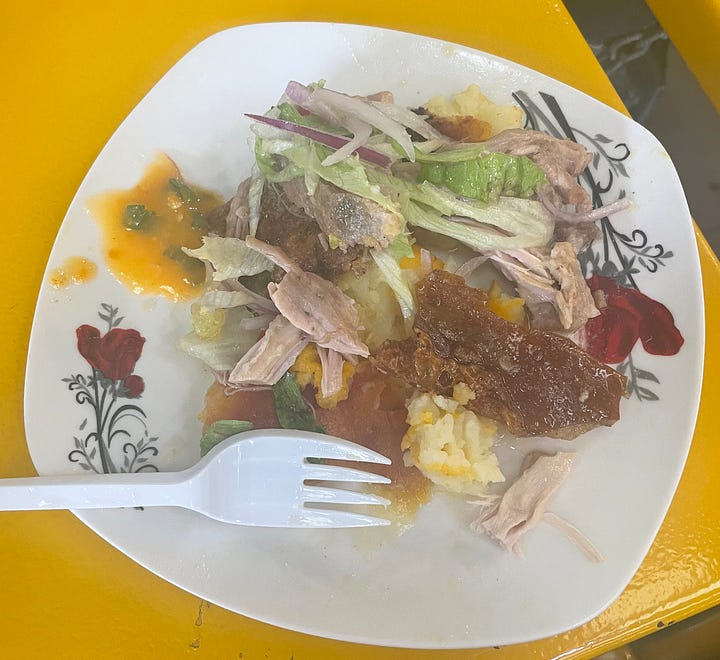
In another part of the market, you can receive a spiritual cleansing. The woman had Jasmijn and I smell an alcoholic liquid. Then, she gave us a deep massage on the back, neck, and head. She cracked my neck to both sides and then cracked my back. We inhaled several times into a plant, and then she hit us all over the body with the same plant. Stones come next, followed by a spritz from a magic liquid on the belly and back.
An egg was the grand finale. She took a raw egg and rubbed it all over us. After, she cracked it in a glass of water and diagnosed our problems. By reading the state of the yolk and white, she correctly guessed that my upper back is super tense compared to most people, among other things.
We spent the afternoon at a strange adventure park up in the hills. I found a restaurant on Google Maps that was a 40 minute walk back into town, but we decided to go for it. It’s called La Mian. The owner came here from China two years ago and fell in love with the town. Their food was amazing, especially the chili oil on the dumplings. The potstickers had this neat fried crust that formed around them like a halo.
We heard squealing, and when we asked what it was, they brought us back to introduce us to a pile of 8-10 puppies in their backyard. They were stumbling around, trying to suck milk from their mama, who kept running away because she was tired. I loved having five puppies sitting in my lap.
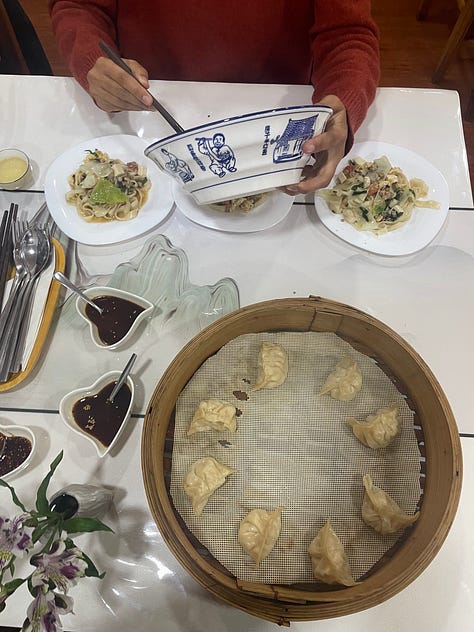
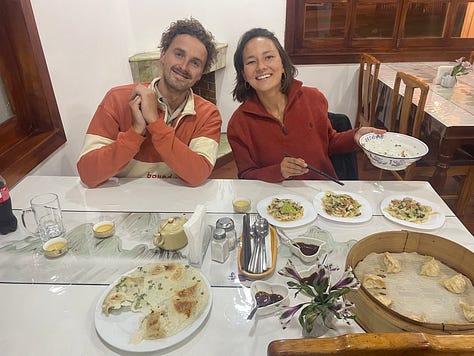
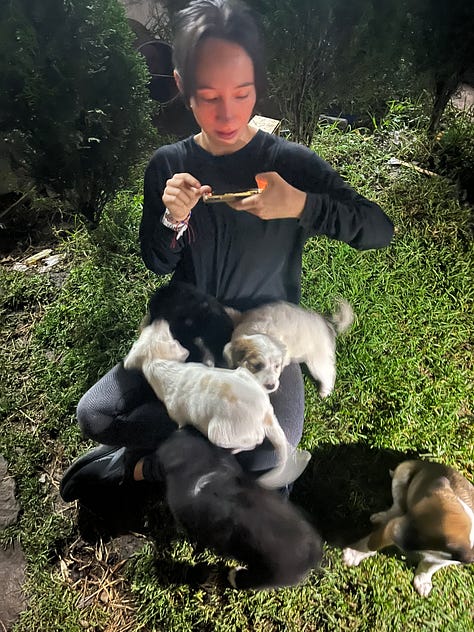
I loved getting to know everyone at the restaurant in this special way. On the walk back to our hostel, we came across more cool evening community gatherings. Tons of running groups were exercising in the park. We also got to watch a multi-round rap battle on a staircase.
Our last day in Cuenca was also jam-packed. We spent the morning walking along the river Tomebamba. It was so picturesque. The smell of freshly cut grass was in the air. The houses alongside the walkway felt European, like the city streets. We hung out at the Pumapungo Museum and a coffee shop to hide from the rain, then made it to a fun Dutch snack bar. Jasmijn and Tom introduced me to Bitterballen, Dutch deep-fried meatballs.
Then, we piled into a taxi with more hostel friends to go to the fancy Piedras de Agua Spa. Since the spa is 2 people for the price of 1 on Monday-Friday, we only paid $20 per person. We showed up in the last two hours, so it was relatively empty. They gave us matching red robes to wear in between baths. We started in the red and blue mud pools, then we went underground to alternating hot and cold pools in a cave. To finish, we sat in individual barrel saunas and got to drink yummy rose and fruit water. Once we finished, we had free time to use the outside pools until the spa closed. It was helpful to have detailed instructions on how to get the most out of the pools. I especially enjoyed being submerged up to my neck in the hottest pool.
The cherry on top of the night? The party taxi that picked us up with a thumping bass and special blue lights 🪩.
The Galápagos
I took a short bus from Cuenca to Guayaquil the next morning. Most people fly to the Galapagos from Guayaquil or Quito. The airport process was intense. You have to wait in several lines to grab a $20 transit card and do a special bag inspection. You need to provide all of your lodging information at the airport and pay a $100 fee (going up to $200 in August 2024). The fees help raise more funds for conservation, infrastructure and the community, according to the Galapagos Conservation Trust (GCT).
Once everyone has boarded, the passenger cabin gets sanitized for pest control to avoid bringing in external baths. Once you arrive in the Galapagos, you walk through a footbath for further sanitization. Every time you travel between islands, your bags must be inspected. I appreciated the meticulous care that gets put into protecting the islands and limiting tourism.
Many people will take cruises, but I opted for a more affordable 8-day land-based tour. I booked a tour in advance because it can be stressful to book each activity. The popular tours can book out several days in advance, so a few friends couldn’t do the activities they had hoped for.
I don’t have many words to describe this week in the Galapagos, so I hope the photos will do it justice.
Day 1
I met my tour mates Rebecca and Amie at the San Cristobal airport. Rebecca is Welsh, and they both live in London. We would be spending the next week together.
Our guide showed us the main strip to spot the many sea lions that rest in the water and on the rocks. We climbed up the Tijeretas Hill to watch birds, including the magnificent frigatebird, which has a large red gular sac that is meant to attract mates. We passed by a beach and swam at a second one, Mann Beach. The sea lions would swim past us. I loved watching a sleepy baby flopped under the lifeguard chair next to me

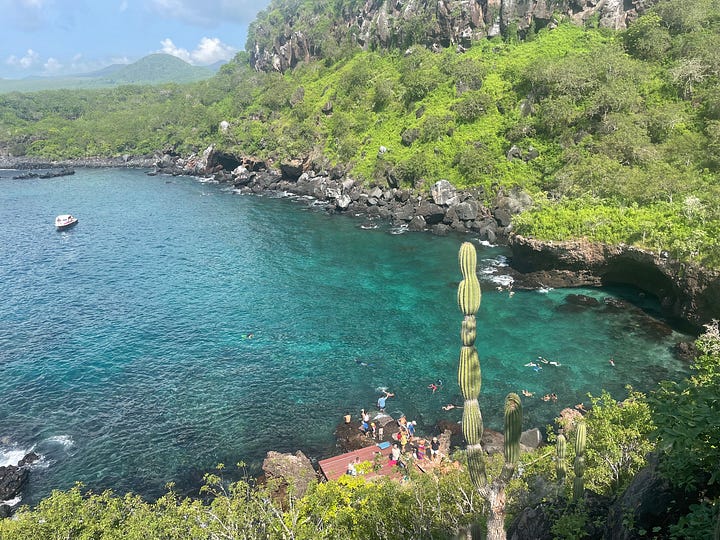
I ate dinner at Muyu, trying some great zucchini spaghetti with a nutty sauce, along with bread, floral herby butter, and lemongrass oil.
The sun was extremely strong here, since we’re right on the equator line. Despite applying frequent sunscreen, I burned frequently. Remember to pack a lot of reef-safe sunscreen! The sunsets are worth it though. :)
Day 2
For our morning Kicker Rock snorkeling tour, we were split into two boats. I went with Martin Cox, and the girls went with his dad, Whitman Cox. Our first stop was a dazzling white beach. The sand was soft but firm. We walked up and down the shore, spotting birds, iguanas, and sea lions. A few of us sat in the water, and a sea lion came right up to us. It nudged my foot with its whisker, but I backed away, shocked at how quickly it moved in the water.
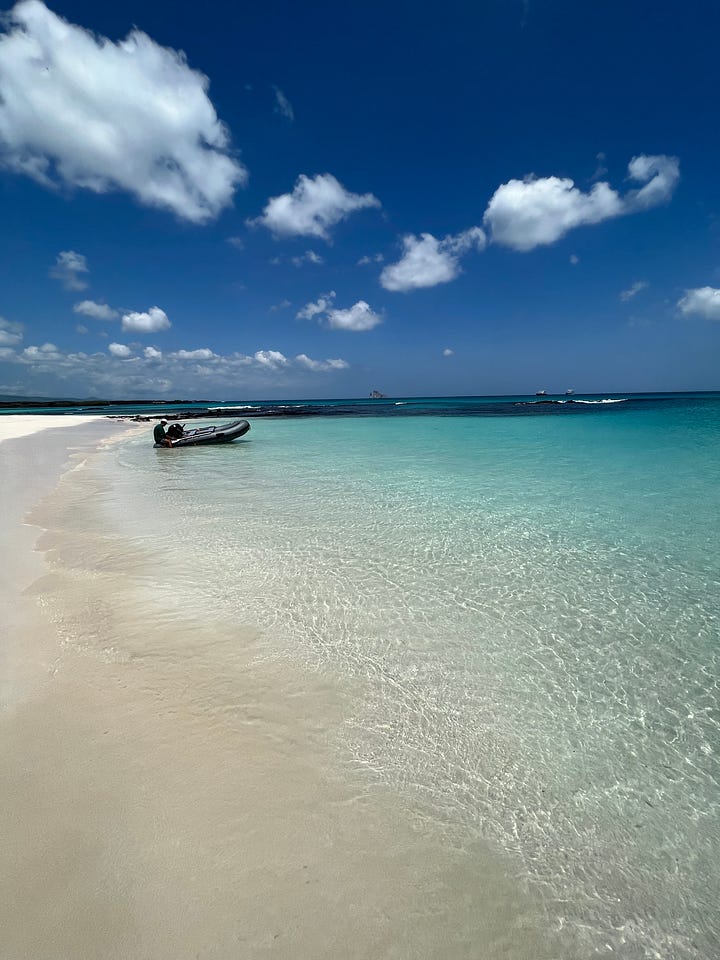

After that, we took the boat to Kicker Rock. Even though I chose not to scuba dive, we could see so much with the snorkel. A huge school of hammerhead sharks passed underneath. Martin captured a close-up video of them on his GoPro. We watched turtles swimming around, other types of sharks, eagle rays, and more.
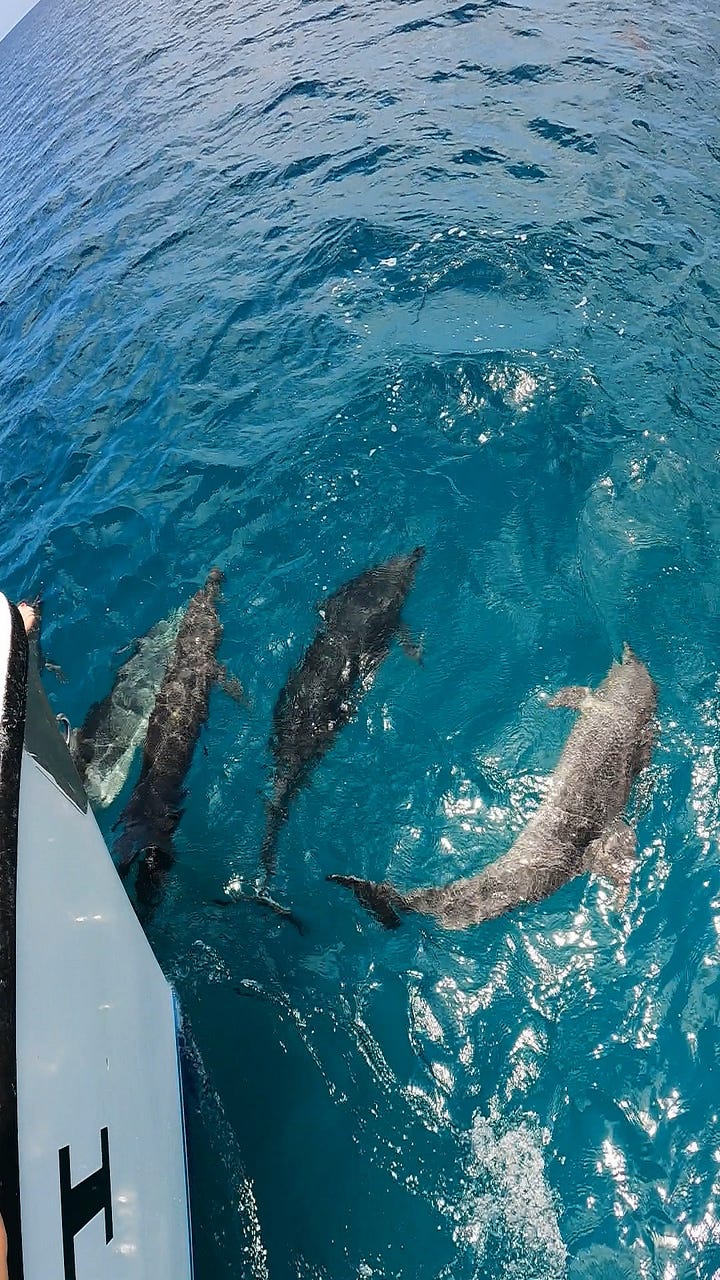
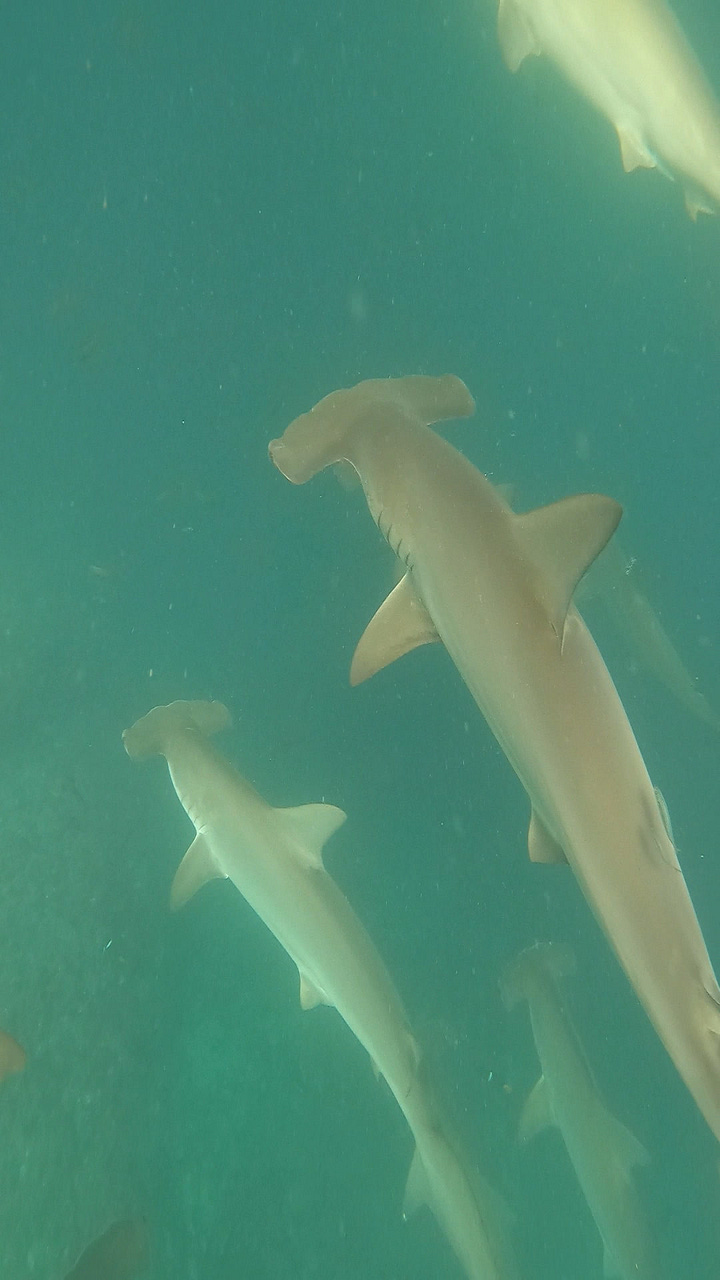
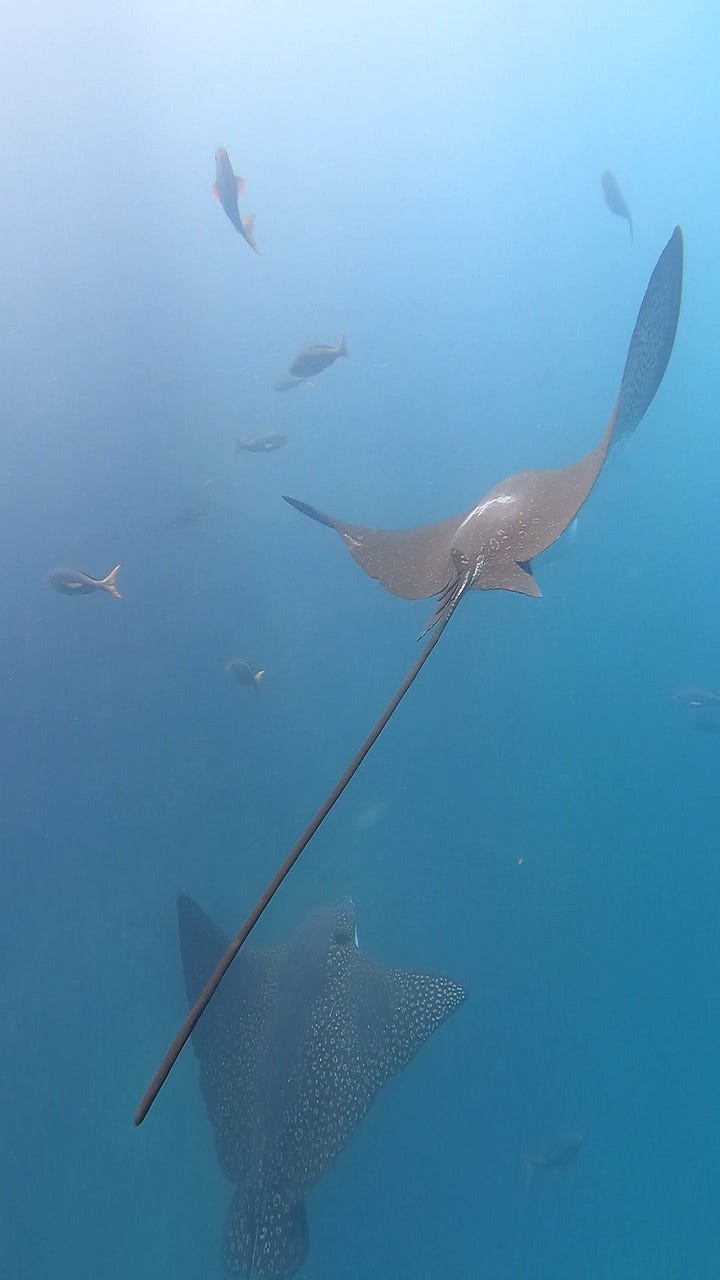
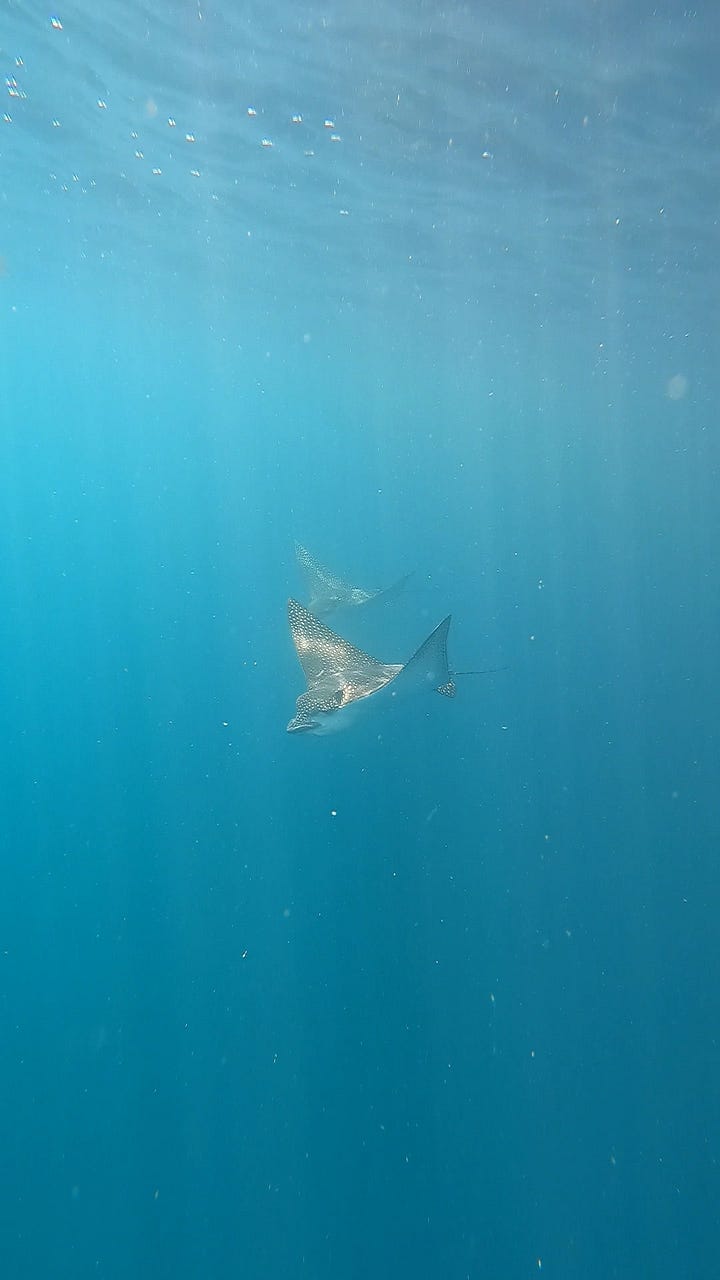
Before, it was possible to swim through the gap in Kicker Rock, but it can be dangerous in rainy season, since rocks will fall. Apparently, a girl had been hit by a rock four weeks ago and had to be airlifted out. So, we stuck to the exterior of the rock.
We saw our first Blue Footed Boobies on the rock, along with more frigate birds! The colder water on the other side of the rock was nice, but we had to go back to the boat when we started to get tiny stings from the jellyfish. The simple lunch on the boat put me to sleep: fish, rice, beans, with pickled onions on top.
Our afternoon was free, so I took a 5 mile run to the Lobería Beach to watch the sea lions at sunset. It was golden hour, and the whole beach was glowing.

Day 3
We took an early morning boat to Santa Cruz after breakfast.
We spent the morning at the Charles Darwin Research Center. The best parts were feeding two giant male tortoises a piece of cactus and watching them fight over it, and the very air conditioned room holding Lonesome George, the last Pinta tortoise
During our afternoon snorkel tour, we went to the Grietas pools, a series of swimming holes. The water is brackish (a mix of salt and fresh), so you can’t see many fish here, but it was cool to practice swimming for a longer period of time.
Day 4
In my free morning, I went on a 5 mile run to the Tortuga Beach and back. It was a scorcher, hilly with no shade, but it was cool to run on the hard sand of this beach.
When we were walking through town, we found a woman who had constructed a cave-like building to sell her artwork.
We took a bumpy boat in the afternoon to Isabela Island. Each bump was amplified because we sat in the front, which is the worst area. I closed my eyes, braced my head, and tried to sleep for most of the ride.
As the sun was setting, our guides drove us to see some flamingos eating in a lagoon. We got lucky because sometimes there aren’t any around. In town, I loved seeing the seals walking to the water entranced, with the big bright moon shining overhead.
I went to sleep with a belly full of the greasy empanada from Don Pipo. It reminded me a lot of scallion pancakes.
Day 5
In the morning, we hiked the Sierra Negra Volcano trail. It is only the volcano on the island that visitors are allowed to hike. Several high school girls were in our tour group, so it was fun to hear about how the high school scene has changed.

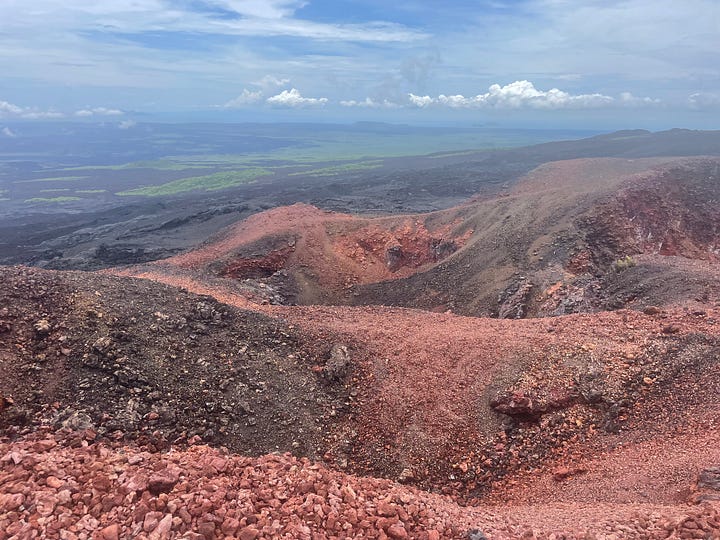
Naturally, I fueled up after the 12-mile hike with an empanada from Don Pipo. Our afternoon activity was canceled due to strong winds, so we just hung out with each other over drinks and dinner. Isabela was a lot less developed than the first two islands, so we got more of a sense of island life here. I loved walking back to the hotel barefoot in the sand.
Day 6
Today was a big day! We spent the morning hiking to the Wall of Tears, sharing the path with giant tortoises and marine iguanas. Isabela used to be a penal colony. The prisoners were sent here because it was virtually impossible to escape. They built this wall by hand out of lava rock. It had no real purpose, other than to make the prisoners suffer. Many men died during the construction of this wall. We paid respect to their memory.
On the way back, our guide showed us a lava tunnel that we could walk through. We also saw colorful crabs that molt over time to achieve an even deeper red color.
The tortoise breeding center was our last stop of the morning. The turtles are raised here until they’re 10, and then they get released to the wild. The center had almost 1,000 babies.
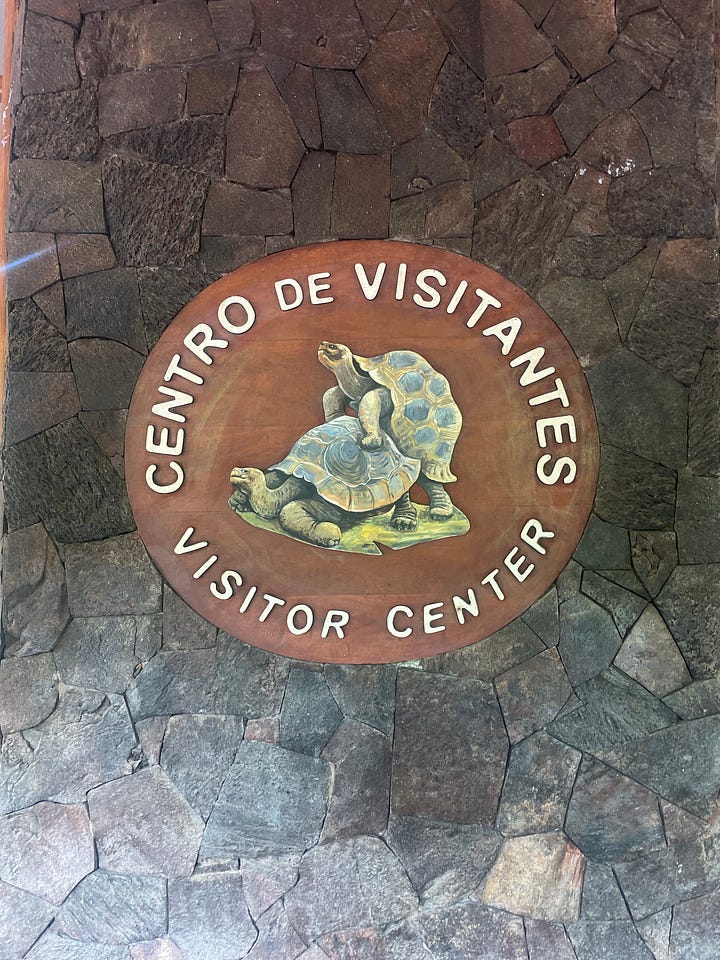
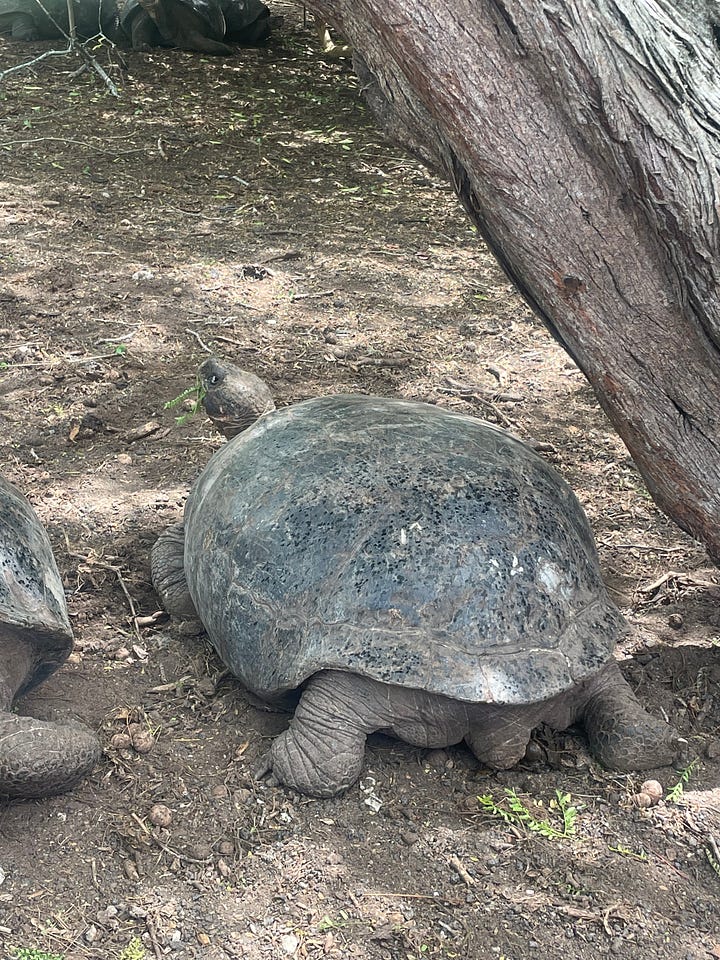
In the afternoon, we took a boat to snorkel. We swam with a bunch of sea lions, and I even swam directly over a turtle! Then, we walked in the Tintoretas area, where you can see whitetip reef sharks basking in shallow waters.
Our dinner at the Albita Grill was great. You can get a grilled fish in a huge serving for only $7.
Day 7
What a lovely day! We went on a snorkeling trip to Los Tuneles. First, we took the boat for 45 minutes and got to lie on the top. We walked around on top of the tunnels to admire the super clear water and saw sharks and turtles swimming through. It was impressive the boat could fit in to park.
Then, we got in to snorkel for 30 minutes, swimming through the tunnels. We moved to a new spot to snorkel for an hour more, swimming with many sea turtles, poking our heads into a cave with many sharks inside.
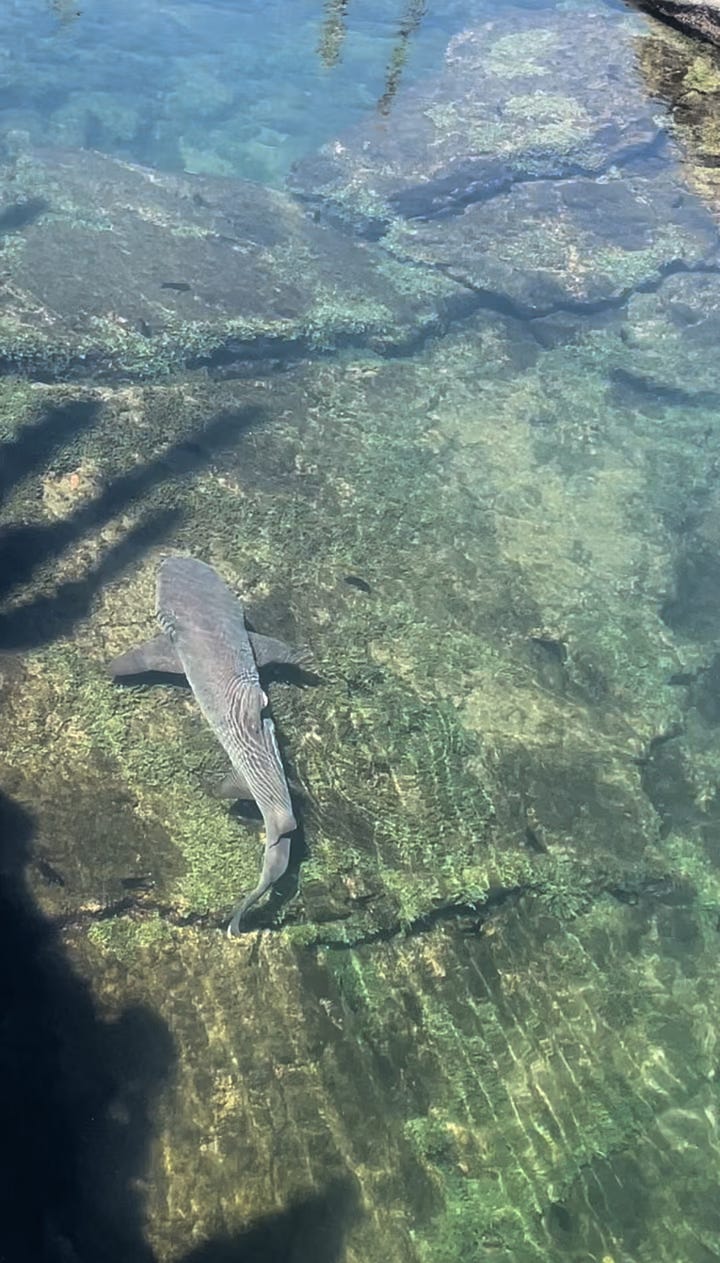
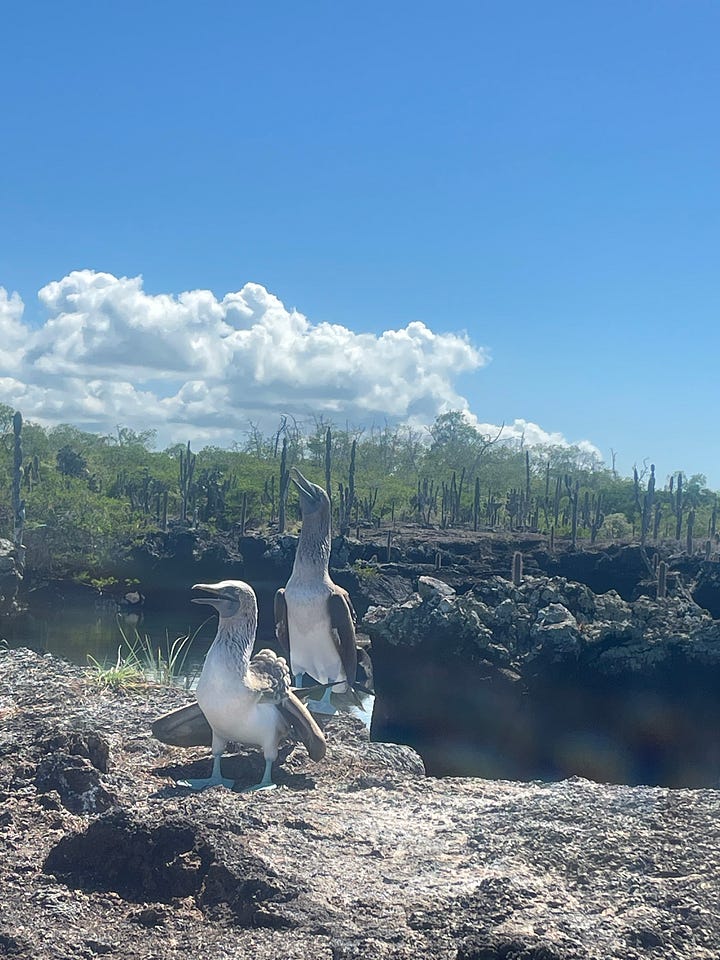
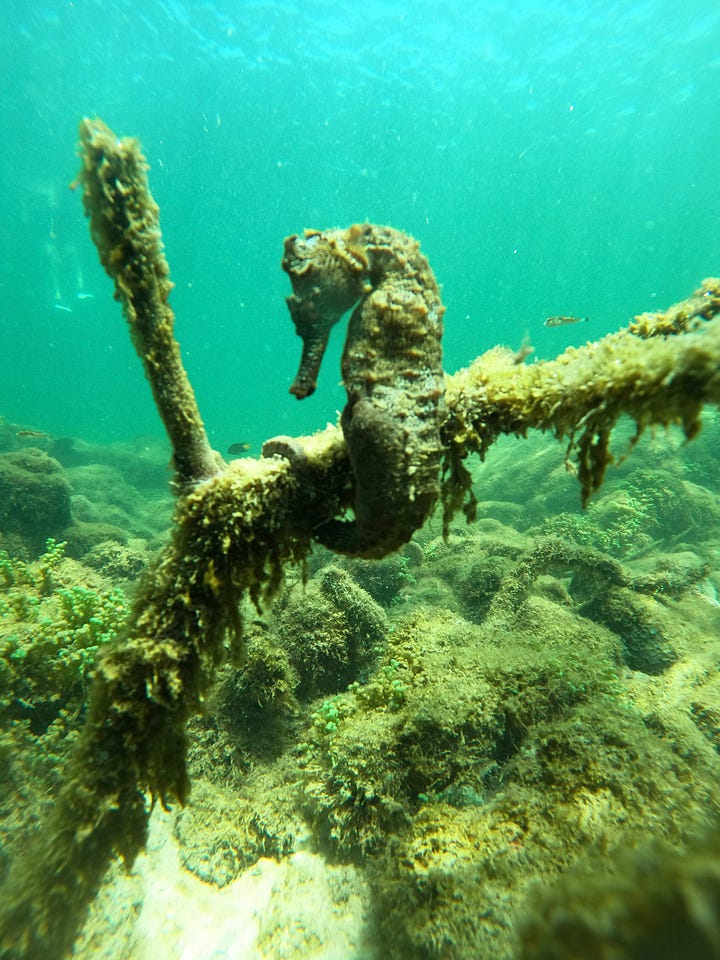
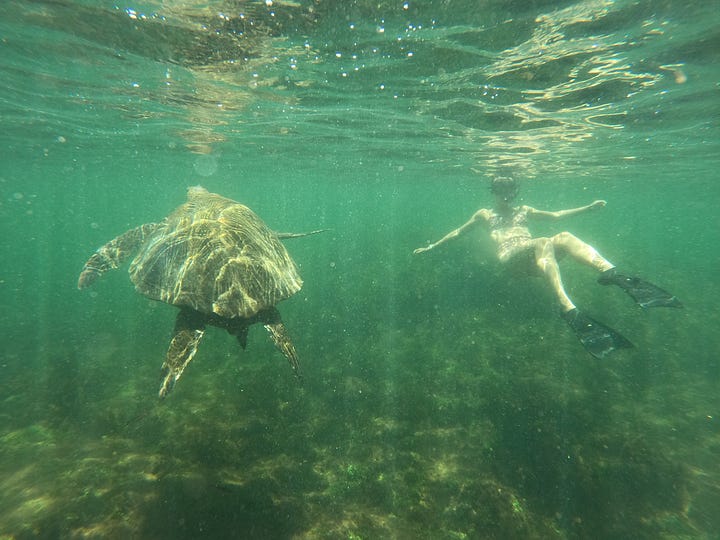
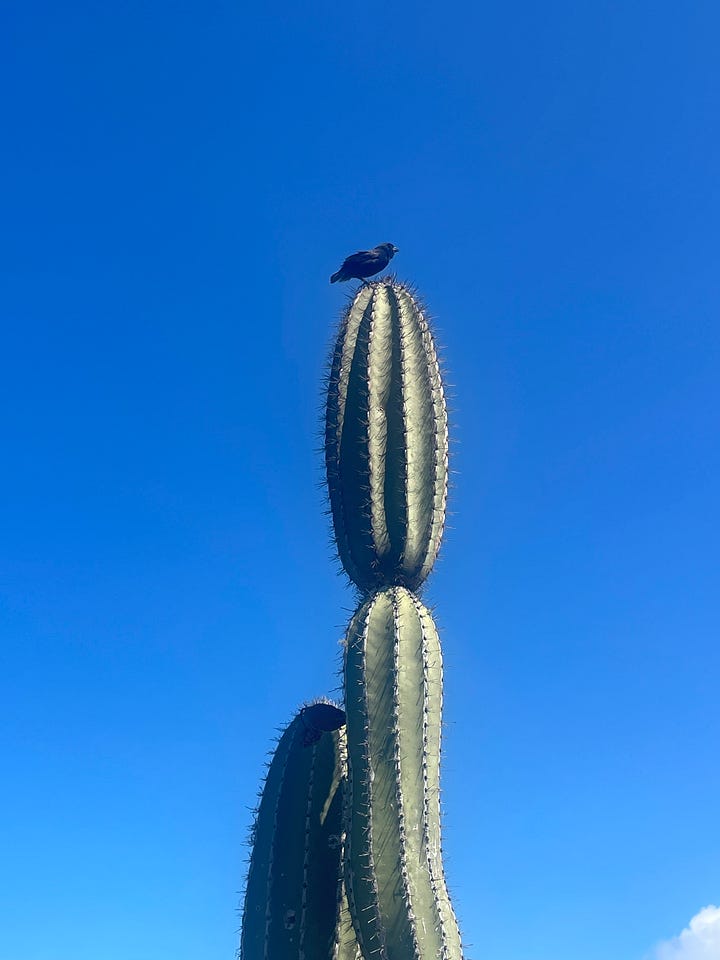
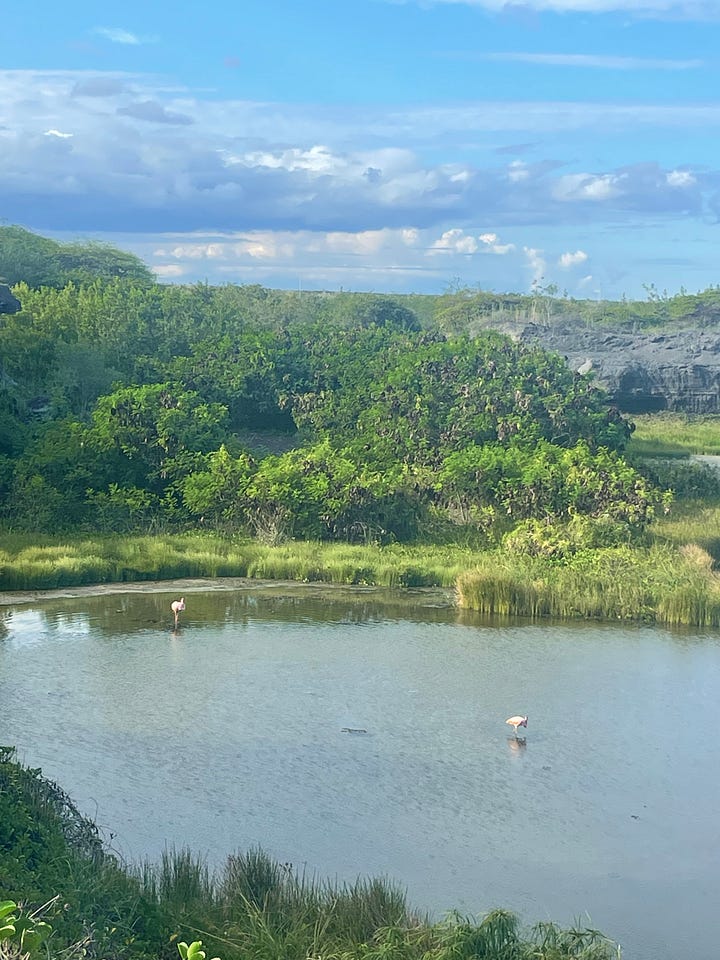
I tried snorkeling without a life jacket for the first time! I was scared of choking on the salt water, but I was surprised by how calm and floaty I felt. I loved zooming forward when I paddled. Being in the water helped slow me down.
I grabbed sunset drinks with Tom and Jasmijn, then went to an Asian Fusion spot for dinner with Rebekah and Amie, where we met the hilarious waiter Charlie. When Bekah asked for wine, he zoomed away on a bike to grab another bottle, because they were sold out. He loved blasting Lady Gaga and Britney Spears. The food was also quite good.
I helped a little dog in a dress find its family and went to bed.
Day 8
Our last morning in the Galapagos may have been brief, but it was sure was beautiful. We took a sunrise boat ride back to Santa Cruz to make our flights. The boat had four seats on top, and we managed to grab three of them! We saw the pink in the sky and the moon still out. Dolphins and rays were jumping around us. We could spot shark fins in the distance. I drifted off, and before I knew it, we were docking in Santa Cruz.
My week in the Galapagos was everything I had hoped for. 🐢




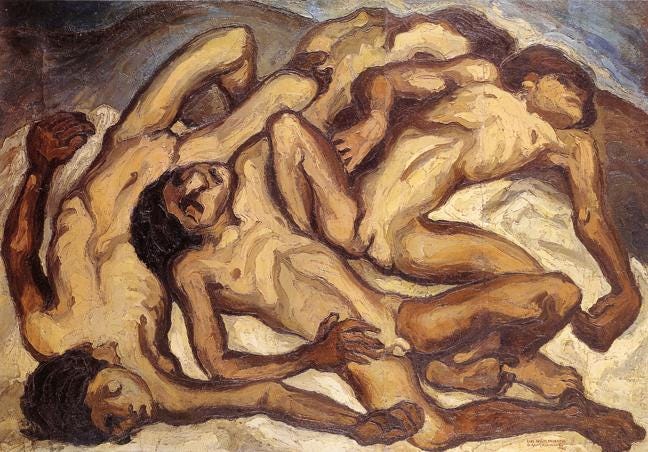
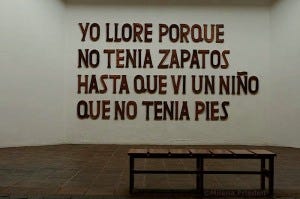
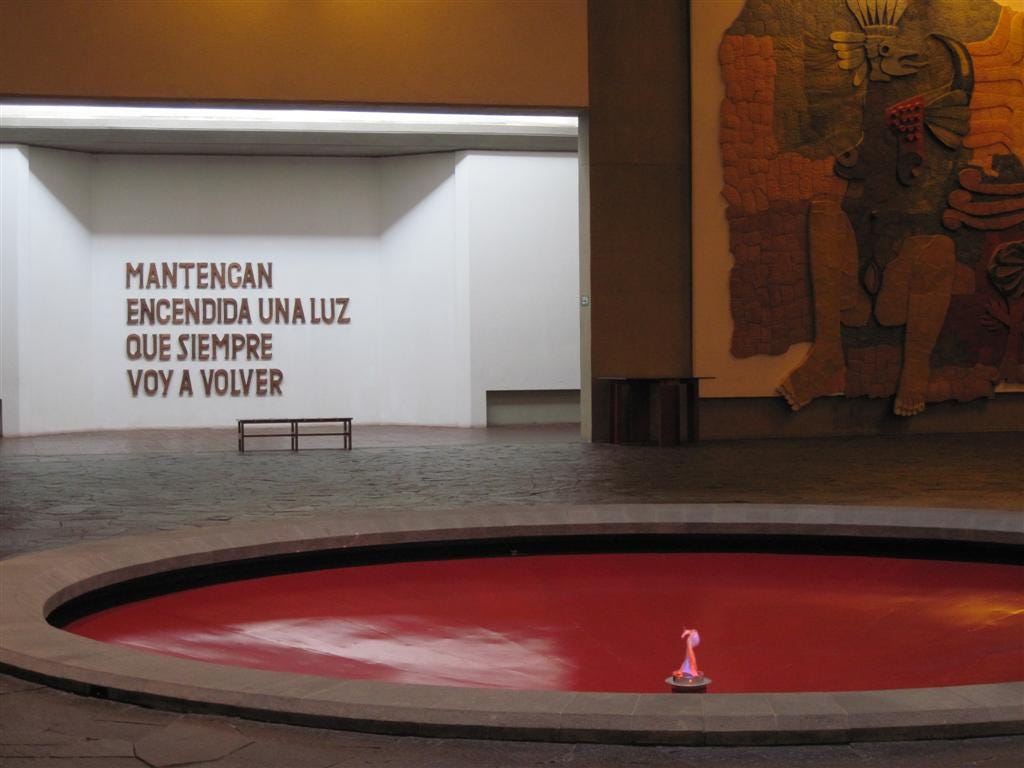
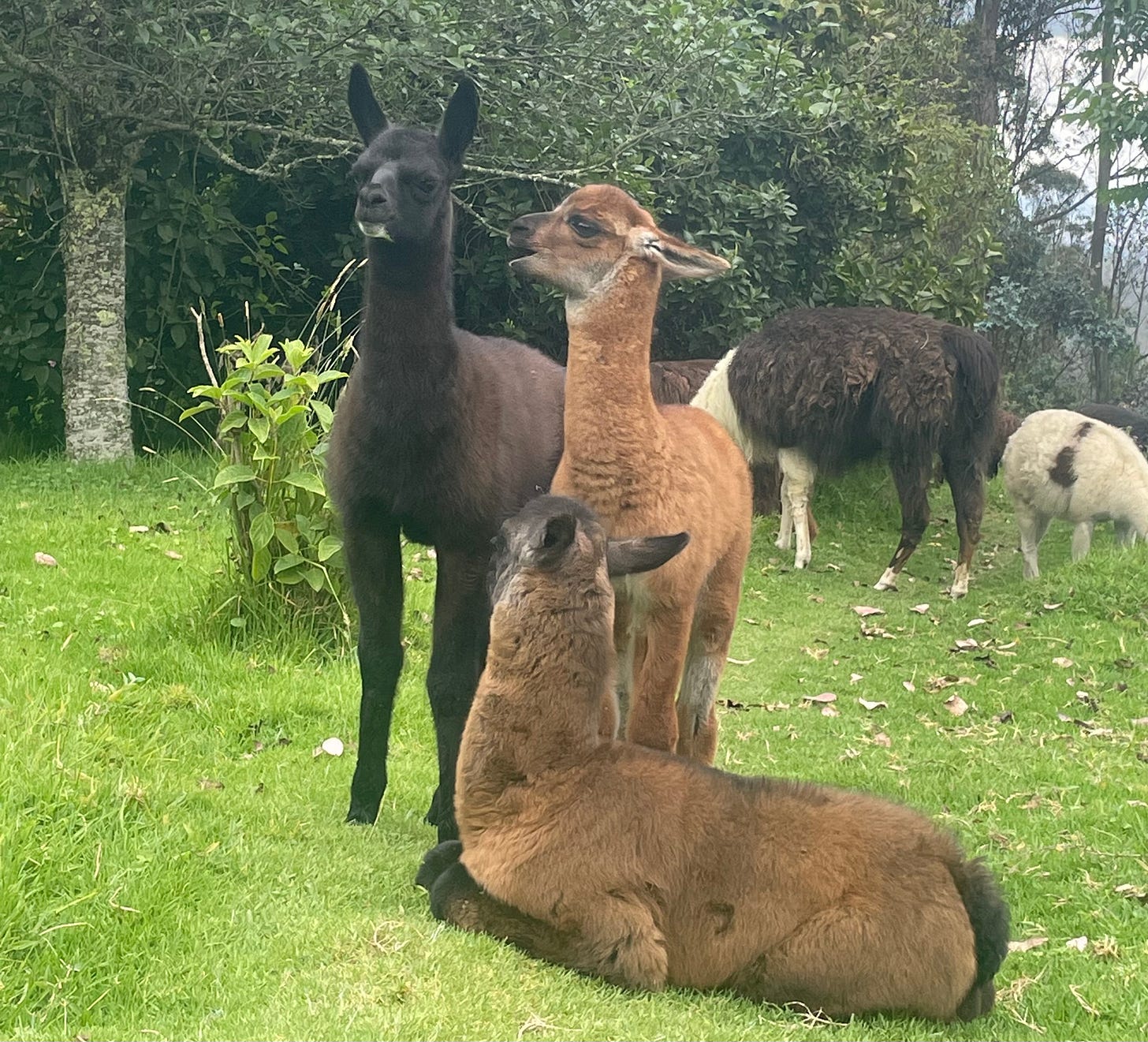
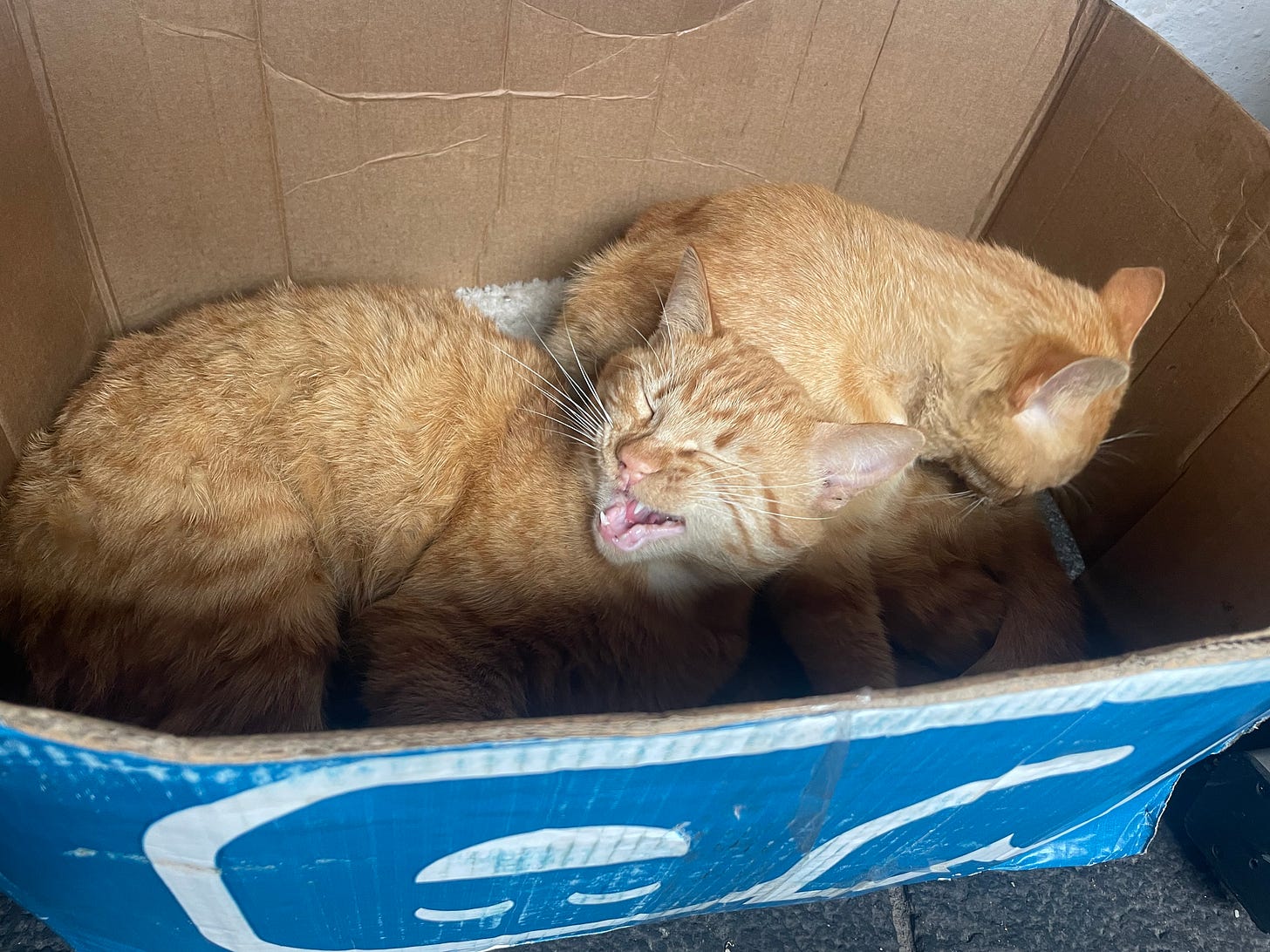
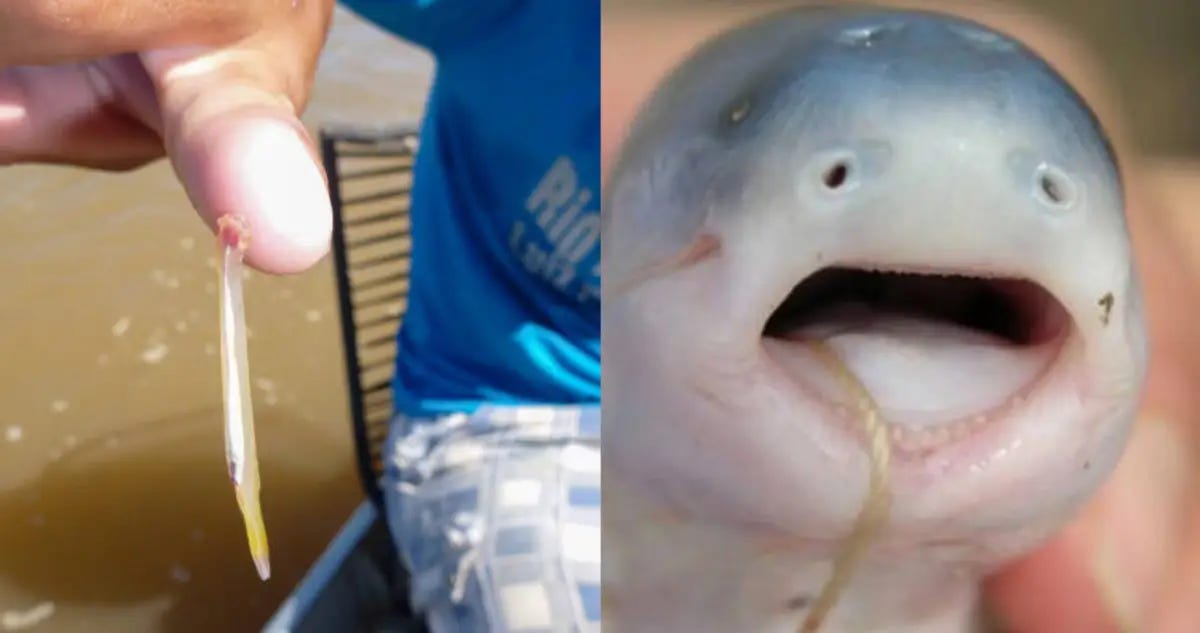
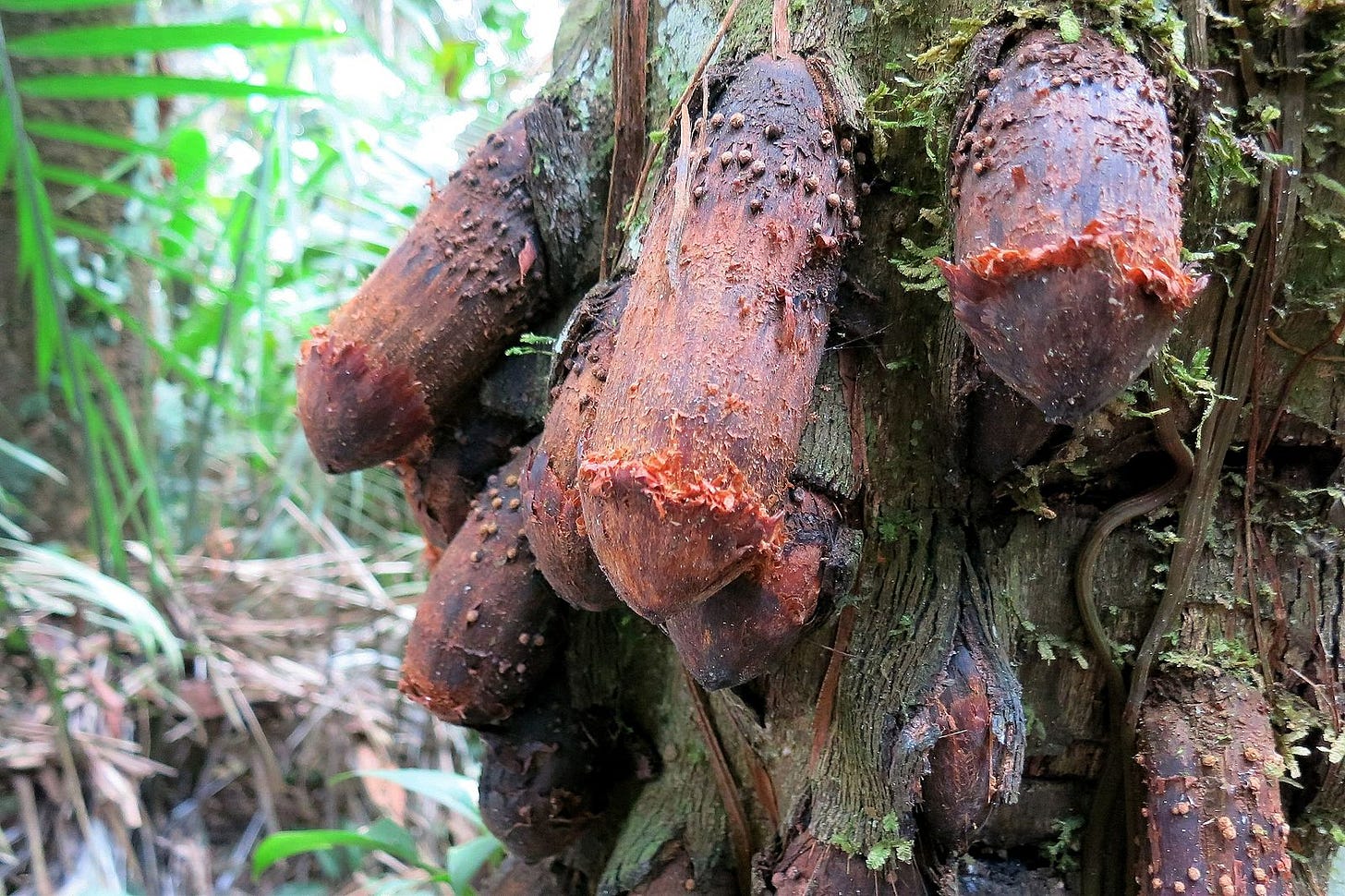
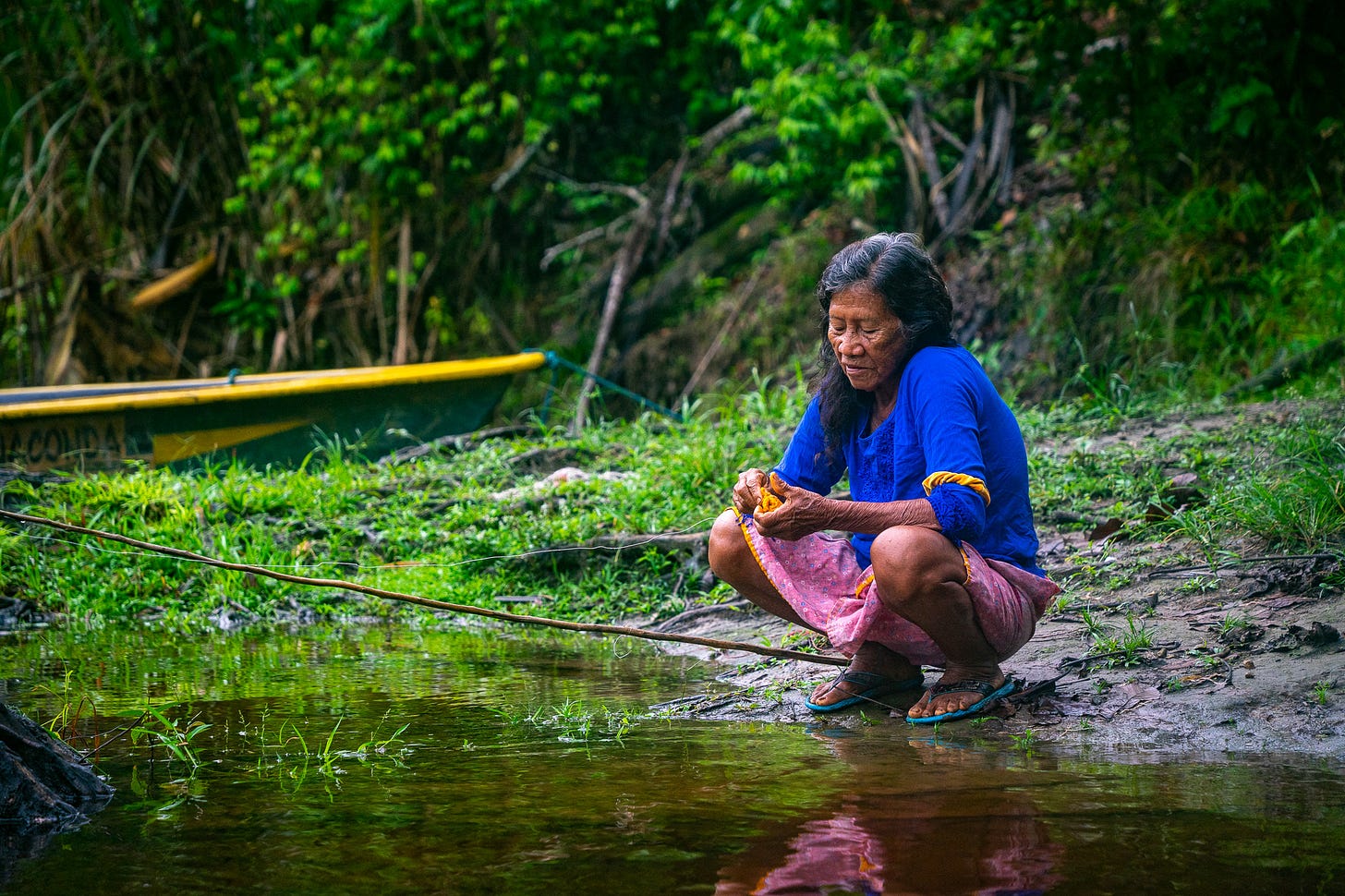
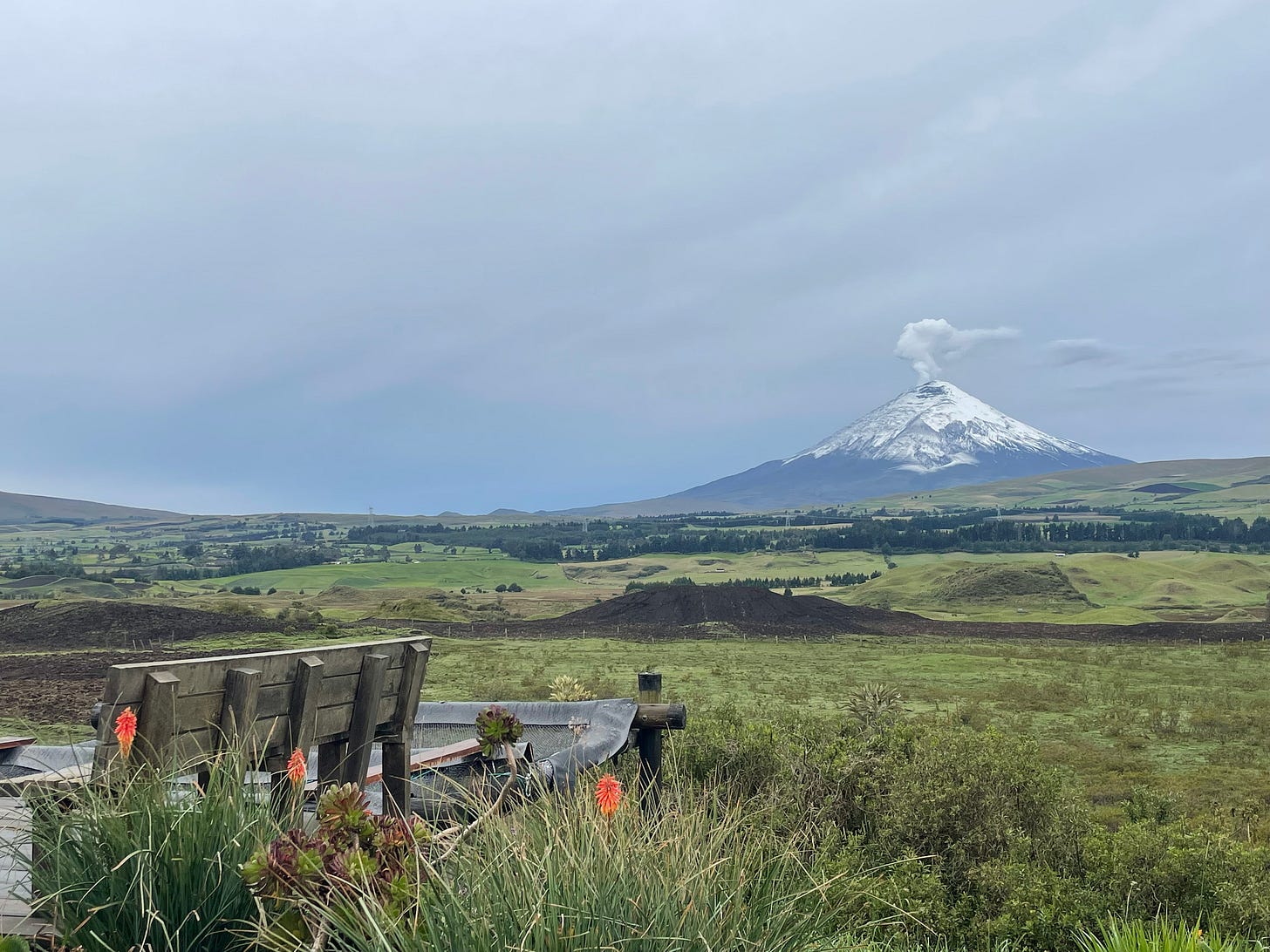

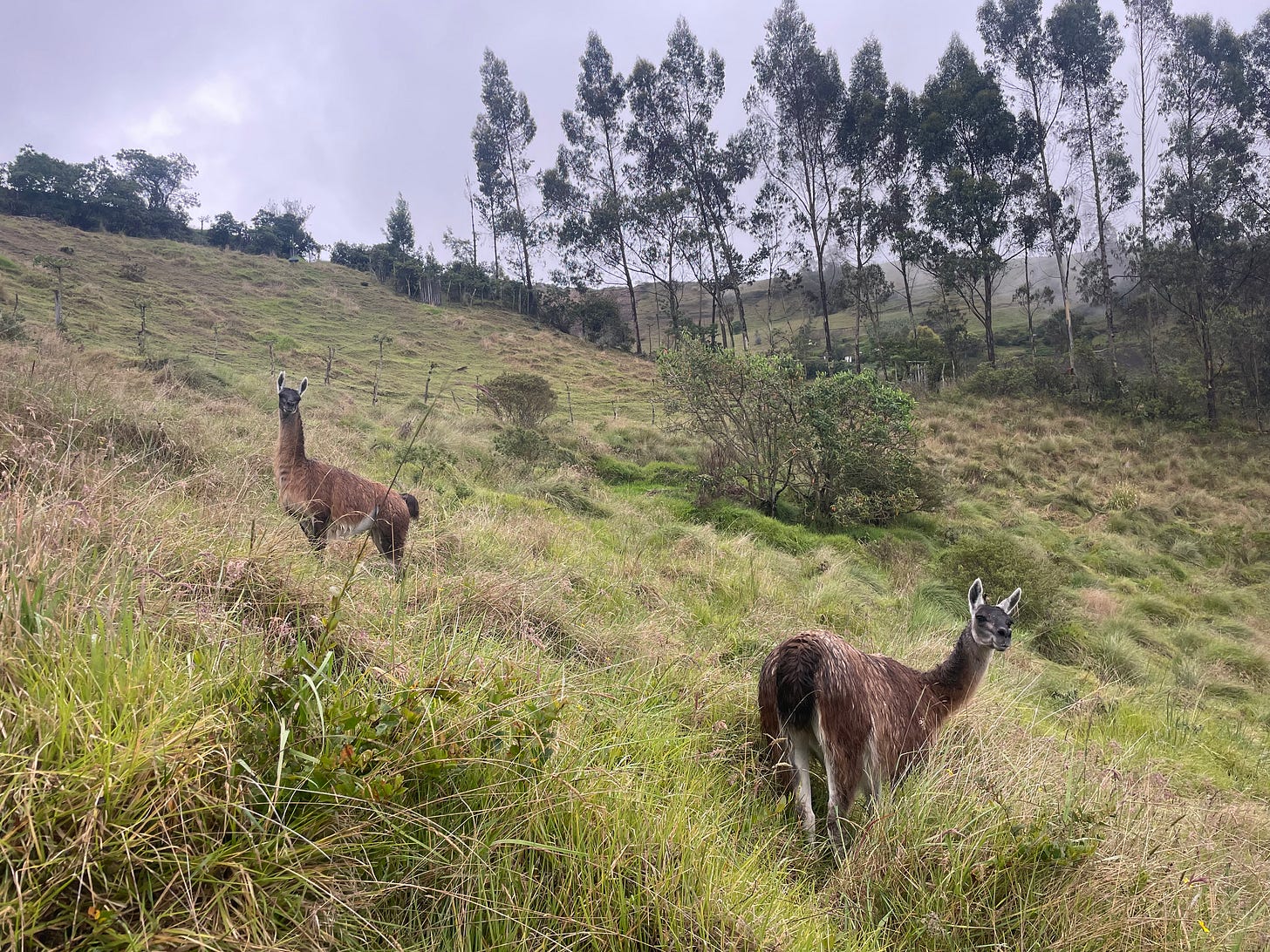
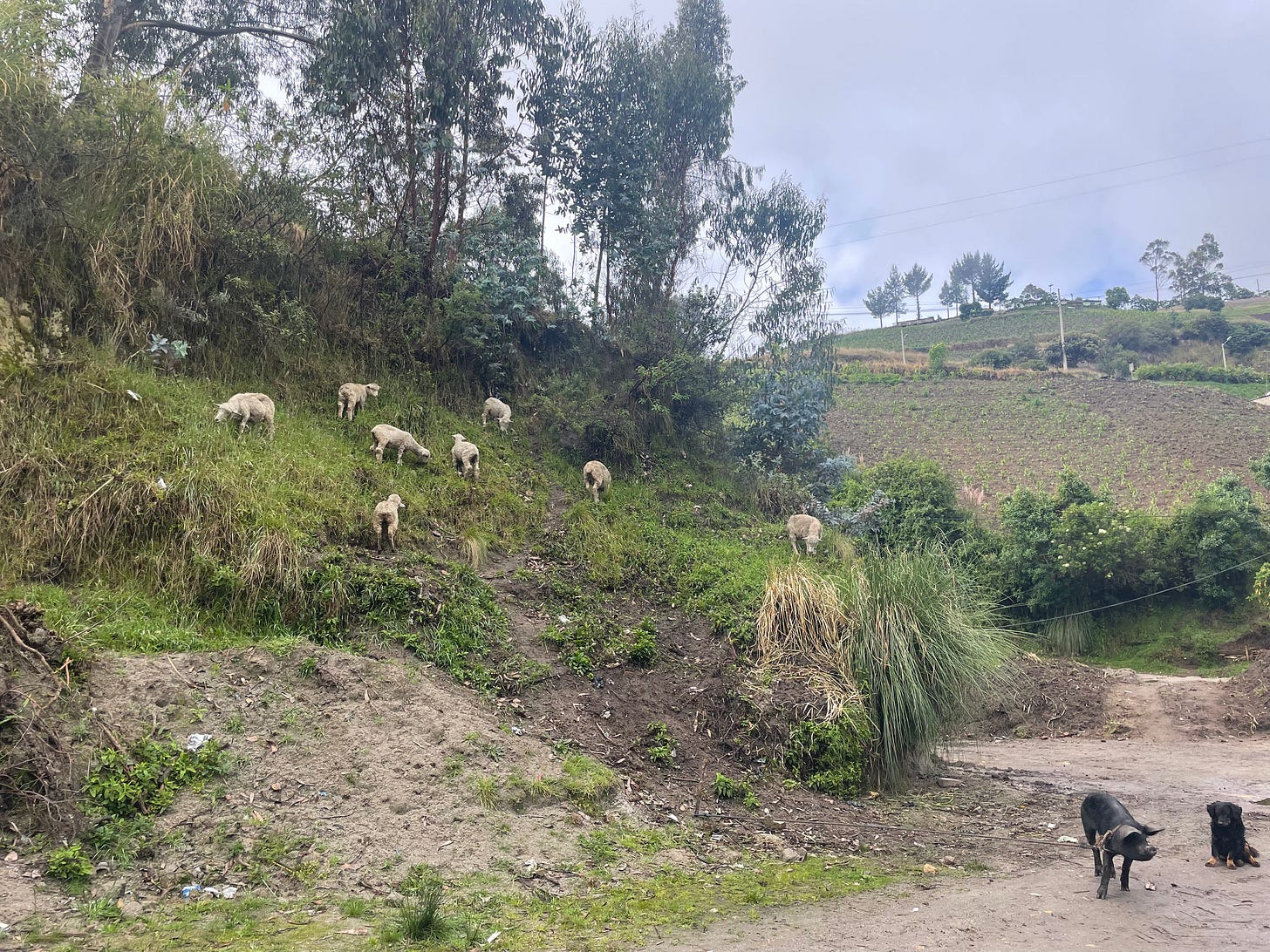
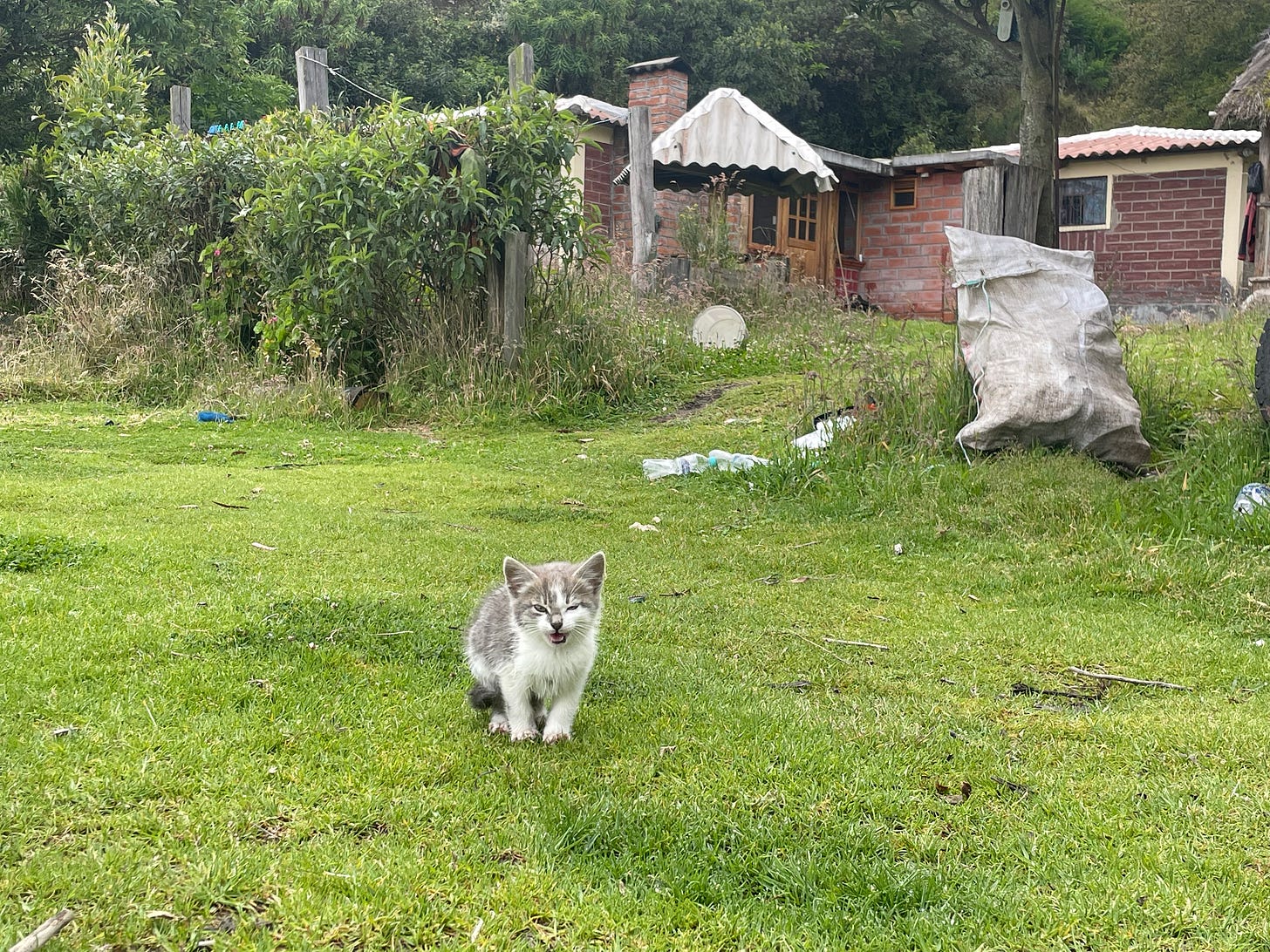
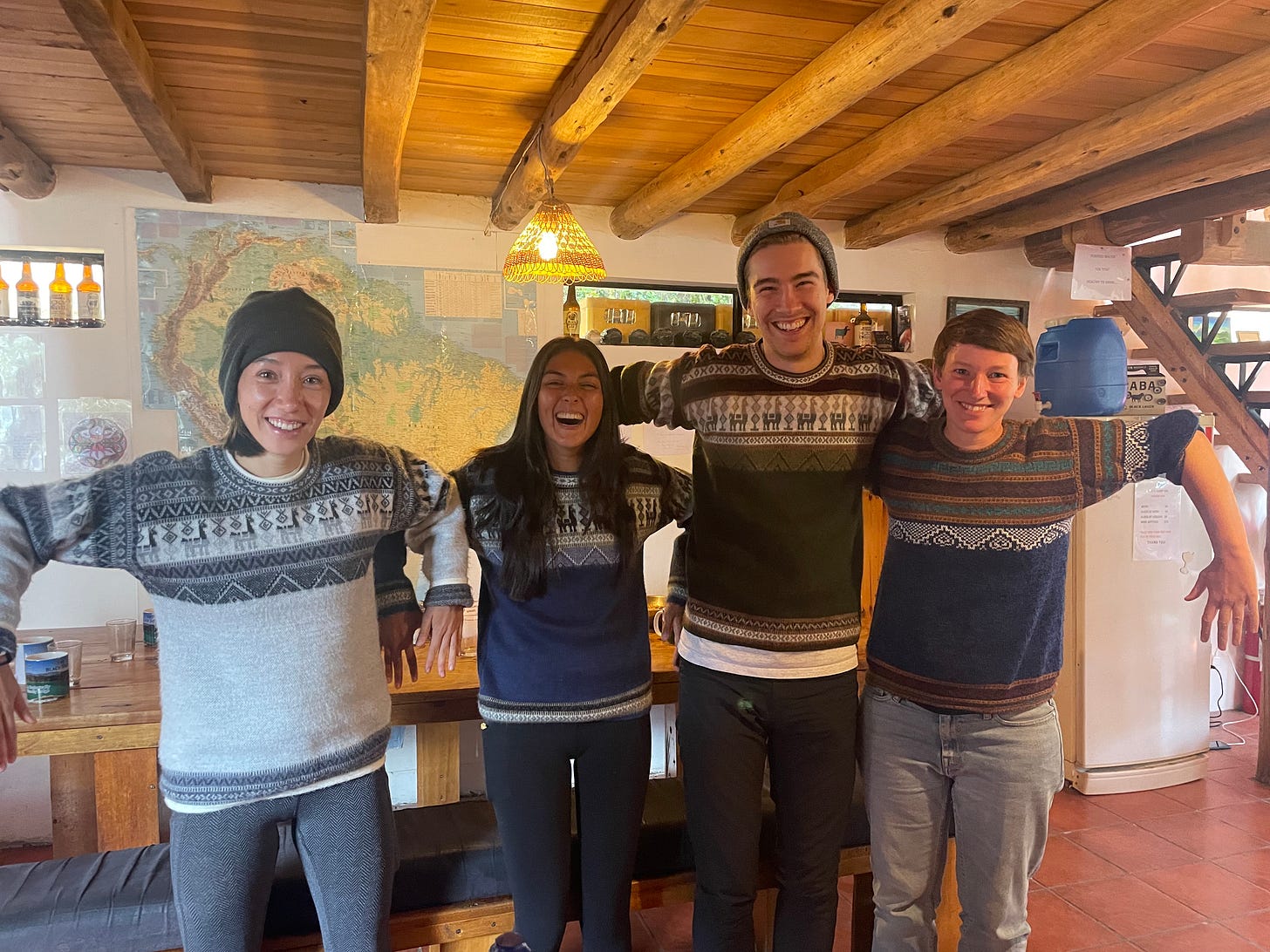
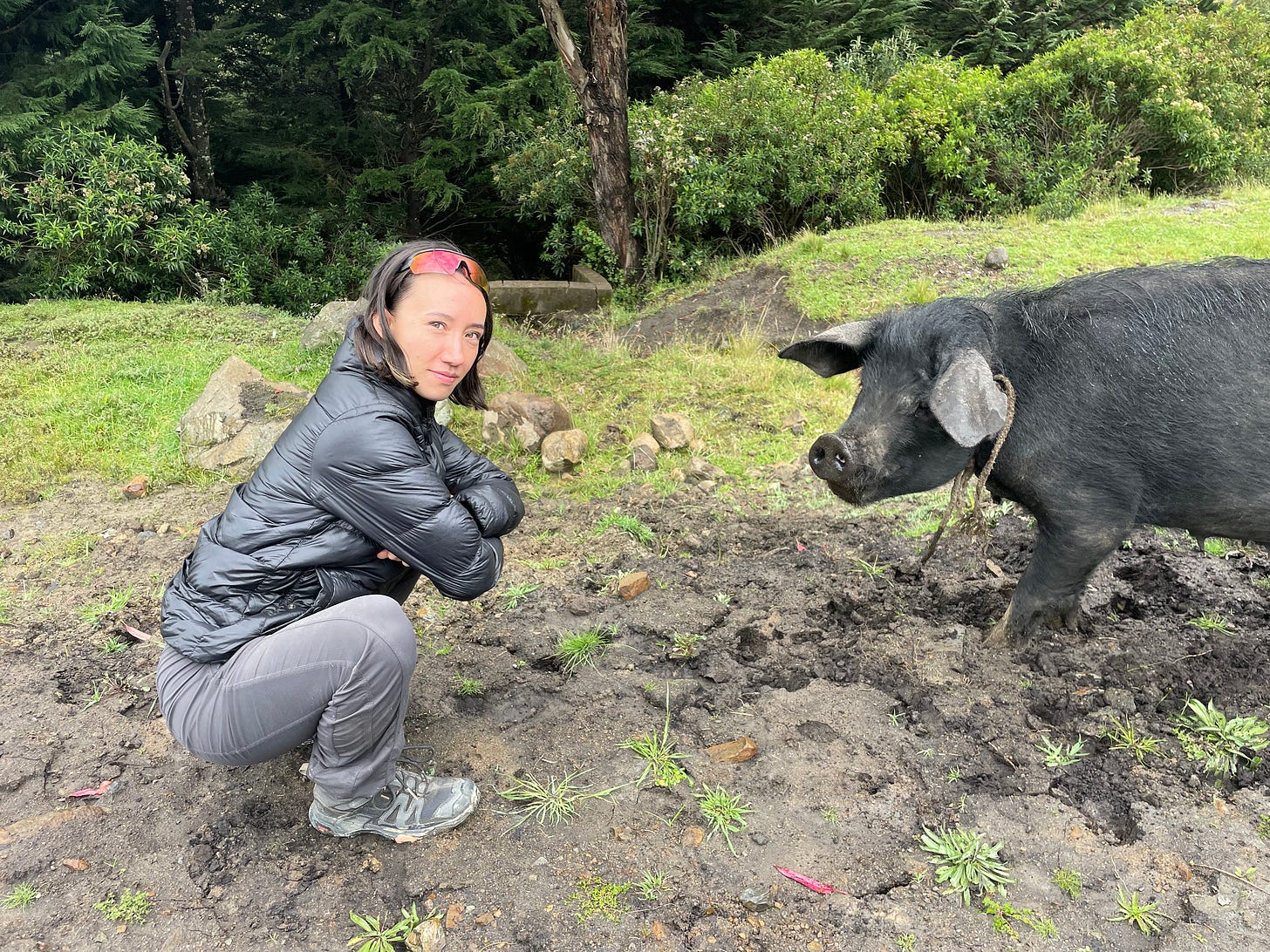
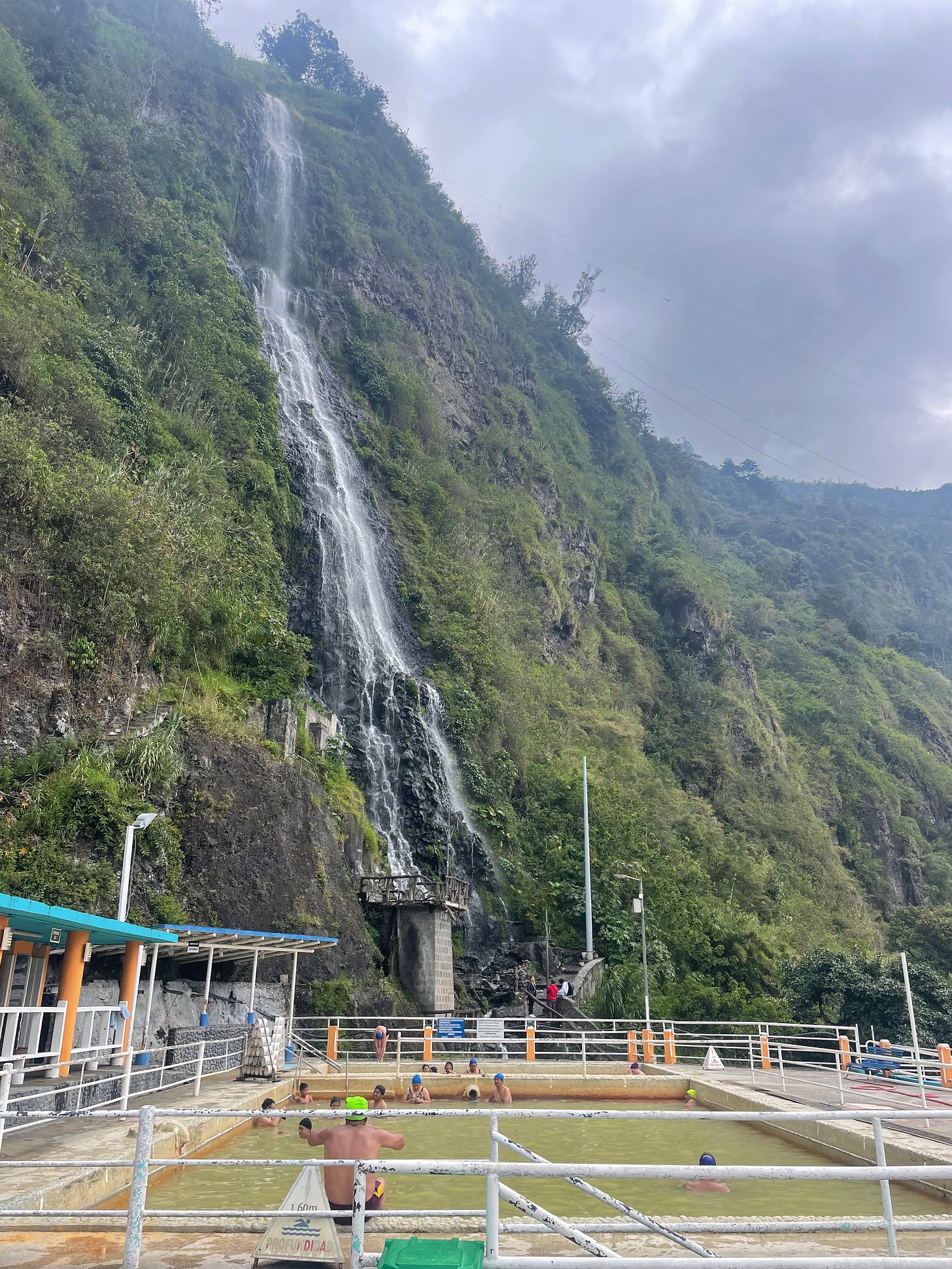
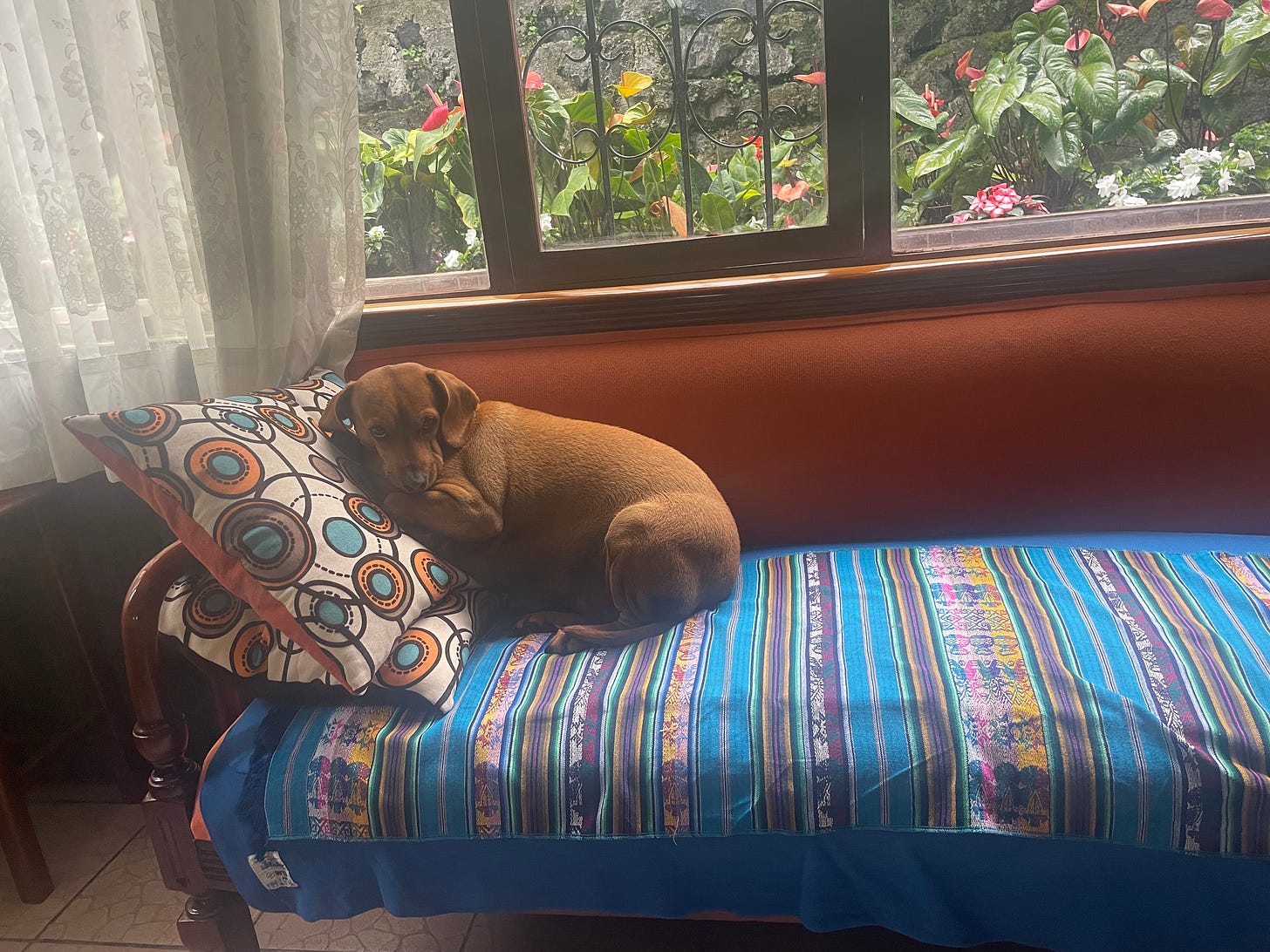
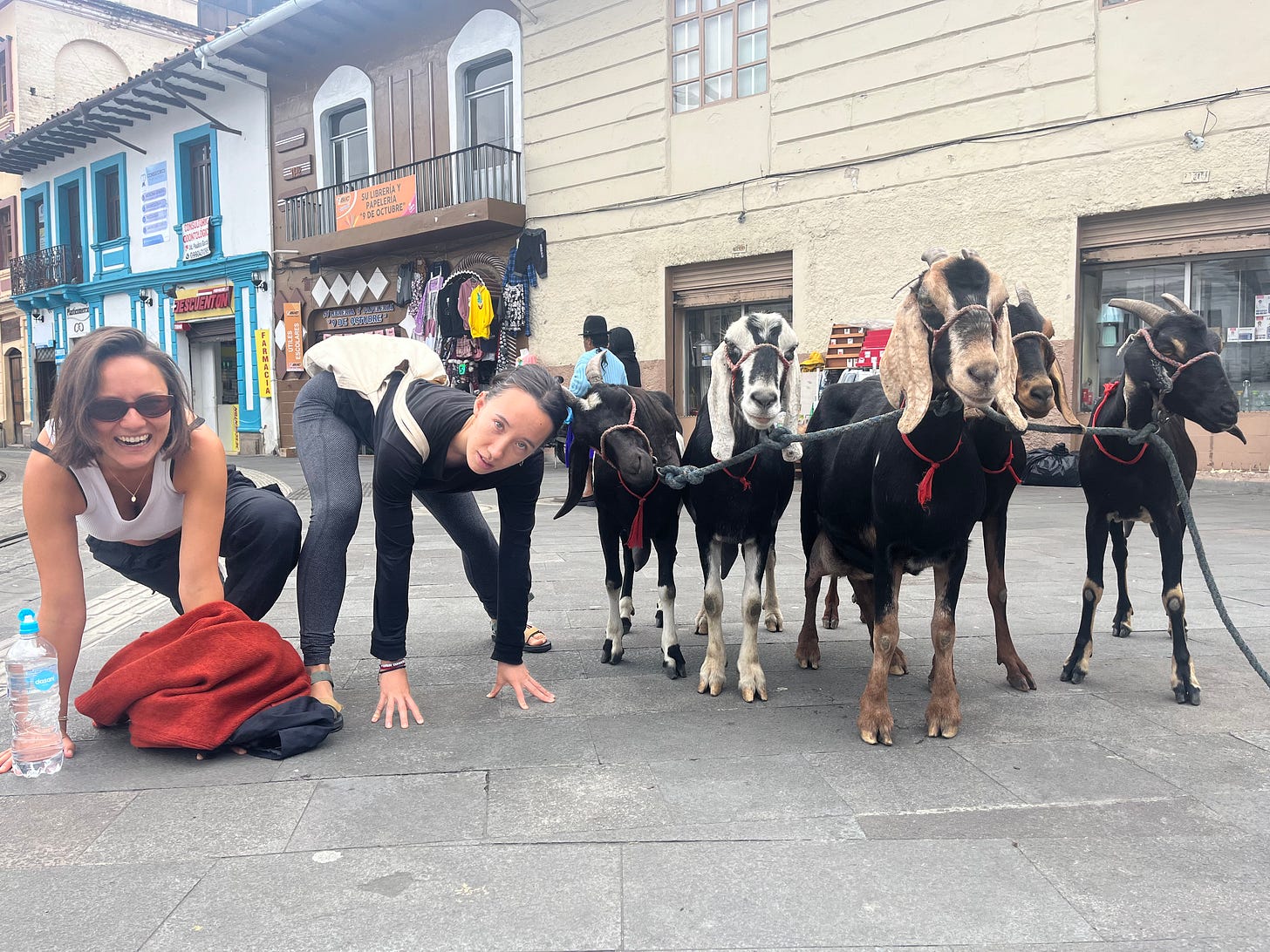
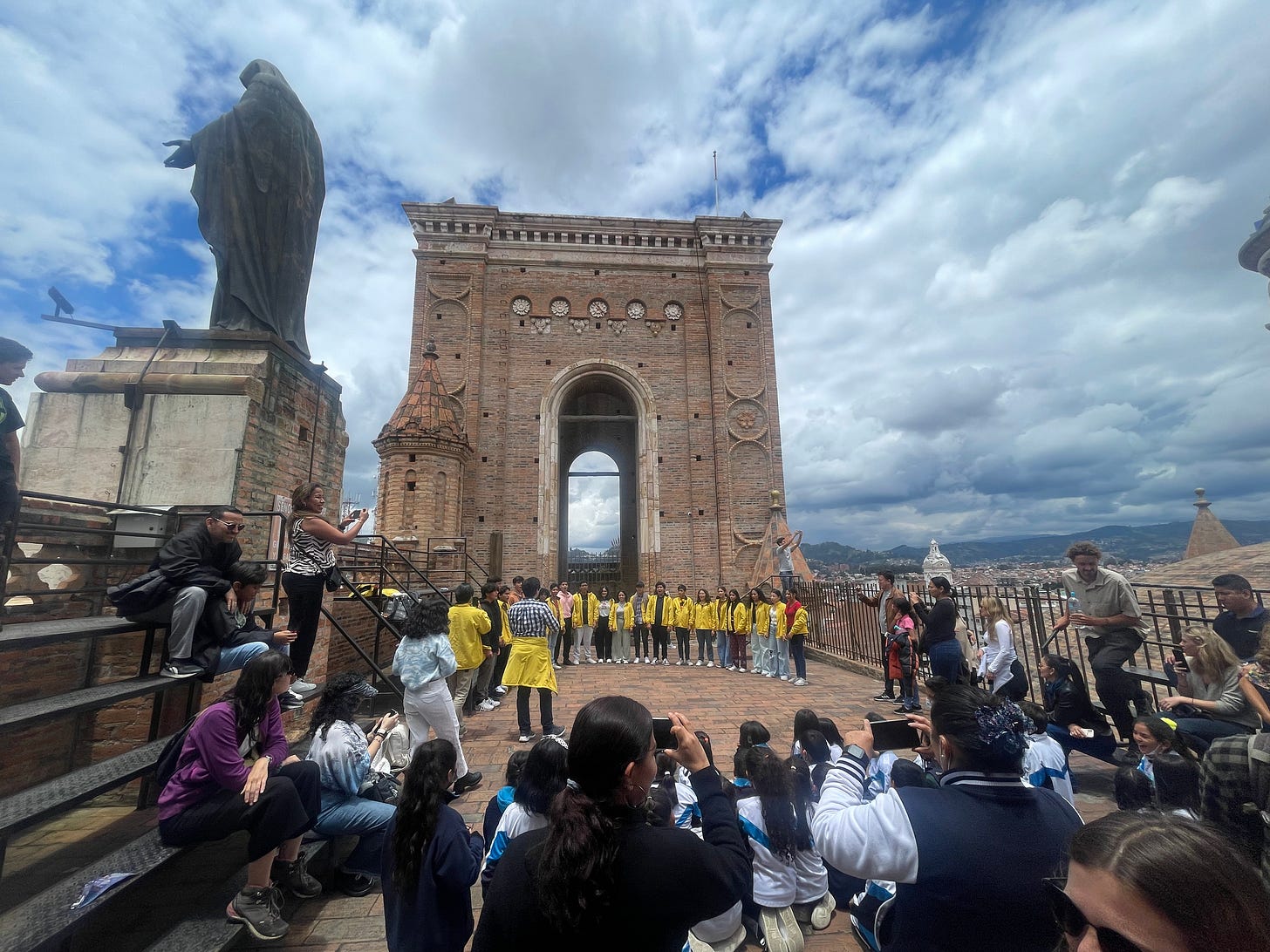
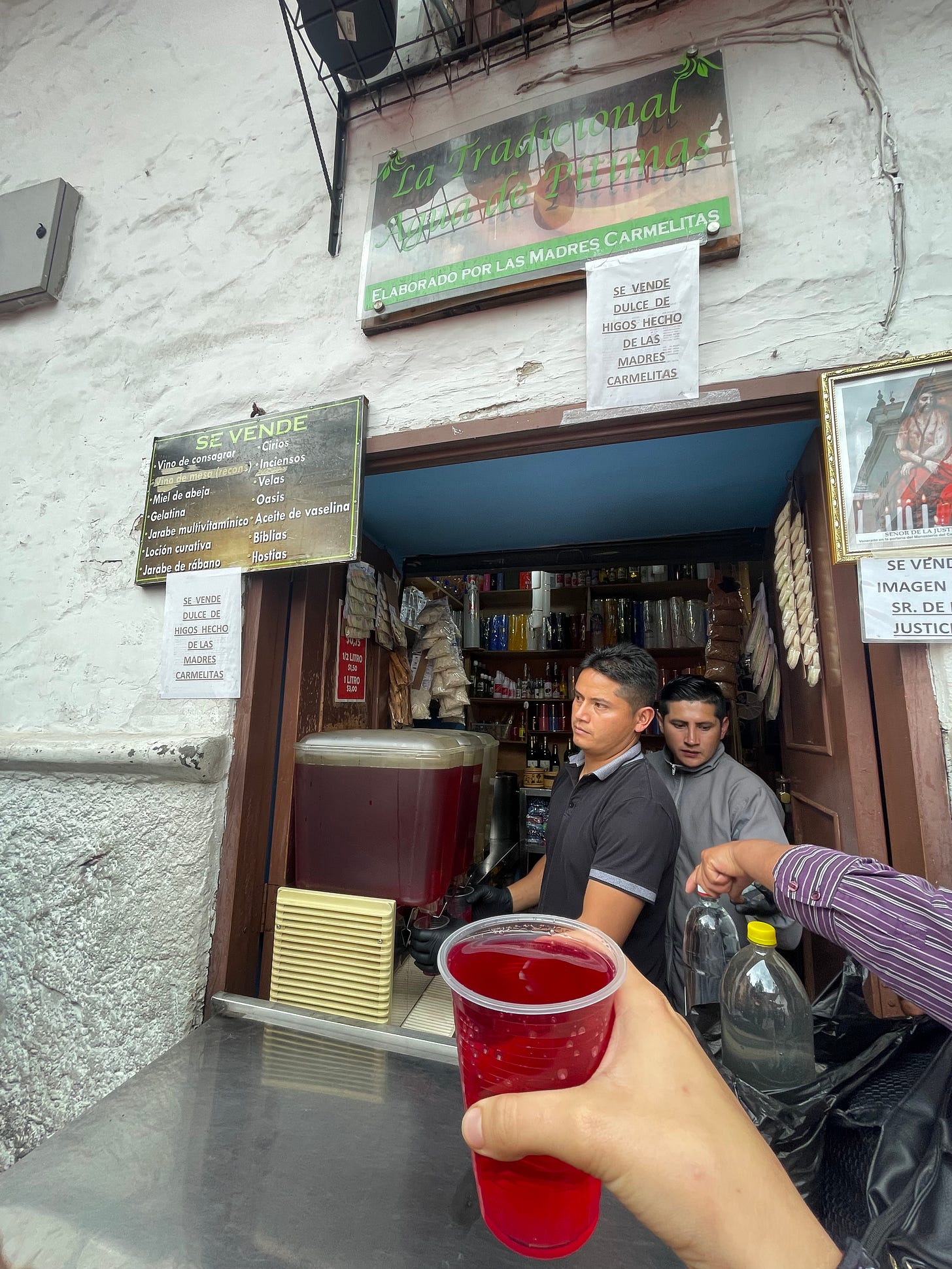
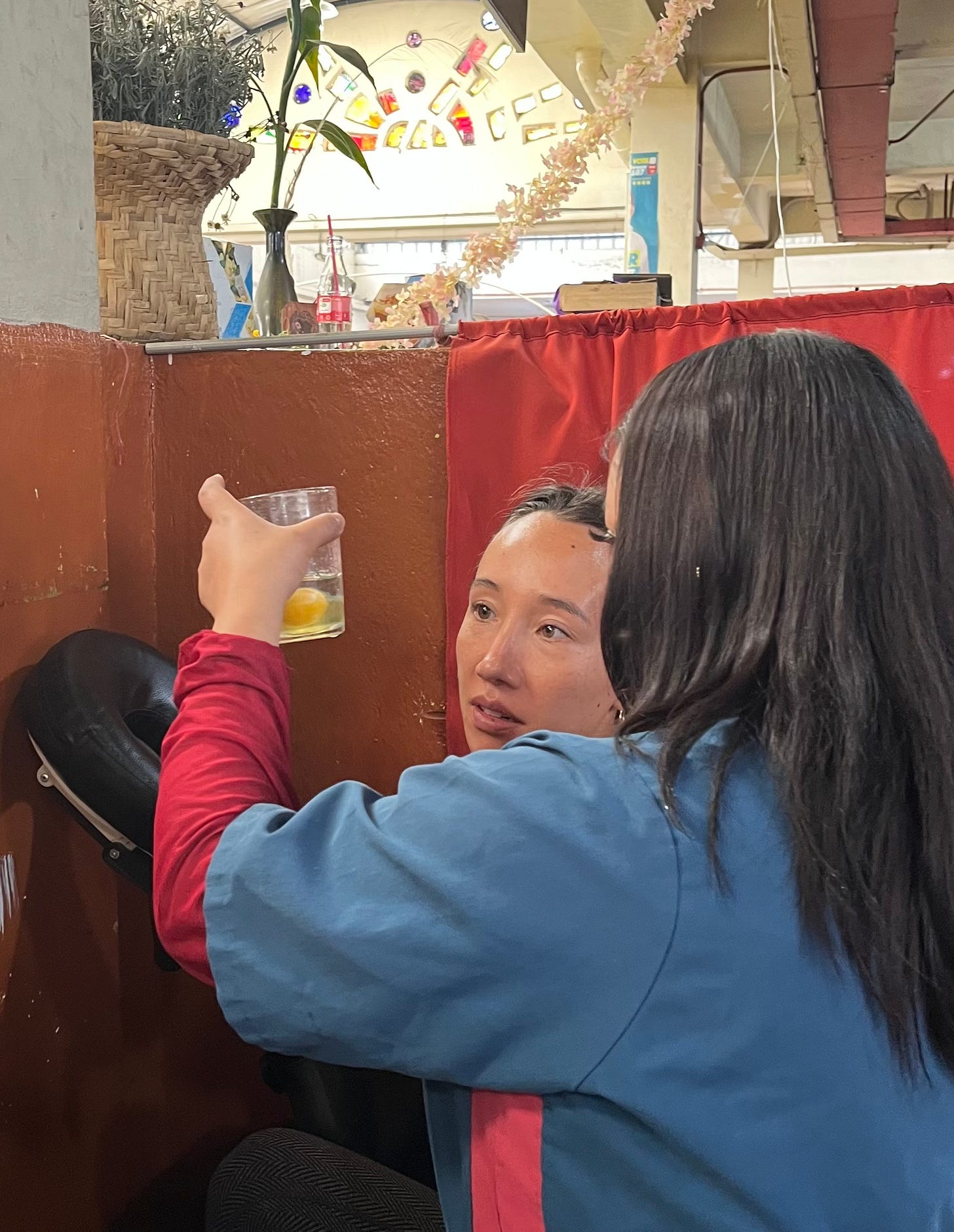


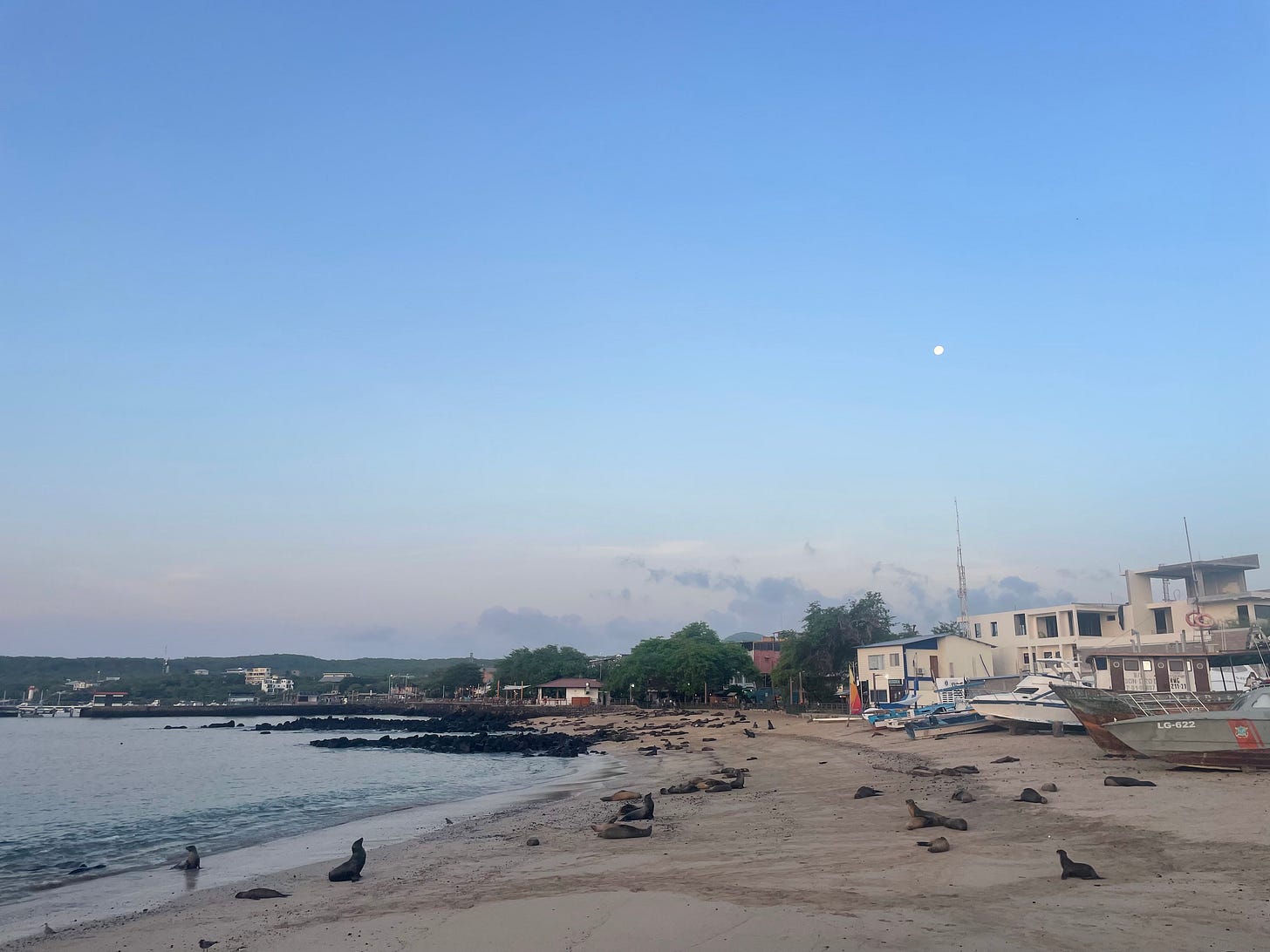

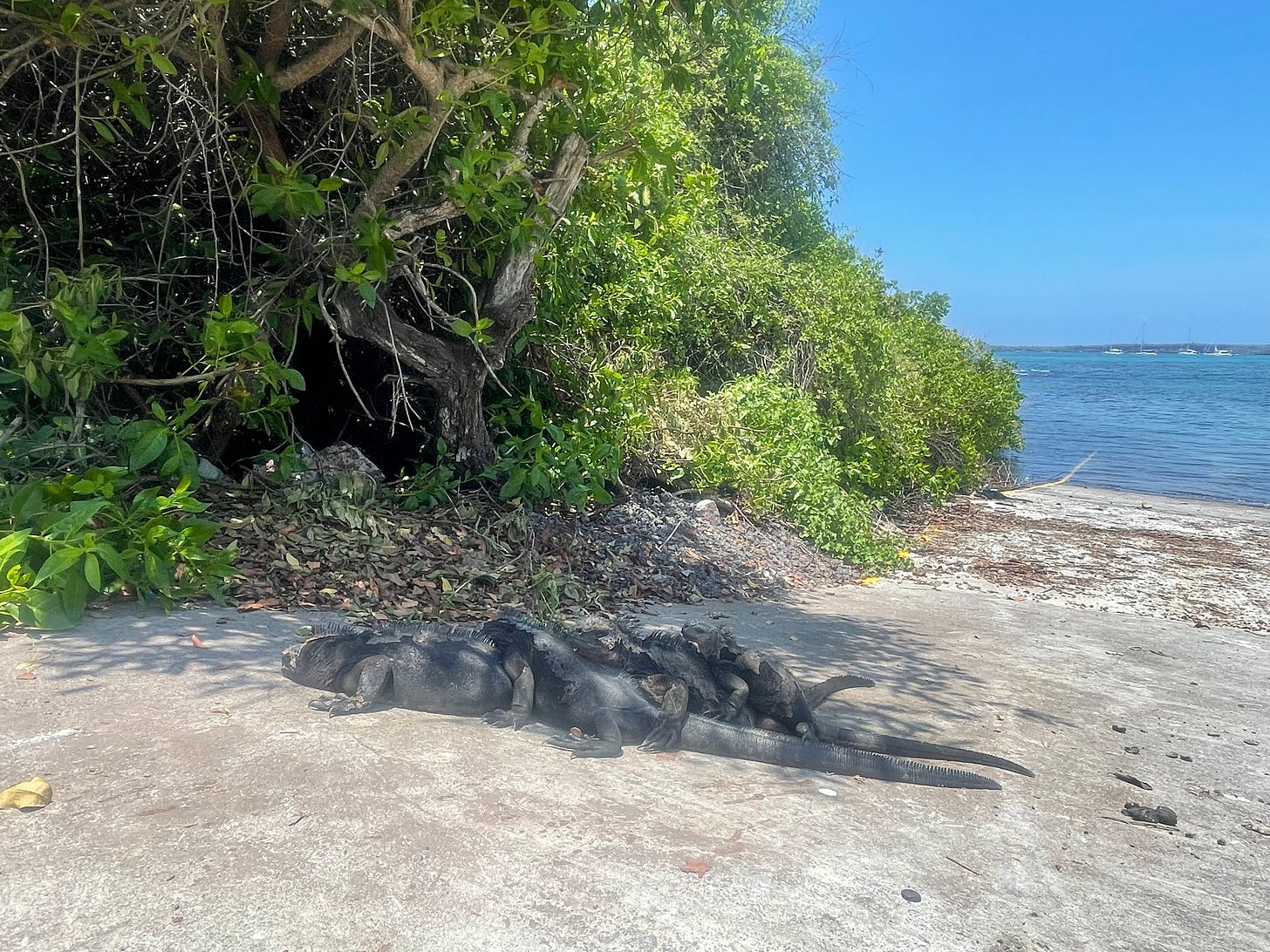

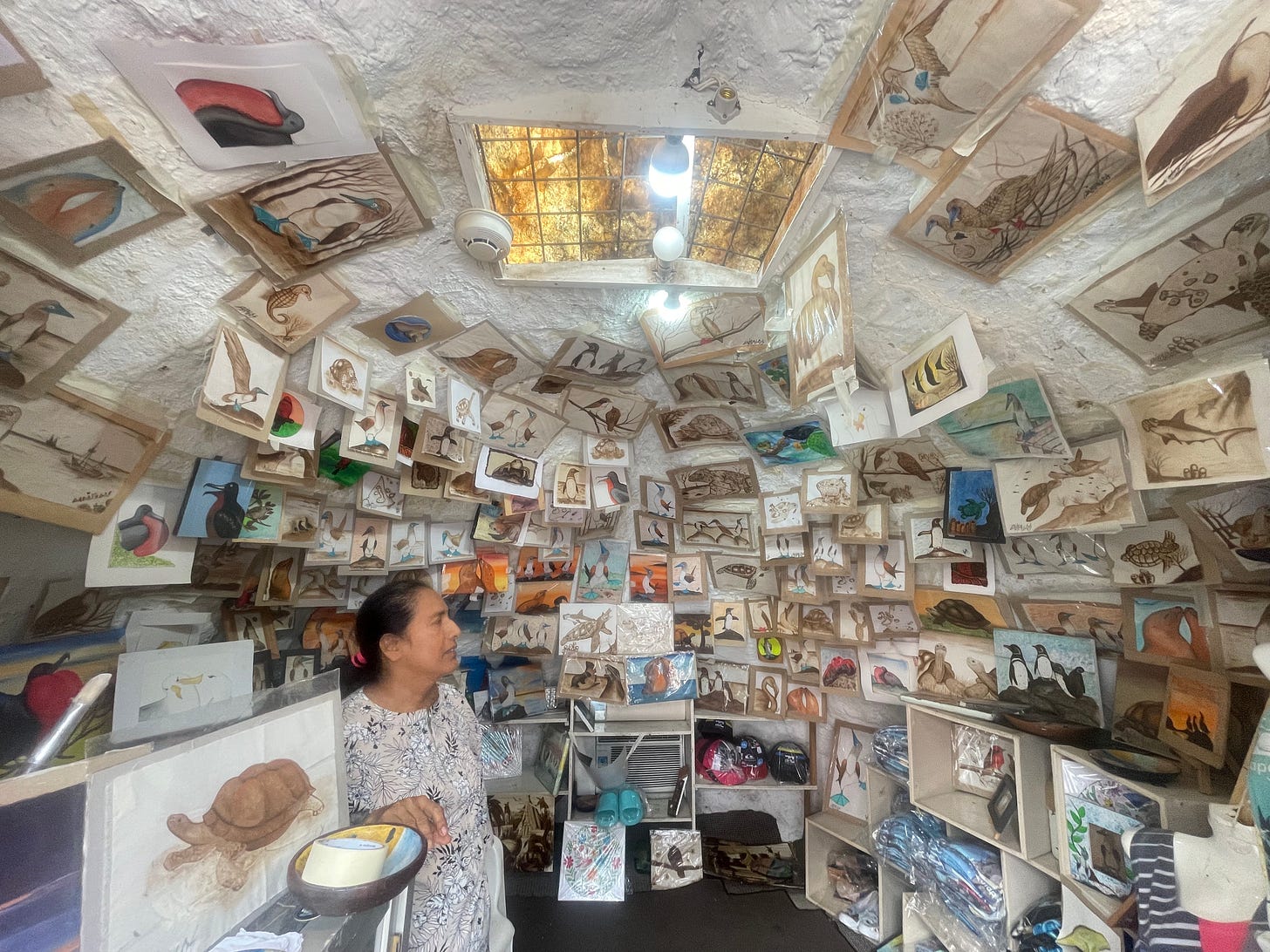
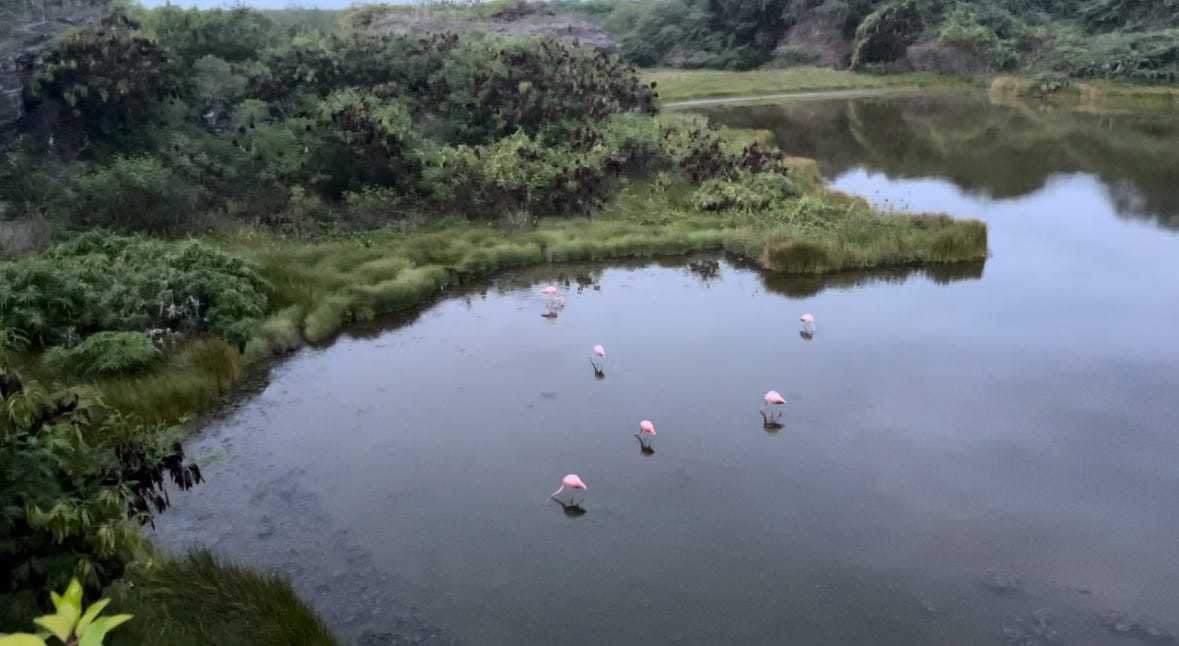
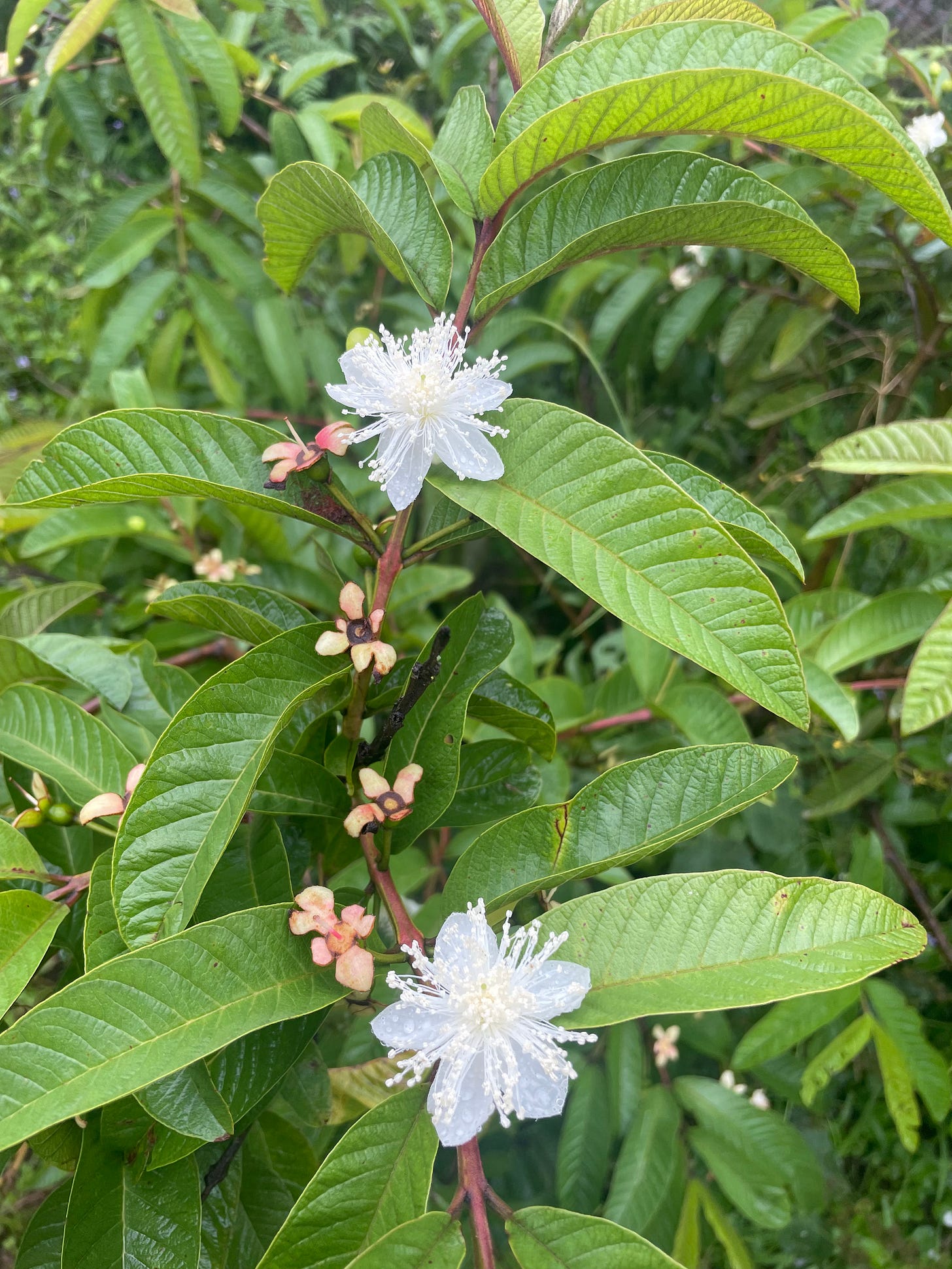
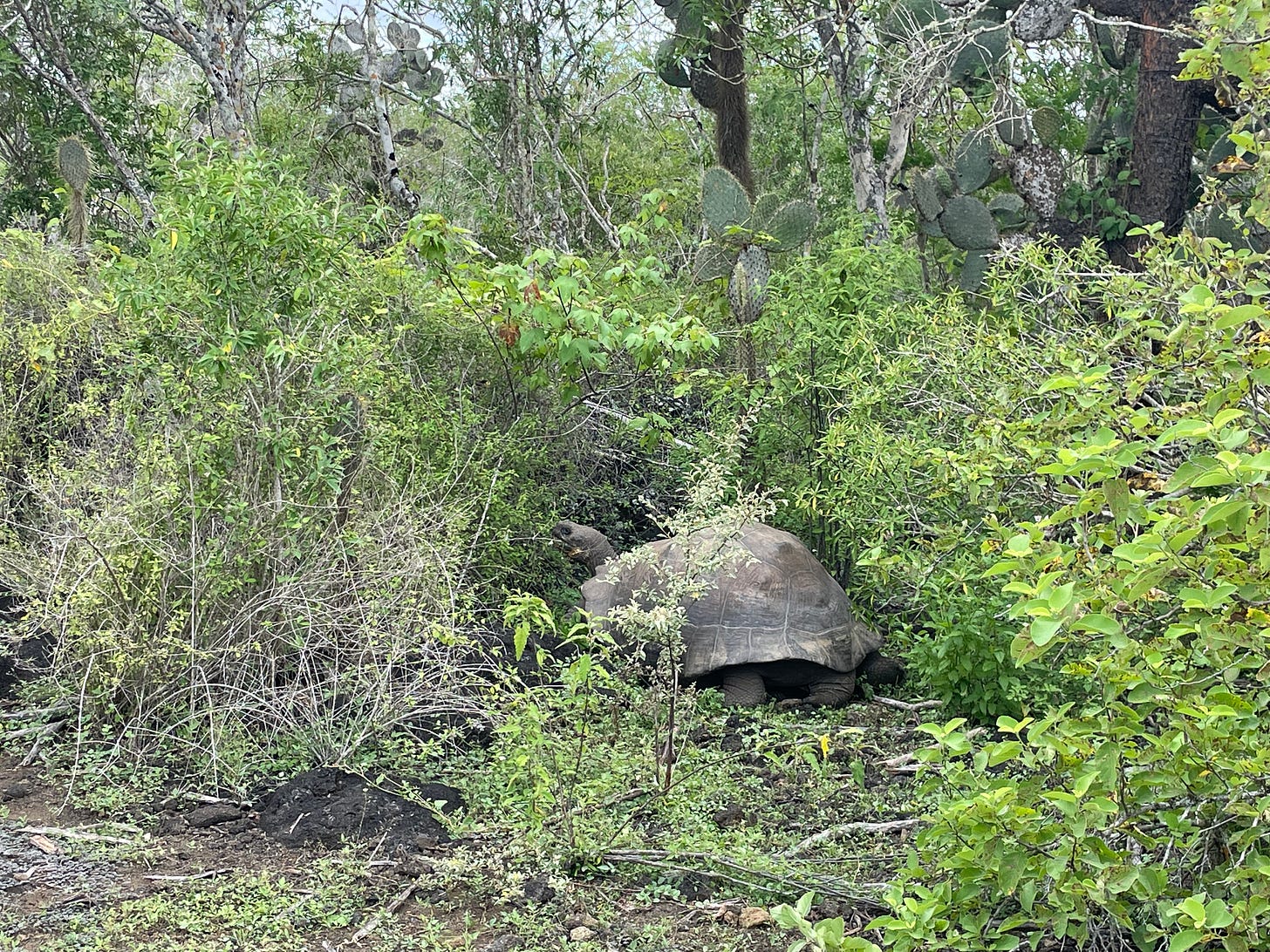
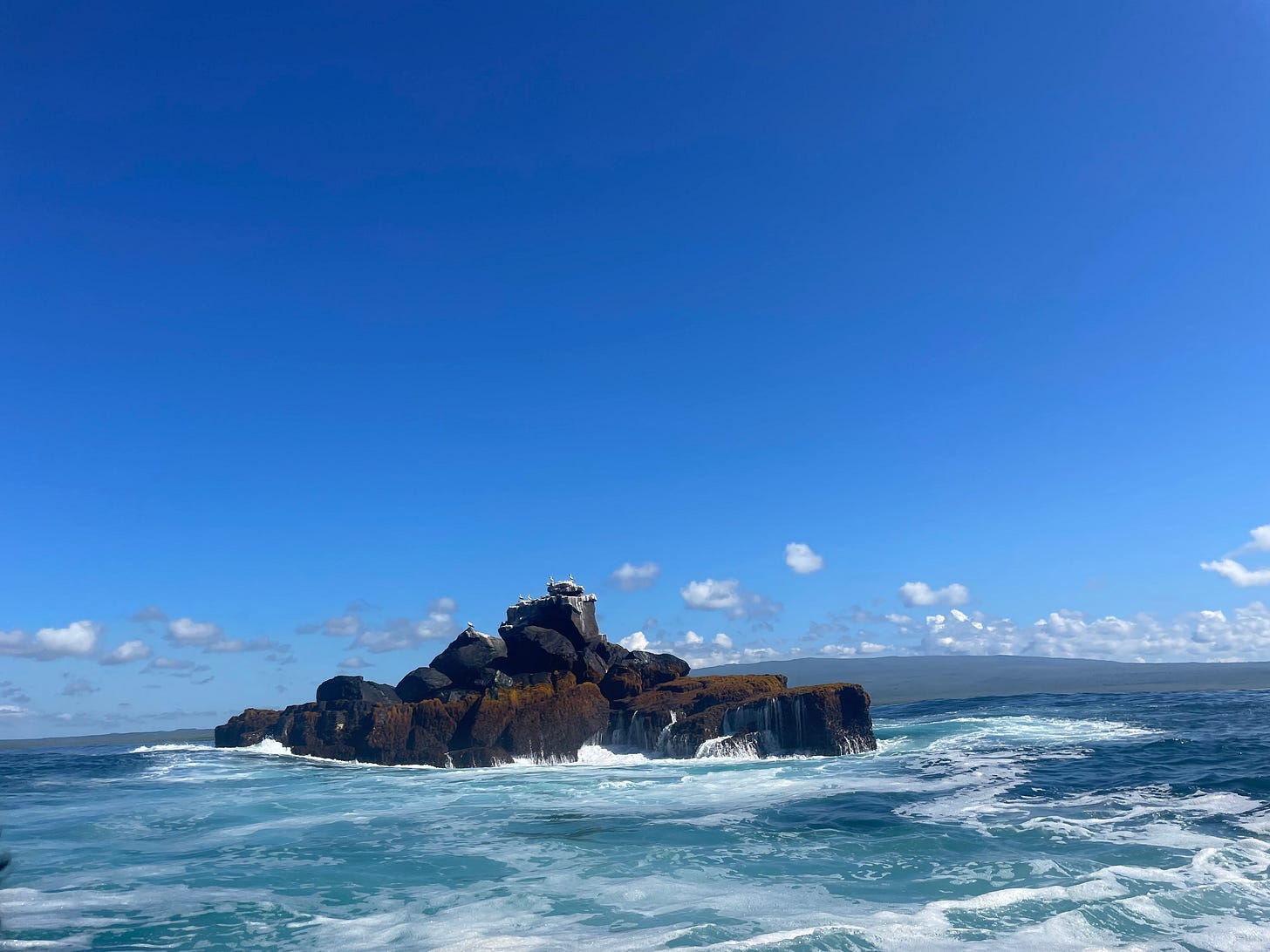
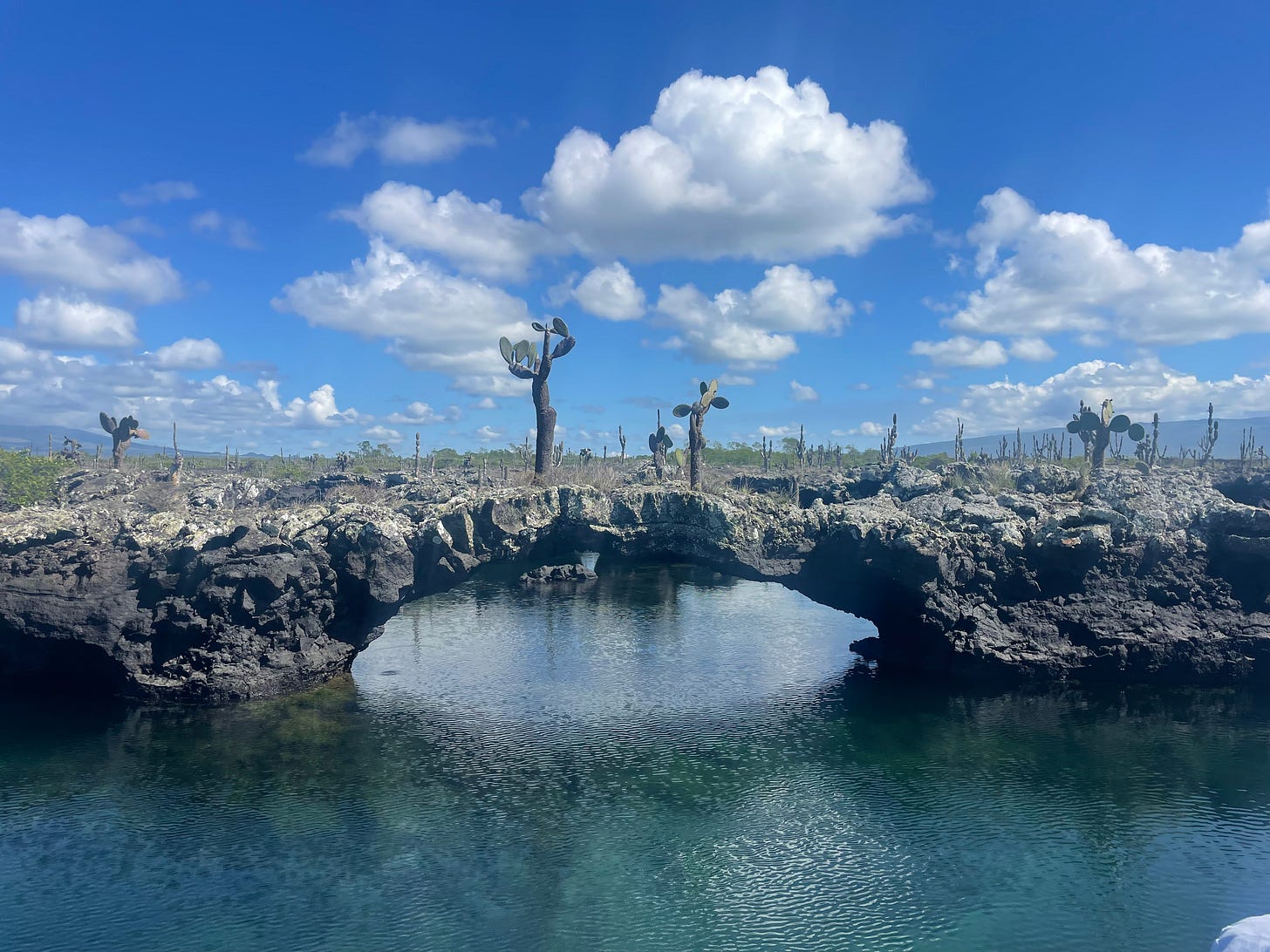
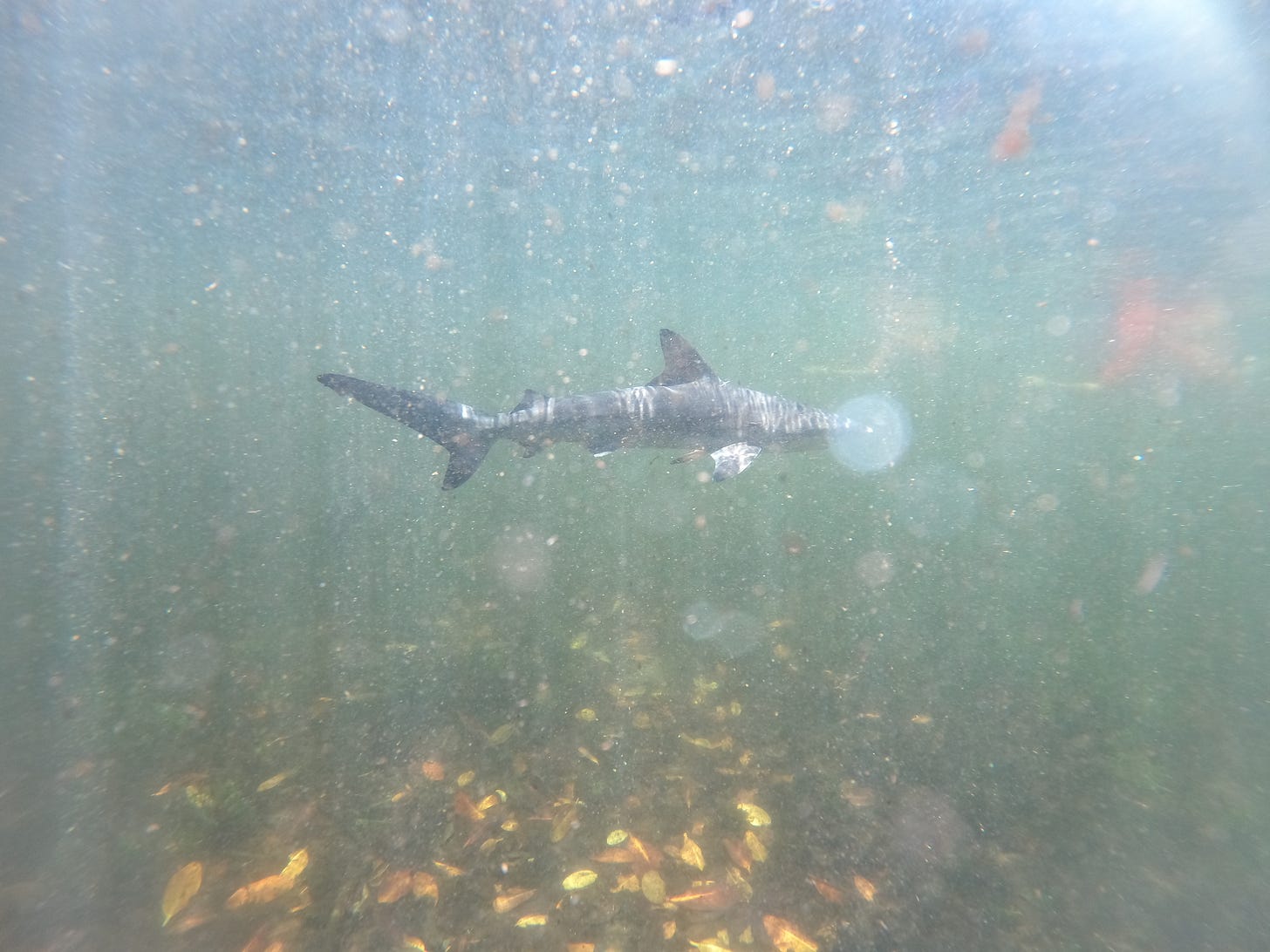
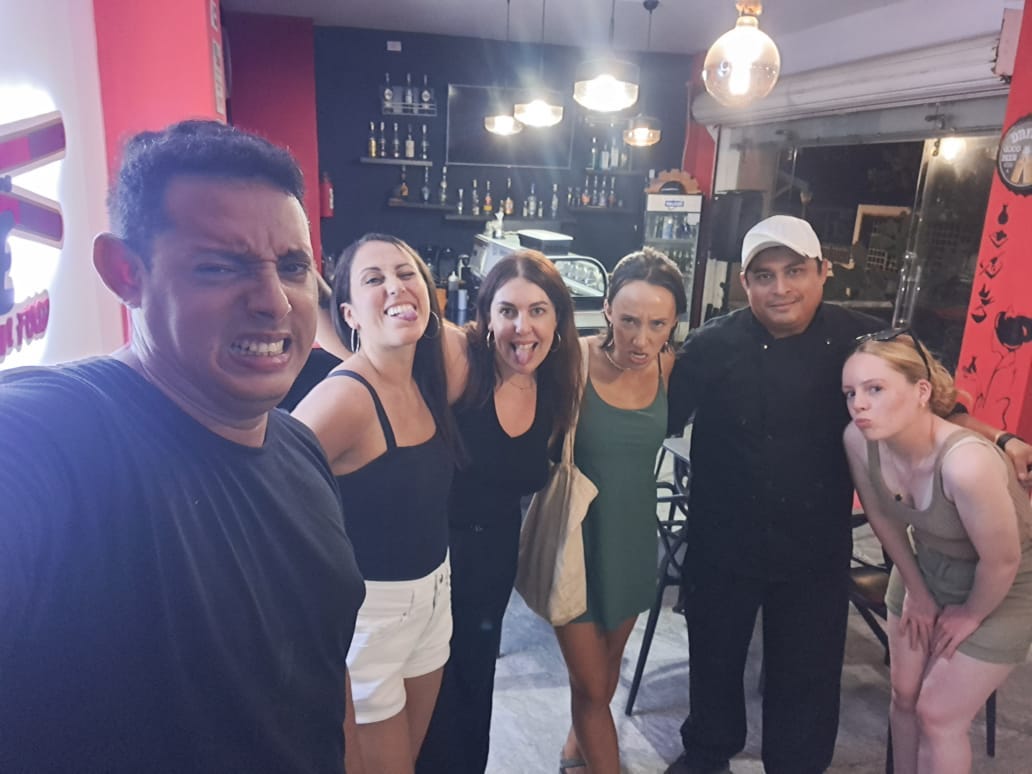
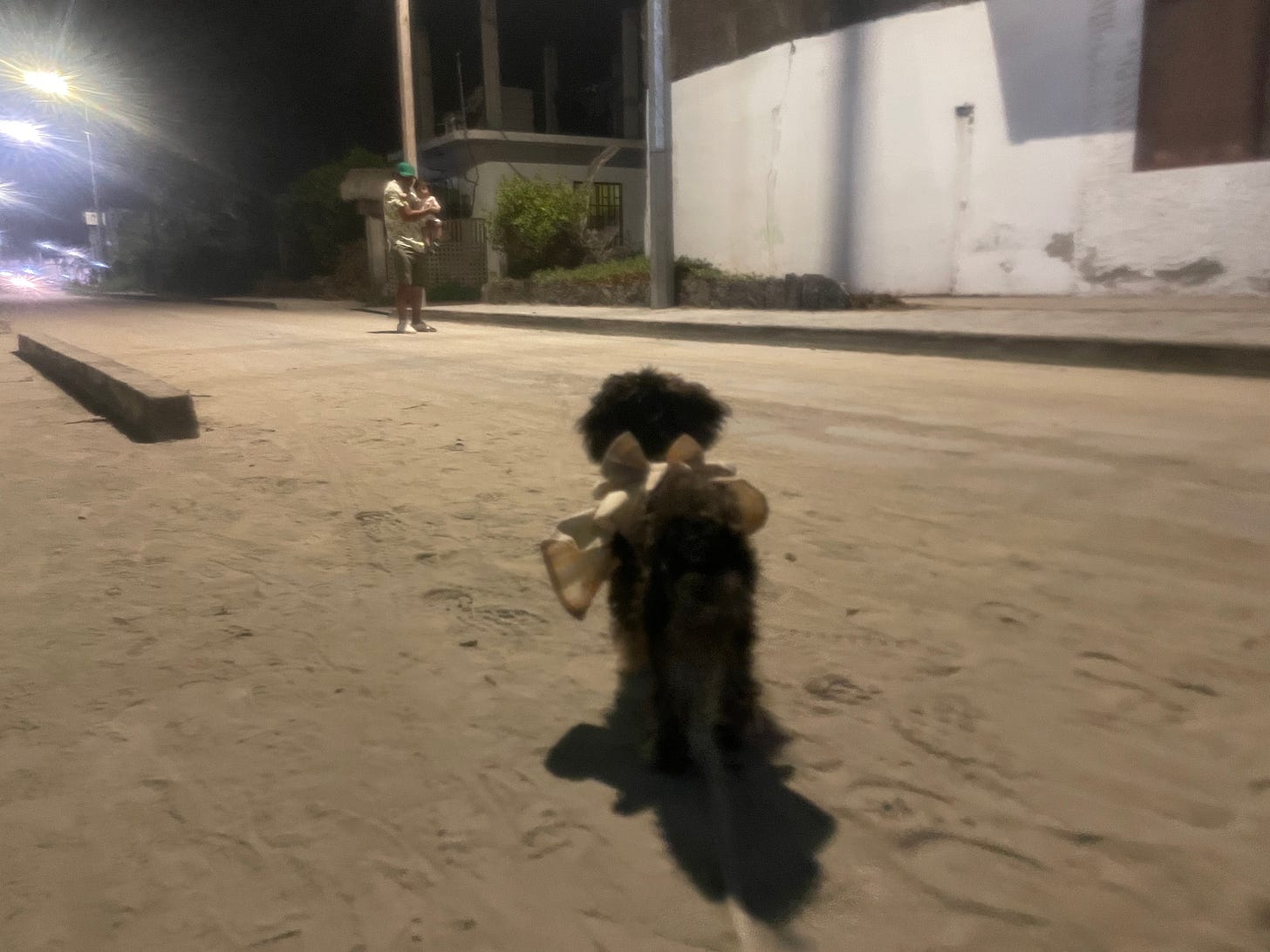
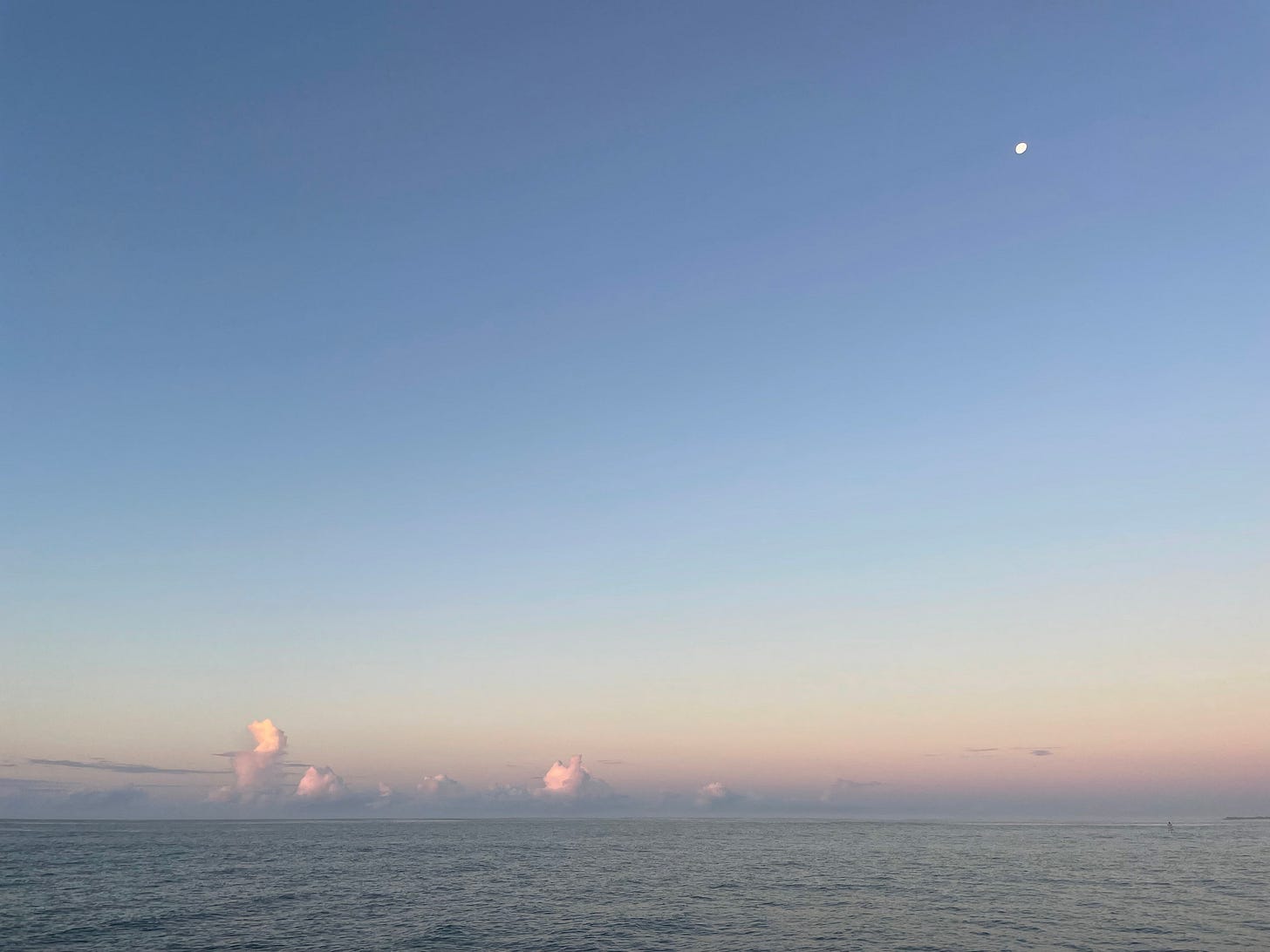
a dream